All Exams >
GMAT >
Data Insights for GMAT >
All Questions
All questions of Data Insights Sectional Tests for GMAT Exam
Linda has the choice to buy raw materials from one of two vendors. Vendor X offers a 5% bulk order discount but includes a handling fee with each purchase. Vendor Y doesn't offer a discount but doesn't charge any additional fees. The handling fee Vendor X charges is $10 for orders under $250, $20 for orders from $250 to $600, and $25 for orders above $600. Linda calculates that for very small orders, Vendor Y is more cost-effective, but she suspects that for larger orders, Vendor X might be cheaper.
I. Determine the smallest value of an order from Vendor Y for which an identical order from Vendor X would be less expensive.
II. If an order costs $500 from Vendor Y, how much would the same order cost from Vendor X?- a)$500, $475
- b)$400, $485
- c)$210, $475
- d)$400, $380
- e)$210, $200
Correct answer is option 'D'. Can you explain this answer?
Linda has the choice to buy raw materials from one of two vendors. Vendor X offers a 5% bulk order discount but includes a handling fee with each purchase. Vendor Y doesn't offer a discount but doesn't charge any additional fees. The handling fee Vendor X charges is $10 for orders under $250, $20 for orders from $250 to $600, and $25 for orders above $600. Linda calculates that for very small orders, Vendor Y is more cost-effective, but she suspects that for larger orders, Vendor X might be cheaper.
I. Determine the smallest value of an order from Vendor Y for which an identical order from Vendor X would be less expensive.
II. If an order costs $500 from Vendor Y, how much would the same order cost from Vendor X?
I. Determine the smallest value of an order from Vendor Y for which an identical order from Vendor X would be less expensive.
II. If an order costs $500 from Vendor Y, how much would the same order cost from Vendor X?
a)
$500, $475
b)
$400, $485
c)
$210, $475
d)
$400, $380
e)
$210, $200

|
Pranav Das answered |
Analysis:
Vendor X offers a 5% bulk order discount but charges a handling fee, while Vendor Y does not offer a discount but does not charge any additional fees.
I. Smallest Value of an Order:
To determine the smallest value of an order from Vendor Y for which an identical order from Vendor X would be less expensive, we need to calculate the crossover point where the total cost from each vendor is the same.
II. Calculation for a $500 Order:
For an order costing $500 from Vendor Y:
- Vendor X's cost would be $500 - 5% discount + handling fee
- Cost of order from Vendor X = $500 - 5% of $500 + handling fee
To find the exact crossover point where Vendor X becomes cheaper than Vendor Y, we need to compare the total cost for both vendors at different order values.
Calculation:
- For orders under $250, Vendor Y is cheaper
- For orders from $250 to $600, we need to find the exact crossover point
- For orders above $600, Vendor X is cheaper
Answer Explanation:
- The correct answer is option D: $400 from Vendor Y would cost $380 from Vendor X.
- For an order of $500, Vendor X would not be cheaper than Vendor Y.
- By comparing the costs at different order values, we find that the crossover point is at $400, where Vendor X becomes cheaper than Vendor Y.
Vendor X offers a 5% bulk order discount but charges a handling fee, while Vendor Y does not offer a discount but does not charge any additional fees.
I. Smallest Value of an Order:
To determine the smallest value of an order from Vendor Y for which an identical order from Vendor X would be less expensive, we need to calculate the crossover point where the total cost from each vendor is the same.
II. Calculation for a $500 Order:
For an order costing $500 from Vendor Y:
- Vendor X's cost would be $500 - 5% discount + handling fee
- Cost of order from Vendor X = $500 - 5% of $500 + handling fee
To find the exact crossover point where Vendor X becomes cheaper than Vendor Y, we need to compare the total cost for both vendors at different order values.
Calculation:
- For orders under $250, Vendor Y is cheaper
- For orders from $250 to $600, we need to find the exact crossover point
- For orders above $600, Vendor X is cheaper
Answer Explanation:
- The correct answer is option D: $400 from Vendor Y would cost $380 from Vendor X.
- For an order of $500, Vendor X would not be cheaper than Vendor Y.
- By comparing the costs at different order values, we find that the crossover point is at $400, where Vendor X becomes cheaper than Vendor Y.
Article 1
From a local Southern California newspaper.
Typically, fewer people vote in local elections that in national ones, but participation can vary widely by state. A new poll has found that more people in California vote in local elections than do people in Nevada, Arizona, and New Mexico combined. This has been attributed to the high number of independent voters in our state, as well as the high enthusiasm for local elections. City councilman Brad Zellman was pleased to see such a high turnout at the recent city council election. “It’s a unique opportunity for local citizens’ votes to carry more weight than they would in big national elections, and it’s great to have so much participation in these smaller campaigns state-wide.”
Article 2
Editorial from the Opinion section of a competing newspaper.
The recent city council election has seen many a politico claim that the increased voter turnout is due to local citizens wanting to be a part of an election where their vote is proportionally more important. However, it is incorrect to suggest that voting in local elections somehow means your vote “counts more.” True, local politicians make decisions that affect day-to-day operations of our cities, but national politicians make decisions that ultimately affect the outcomes of our lives. When you vote for national figures in larger elections, your vote matters more because you are voting for people who will ultimately have a bigger impact on your life long-term.
Article 3
Results from recent California elections.
City councilman elections: 13,000 local votes cast (22% of the eligible population voted), 80% of citizens who voted were polled as “extremely satisfied” with the results. District representative elections: 1.9 million votes cast (19% of the eligible population voted), 67% of citizens who voted were polled as “extremely satisfied” with the results.Consider each of the following statements. Does the information in the articles support the inference as stated?
Californians are more concerned with politics than are people in Nevada, Arizona, and New Mexico.
The “weight” Zellman describes refers to the scale of political decision-making.
- a)Yes, Yes
- b)No, No
- c)Yes, No
- d)No, Yes
- e)Cannot be determined
Correct answer is option 'B'. Can you explain this answer?
Article 1
From a local Southern California newspaper.
Typically, fewer people vote in local elections that in national ones, but participation can vary widely by state. A new poll has found that more people in California vote in local elections than do people in Nevada, Arizona, and New Mexico combined. This has been attributed to the high number of independent voters in our state, as well as the high enthusiasm for local elections. City councilman Brad Zellman was pleased to see such a high turnout at the recent city council election. “It’s a unique opportunity for local citizens’ votes to carry more weight than they would in big national elections, and it’s great to have so much participation in these smaller campaigns state-wide.”
Article 2
Editorial from the Opinion section of a competing newspaper.
The recent city council election has seen many a politico claim that the increased voter turnout is due to local citizens wanting to be a part of an election where their vote is proportionally more important. However, it is incorrect to suggest that voting in local elections somehow means your vote “counts more.” True, local politicians make decisions that affect day-to-day operations of our cities, but national politicians make decisions that ultimately affect the outcomes of our lives. When you vote for national figures in larger elections, your vote matters more because you are voting for people who will ultimately have a bigger impact on your life long-term.
Article 3
Results from recent California elections.
City councilman elections: 13,000 local votes cast (22% of the eligible population voted), 80% of citizens who voted were polled as “extremely satisfied” with the results. District representative elections: 1.9 million votes cast (19% of the eligible population voted), 67% of citizens who voted were polled as “extremely satisfied” with the results.
From a local Southern California newspaper.
Typically, fewer people vote in local elections that in national ones, but participation can vary widely by state. A new poll has found that more people in California vote in local elections than do people in Nevada, Arizona, and New Mexico combined. This has been attributed to the high number of independent voters in our state, as well as the high enthusiasm for local elections. City councilman Brad Zellman was pleased to see such a high turnout at the recent city council election. “It’s a unique opportunity for local citizens’ votes to carry more weight than they would in big national elections, and it’s great to have so much participation in these smaller campaigns state-wide.”
Article 2
Editorial from the Opinion section of a competing newspaper.
The recent city council election has seen many a politico claim that the increased voter turnout is due to local citizens wanting to be a part of an election where their vote is proportionally more important. However, it is incorrect to suggest that voting in local elections somehow means your vote “counts more.” True, local politicians make decisions that affect day-to-day operations of our cities, but national politicians make decisions that ultimately affect the outcomes of our lives. When you vote for national figures in larger elections, your vote matters more because you are voting for people who will ultimately have a bigger impact on your life long-term.
Article 3
Results from recent California elections.
City councilman elections: 13,000 local votes cast (22% of the eligible population voted), 80% of citizens who voted were polled as “extremely satisfied” with the results. District representative elections: 1.9 million votes cast (19% of the eligible population voted), 67% of citizens who voted were polled as “extremely satisfied” with the results.
Consider each of the following statements. Does the information in the articles support the inference as stated?
Californians are more concerned with politics than are people in Nevada, Arizona, and New Mexico.
The “weight” Zellman describes refers to the scale of political decision-making.
Californians are more concerned with politics than are people in Nevada, Arizona, and New Mexico.
The “weight” Zellman describes refers to the scale of political decision-making.
a)
Yes, Yes
b)
No, No
c)
Yes, No
d)
No, Yes
e)
Cannot be determined

|
EduRev GMAT answered |
Question 1 Explanation: The answer is No. This argument assumes that the percentage of people who vote in California is higher than the percentage of people who vote in the other three states put together, based on the fact that the number of people who vote is greater in California. We cannot infer anything about the percentage of people who vote based only on actual numbers of people who vote.
Question 2 Explanation: The answer is No. Zellman likely means that your vote carries “more weight” in local elections since “typically fewer people vote in local elections” according to Article 1. This is further established by Article 2, which begins with a refutation of Zellman and the idea that a vote in a local election “counts more.”
Question 2 Explanation: The answer is No. Zellman likely means that your vote carries “more weight” in local elections since “typically fewer people vote in local elections” according to Article 1. This is further established by Article 2, which begins with a refutation of Zellman and the idea that a vote in a local election “counts more.”
A shopper bought a tie and a belt during a sale. Which item did he buy at the greater dollar value?(1) He bought the tie at a 20 percent discount.
(2) He bought the belt at a 25 percent discount- a)Statement (1) ALONE is sufficient, but statement (2) alone is not sufficient to answer the question asked.
- b)Statement (2) ALONE is sufficient, but statement (1) alone is not sufficient to answer the question asked.
- c)BOTH statements (1) and (2) TOGETHER are sufficient to answer the question asked, but NEITHER statement ALONE is sufficient to answer the question ask
- d)EACH statement ALONE is sufficient to answer the question asked.
- e)Statements (1) and (2) TOGETHER are NOT sufficient to answer the question asked, and additional data specific to the problem are needed.
Correct answer is option 'E'. Can you explain this answer?
A shopper bought a tie and a belt during a sale. Which item did he buy at the greater dollar value?
(1) He bought the tie at a 20 percent discount.
(2) He bought the belt at a 25 percent discount
(2) He bought the belt at a 25 percent discount
a)
Statement (1) ALONE is sufficient, but statement (2) alone is not sufficient to answer the question asked.
b)
Statement (2) ALONE is sufficient, but statement (1) alone is not sufficient to answer the question asked.
c)
BOTH statements (1) and (2) TOGETHER are sufficient to answer the question asked, but NEITHER statement ALONE is sufficient to answer the question ask
d)
EACH statement ALONE is sufficient to answer the question asked.
e)
Statements (1) and (2) TOGETHER are NOT sufficient to answer the question asked, and additional data specific to the problem are needed.

|
EduRev GMAT answered |
We need comparison b/w tie and belt original price to deduce which one greater after discount
(1) discount rate of tie doesn't help us in finding original price. Hence insufficient
(2) discount rate of belt doesn't help us in finding original price. Hence insufficient
(1) discount rate of tie doesn't help us in finding original price. Hence insufficient
(2) discount rate of belt doesn't help us in finding original price. Hence insufficient
(1)+(2) together don't tell us anything about original prices. Hence insufficient
The number of cats in Libby’s house is twice the number of dogs and one third the number of fish. If cats, dogs and fish are the only pets in Libby’s house, what is the probability of randomly selecting two cats?(1) The number of cats in Libby’s house is 12.
(2) The total number of pets in Libby’s house is 54.- a)Statement (1) ALONE is sufficient, but statement (2) alone is not sufficient to answer the question asked.
- b)Statement (2) ALONE is sufficient, but statement (1) alone is not sufficient to answer the question asked.
- c)BOTH statements (1) and (2) TOGETHER are sufficient to answer the question asked, but NEITHER statement ALONE is sufficient to answer the question ask
- d)EACH statement ALONE is sufficient to answer the question asked.
- e)Statements (1) and (2) TOGETHER are NOT sufficient to answer the question asked, and additional data specific to the problem are needed.
Correct answer is option 'D'. Can you explain this answer?
The number of cats in Libby’s house is twice the number of dogs and one third the number of fish. If cats, dogs and fish are the only pets in Libby’s house, what is the probability of randomly selecting two cats?
(1) The number of cats in Libby’s house is 12.
(2) The total number of pets in Libby’s house is 54.
(2) The total number of pets in Libby’s house is 54.
a)
Statement (1) ALONE is sufficient, but statement (2) alone is not sufficient to answer the question asked.
b)
Statement (2) ALONE is sufficient, but statement (1) alone is not sufficient to answer the question asked.
c)
BOTH statements (1) and (2) TOGETHER are sufficient to answer the question asked, but NEITHER statement ALONE is sufficient to answer the question ask
d)
EACH statement ALONE is sufficient to answer the question asked.
e)
Statements (1) and (2) TOGETHER are NOT sufficient to answer the question asked, and additional data specific to the problem are needed.

|
Chirag Roy answered |
Statement 1: The number of cats in Libby’s house is 12.
- Since the number of cats is given, we can determine the total number of pets in Libby's house.
- However, we still don't have information about the number of dogs and fish to calculate the probability of randomly selecting two cats.
Statement 2: The total number of pets in Libby’s house is 54.
- With this statement alone, we can determine the total number of cats, dogs, and fish in Libby's house.
- But we still don't have specific numbers for each type of pet to calculate the probability of randomly selecting two cats.
Both Statements Together:
- By combining the information from both statements, we know that there are 12 cats and a total of 54 pets in Libby's house.
- From this, we can calculate the number of dogs and fish as well.
- With this complete information, we can determine the probability of randomly selecting two cats from the total number of pets.
- Therefore, both statements together are sufficient to answer the question asked.
Therefore, the correct answer is option 'C' as both statements together are needed to determine the probability of randomly selecting two cats from Libby's house.
- Since the number of cats is given, we can determine the total number of pets in Libby's house.
- However, we still don't have information about the number of dogs and fish to calculate the probability of randomly selecting two cats.
Statement 2: The total number of pets in Libby’s house is 54.
- With this statement alone, we can determine the total number of cats, dogs, and fish in Libby's house.
- But we still don't have specific numbers for each type of pet to calculate the probability of randomly selecting two cats.
Both Statements Together:
- By combining the information from both statements, we know that there are 12 cats and a total of 54 pets in Libby's house.
- From this, we can calculate the number of dogs and fish as well.
- With this complete information, we can determine the probability of randomly selecting two cats from the total number of pets.
- Therefore, both statements together are sufficient to answer the question asked.
Therefore, the correct answer is option 'C' as both statements together are needed to determine the probability of randomly selecting two cats from Libby's house.
Techniques
At a gym there are three different paths an individual can take to obtaining membership. The first option is personal training. The second option is group fitness classes and the last option is individual direction. Members are only allowed to partake in individual direction after 5 personal training sessions and 10 group fitness classes.Personnel
For personal training, there must be one trainer per individual. For group fitness classes there must be one trainer per eight individuals. For individual direction, no trainer is required; however, only 25 members can partake in individual direction at a time. At this particular gym there are 12 trainers.Price
The price of membership depends on the technique the individual chooses. Personal training costs between $40 and $75 per session, depending on the trainer. Group fitness classes cost $20 per session. Individual direction costs $15 per visit.Based on the given information, determine whether each of the statements is justified.
I. An individual who is experienced in fitness and has taken 3 group classes can choose to pay for the individual direction membership.
II. An individual who has a budget of $160 a month to spend on fitness after going through the personal training and group sessions can attend 8 classes per month.
III. Tina has completed all the necessary requirements to have an individual direction membership; Tina would make the 26th member of this type.- a)Justified, Not justified, Not justified
- b)Not justified, Justified, Justified
- c)Justified, Justified, Not justified
- d)Not justified, Justified, Not justified
- e)Justified, Not justified, Justified
Correct answer is option 'D'. Can you explain this answer?
Techniques
At a gym there are three different paths an individual can take to obtaining membership. The first option is personal training. The second option is group fitness classes and the last option is individual direction. Members are only allowed to partake in individual direction after 5 personal training sessions and 10 group fitness classes.
At a gym there are three different paths an individual can take to obtaining membership. The first option is personal training. The second option is group fitness classes and the last option is individual direction. Members are only allowed to partake in individual direction after 5 personal training sessions and 10 group fitness classes.
Personnel
For personal training, there must be one trainer per individual. For group fitness classes there must be one trainer per eight individuals. For individual direction, no trainer is required; however, only 25 members can partake in individual direction at a time. At this particular gym there are 12 trainers.
For personal training, there must be one trainer per individual. For group fitness classes there must be one trainer per eight individuals. For individual direction, no trainer is required; however, only 25 members can partake in individual direction at a time. At this particular gym there are 12 trainers.
Price
The price of membership depends on the technique the individual chooses. Personal training costs between $40 and $75 per session, depending on the trainer. Group fitness classes cost $20 per session. Individual direction costs $15 per visit.
The price of membership depends on the technique the individual chooses. Personal training costs between $40 and $75 per session, depending on the trainer. Group fitness classes cost $20 per session. Individual direction costs $15 per visit.
Based on the given information, determine whether each of the statements is justified.
I. An individual who is experienced in fitness and has taken 3 group classes can choose to pay for the individual direction membership.
II. An individual who has a budget of $160 a month to spend on fitness after going through the personal training and group sessions can attend 8 classes per month.
III. Tina has completed all the necessary requirements to have an individual direction membership; Tina would make the 26th member of this type.
I. An individual who is experienced in fitness and has taken 3 group classes can choose to pay for the individual direction membership.
II. An individual who has a budget of $160 a month to spend on fitness after going through the personal training and group sessions can attend 8 classes per month.
III. Tina has completed all the necessary requirements to have an individual direction membership; Tina would make the 26th member of this type.
a)
Justified, Not justified, Not justified
b)
Not justified, Justified, Justified
c)
Justified, Justified, Not justified
d)
Not justified, Justified, Not justified
e)
Justified, Not justified, Justified

|
EduRev GMAT answered |
I. An individual who is experienced in fitness and has taken 3 group classes can choose to pay for the individual direction membership.
At a gym there are three different paths an individual can take to obtaining membership. The first option is personal training. The second option is group fitness classes and the last option is individual direction. Members are only allowed to partake in individual direct after 5 personal training sessions and 10 group fitness classes.
Therefore, statement I. is not justified.
At a gym there are three different paths an individual can take to obtaining membership. The first option is personal training. The second option is group fitness classes and the last option is individual direction. Members are only allowed to partake in individual direct after 5 personal training sessions and 10 group fitness classes.
Therefore, statement I. is not justified.
II. An individual who has a budget of $160 a month to spend on fitness after going through the personal training and group sessions can attend 8 classes per month.
The price of membership depends on the technique the individual chooses. Personal training costs any where between $40 and $75 per session depending on the trainer. Group fitness classes cost $20 per session and individual direction costs $15 per visit.
8 classes a month×$20=$160
Therefore, statement II. is justified.
The price of membership depends on the technique the individual chooses. Personal training costs any where between $40 and $75 per session depending on the trainer. Group fitness classes cost $20 per session and individual direction costs $15 per visit.
8 classes a month×$20=$160
Therefore, statement II. is justified.
III. Tina has completed all the necessary requirements to have an individual direction membership; Tina would make the 26th member of this type.
For personal training, there must be one trainer per individual. For group fitness classes there must be one trainer per eight individuals. For individual direction, no trainer is required however, only 25 members can part take in individual direction at a time. At this particular gym there are 12 trainers.
Therefore, statement III. is not justified.
For personal training, there must be one trainer per individual. For group fitness classes there must be one trainer per eight individuals. For individual direction, no trainer is required however, only 25 members can part take in individual direction at a time. At this particular gym there are 12 trainers.
Therefore, statement III. is not justified.
The number of people in the world who natively speak Language A is 330 million. The number of people in the world who natively speak Language B is 260 million. Language experts who chart the growth of both languages claim that in five years, the number of persons who natively speak Language A will be approximately 450 million, and the number of persons who natively speak Language B will be approximately 300 million.In the table below, identify the average annual rate of growth of Language A native speakers, and then identify the difference between Language A’s and Language B’s average annual growth rates. Make only two selections, one in each column.
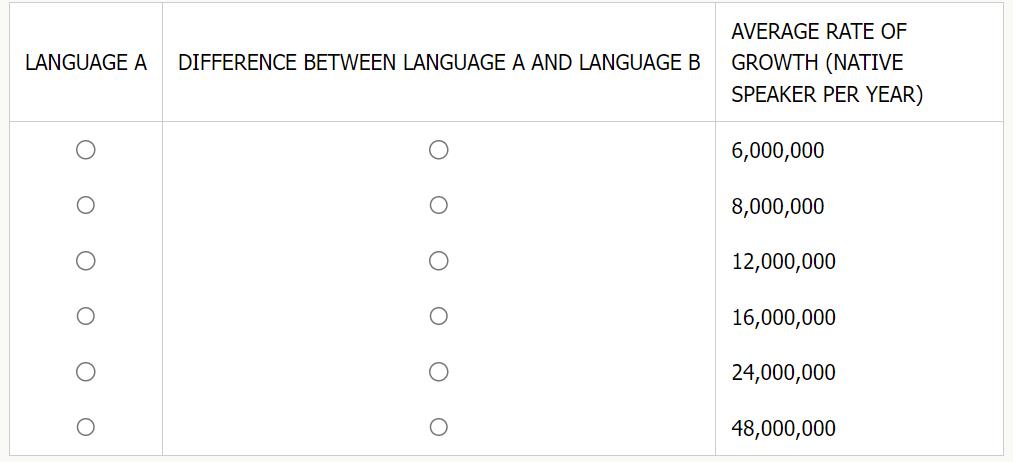 LANGUAGE A: 24,000,000 DIFFERENCE BETWEEN LANGUAGE A AND LANGUAGE B: 16,000,000
LANGUAGE A: 24,000,000 DIFFERENCE BETWEEN LANGUAGE A AND LANGUAGE B: 16,000,000- a)6 million, 8 million
- b)24 million, 8 million
- c)12 million, 48 million
- d)24 million, 16 million
- e)8 million, 24 million
Correct answer is option 'D'. Can you explain this answer?
The number of people in the world who natively speak Language A is 330 million. The number of people in the world who natively speak Language B is 260 million. Language experts who chart the growth of both languages claim that in five years, the number of persons who natively speak Language A will be approximately 450 million, and the number of persons who natively speak Language B will be approximately 300 million.
In the table below, identify the average annual rate of growth of Language A native speakers, and then identify the difference between Language A’s and Language B’s average annual growth rates. Make only two selections, one in each column.

LANGUAGE A: 24,000,000 DIFFERENCE BETWEEN LANGUAGE A AND LANGUAGE B: 16,000,000
a)
6 million, 8 million
b)
24 million, 8 million
c)
12 million, 48 million
d)
24 million, 16 million
e)
8 million, 24 million

|
EduRev GMAT answered |
(A) LANGUAGE A
average annual rate of growth of Language A native speakers = (450 - 330) / 5 = 24 million
average annual rate of growth of Language A native speakers = (450 - 330) / 5 = 24 million
(B) DIFFERENCE BETWEEN LANGUAGE A AND LANGUAGE B
average annual rate of growth of Language A native speakers = (450 - 330) / 5 = 24 million
average annual rate of growth of Language b native speakers = (300 - 260) / 5 = 8 million
HENCE, THE DIFFERENCE = 24 million - 8 million = 16 million
average annual rate of growth of Language A native speakers = (450 - 330) / 5 = 24 million
average annual rate of growth of Language b native speakers = (300 - 260) / 5 = 8 million
HENCE, THE DIFFERENCE = 24 million - 8 million = 16 million
Lyric Poetry
A team of classicists is examining some newly discovered manuscripts of ancient Greek lyric poetry, keeping in mind the following background information: Lyric poetry is a broad term used to describe the poems that were not epics or drama, and which were composed from roughly the 7th century BCE through the middle of the 5th century BCE.
The content of these poems spanned a wide range. While the Greck epics and tragedies dealt almost exclusively with the myths of Greece’s past, lyric poetry, though at times using a mythic background, kept its focus mostly on the present. Stylistically, lyric poetry had a wide variety, as well. Choral songs, such as eulogies, dithyrambs, dirges, and victory odes, were performed by a chorus and an accompanying instrument, usually on public occasions. Solo songs, also accompanied by an instrument, were typically of a more personal nature, with love as their chief subject. Alcaeus’ poetry provided a partial exception as solo songs go, for he also composed songs about politics as well as hymns to the gods.
Besides choral and solo songs, lyric poetry included elegiac and iambic poems, which may or may not have been performed to music. Elegiac poems are defined by meter, and the elegiac couplet, and were usually political or ethical exhortations. Iambic poems were usually polemics, or monologues of a satirical or salacious nature, often, but not always, composed in the iambic meter. Archilochus used iambics and trochaics for his poetry, whereas Hipponax was unique in his use of the choliambic meter.Lyric Poets 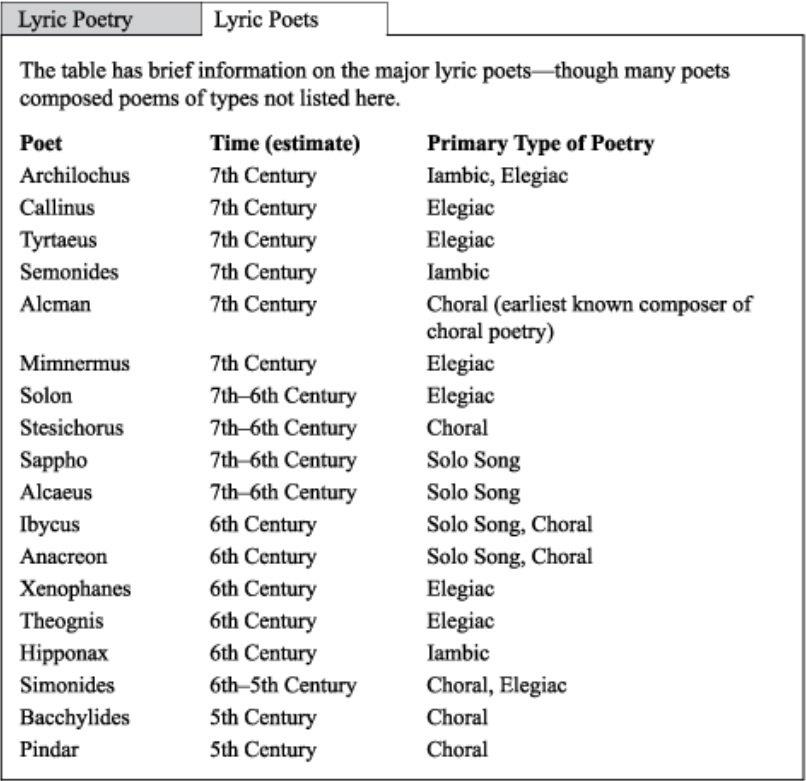 For each of the following statements about the newly discovered manuscripts, select Yes if it can be reasonably inferred from the given information. Otherwise, select No.
For each of the following statements about the newly discovered manuscripts, select Yes if it can be reasonably inferred from the given information. Otherwise, select No.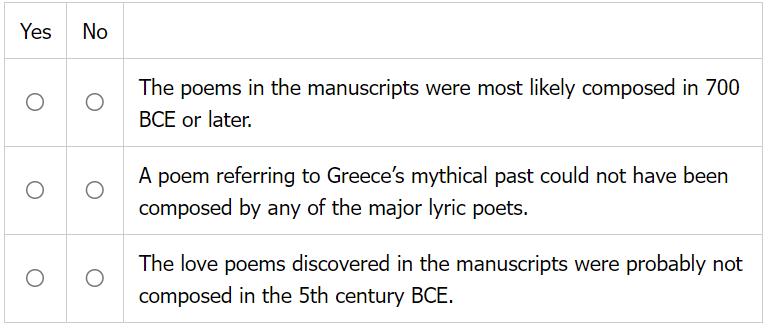
- a)Yes, Yes, Yes
- b) Yes, No, Yes
- c)No, No, No
- d)Yes, No No
- e)No, No, Yes
Correct answer is option 'B'. Can you explain this answer?
Lyric Poetry
A team of classicists is examining some newly discovered manuscripts of ancient Greek lyric poetry, keeping in mind the following background information: Lyric poetry is a broad term used to describe the poems that were not epics or drama, and which were composed from roughly the 7th century BCE through the middle of the 5th century BCE.
The content of these poems spanned a wide range. While the Greck epics and tragedies dealt almost exclusively with the myths of Greece’s past, lyric poetry, though at times using a mythic background, kept its focus mostly on the present. Stylistically, lyric poetry had a wide variety, as well. Choral songs, such as eulogies, dithyrambs, dirges, and victory odes, were performed by a chorus and an accompanying instrument, usually on public occasions. Solo songs, also accompanied by an instrument, were typically of a more personal nature, with love as their chief subject. Alcaeus’ poetry provided a partial exception as solo songs go, for he also composed songs about politics as well as hymns to the gods.
Besides choral and solo songs, lyric poetry included elegiac and iambic poems, which may or may not have been performed to music. Elegiac poems are defined by meter, and the elegiac couplet, and were usually political or ethical exhortations. Iambic poems were usually polemics, or monologues of a satirical or salacious nature, often, but not always, composed in the iambic meter. Archilochus used iambics and trochaics for his poetry, whereas Hipponax was unique in his use of the choliambic meter.
A team of classicists is examining some newly discovered manuscripts of ancient Greek lyric poetry, keeping in mind the following background information: Lyric poetry is a broad term used to describe the poems that were not epics or drama, and which were composed from roughly the 7th century BCE through the middle of the 5th century BCE.
The content of these poems spanned a wide range. While the Greck epics and tragedies dealt almost exclusively with the myths of Greece’s past, lyric poetry, though at times using a mythic background, kept its focus mostly on the present. Stylistically, lyric poetry had a wide variety, as well. Choral songs, such as eulogies, dithyrambs, dirges, and victory odes, were performed by a chorus and an accompanying instrument, usually on public occasions. Solo songs, also accompanied by an instrument, were typically of a more personal nature, with love as their chief subject. Alcaeus’ poetry provided a partial exception as solo songs go, for he also composed songs about politics as well as hymns to the gods.
Besides choral and solo songs, lyric poetry included elegiac and iambic poems, which may or may not have been performed to music. Elegiac poems are defined by meter, and the elegiac couplet, and were usually political or ethical exhortations. Iambic poems were usually polemics, or monologues of a satirical or salacious nature, often, but not always, composed in the iambic meter. Archilochus used iambics and trochaics for his poetry, whereas Hipponax was unique in his use of the choliambic meter.
Lyric Poets
For each of the following statements about the newly discovered manuscripts, select Yes if it can be reasonably inferred from the given information. Otherwise, select No.
a)
Yes, Yes, Yes
b)
Yes, No, Yes
c)
No, No, No
d)
Yes, No No
e)
No, No, Yes

|
EduRev GMAT answered |
Statement 1: The statement is inferable: lyric poetry was composed in the 7th century BCE or later, so it comes after the year 700 BCE.
Answer: Yes
Answer: Yes
Statement 2: The statement is not inferable. Though concerned with the present, lyric poems did at times use Greece’s mythical past as their backdrop. Thus, a poem referring to Greece’s mythical past could have been composed by one of the major lyric poets.
Answer: No
Answer: No
Statement 3: The given information tells you that love poems were mainly (if not exclusively) written as solo songs. The table of poets does not list any poet who wrote solo songs after the 6th century. Thus, the newly discovered love songs were probably not composed in the 5th century.
Answer: Yes
Answer: Yes
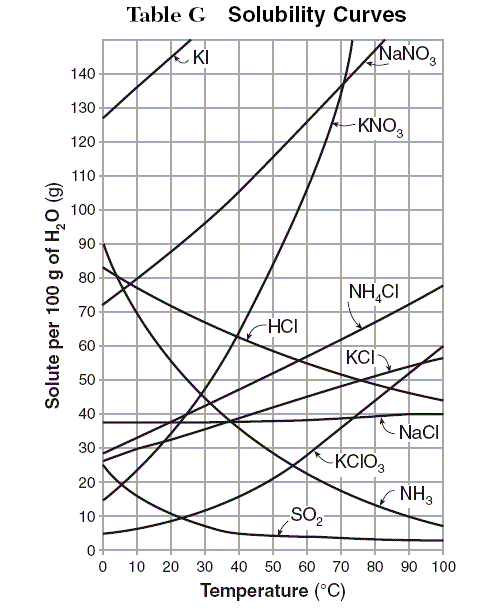 The graph shows how the solubility of various chemicals varies with temperature. The solubility is measured as grams of dissolved chemical (solute) per 100 grams of water.
The graph shows how the solubility of various chemicals varies with temperature. The solubility is measured as grams of dissolved chemical (solute) per 100 grams of water.
Under the assumption that the curves shown continue in the same general shape beyond the plotted area, use the drop-down menus to complete each of the following statements in the manner that most accurately reflects the information provided.
1. At 60°C, the most soluble of the chemicals is most likely__________.
2. There is most likely a temperature above 100°C at which NH4Cl is exactly as soluble as ___________.- a)1. SO2
2. KCl - b)1. KI
2. KClO3 - c)1. HCl
2. NH3 - d)1. SO2
2. NaCl - e)1. KClO3 2. NaNO3
Correct answer is option 'B'. Can you explain this answer?

The graph shows how the solubility of various chemicals varies with temperature. The solubility is measured as grams of dissolved chemical (solute) per 100 grams of water.
Under the assumption that the curves shown continue in the same general shape beyond the plotted area, use the drop-down menus to complete each of the following statements in the manner that most accurately reflects the information provided.
1. At 60°C, the most soluble of the chemicals is most likely__________.
2. There is most likely a temperature above 100°C at which NH4Cl is exactly as soluble as ___________.
Under the assumption that the curves shown continue in the same general shape beyond the plotted area, use the drop-down menus to complete each of the following statements in the manner that most accurately reflects the information provided.
1. At 60°C, the most soluble of the chemicals is most likely__________.
2. There is most likely a temperature above 100°C at which NH4Cl is exactly as soluble as ___________.
a)
1. SO2
2. KCl
2. KCl
b)
1. KI
2. KClO3
2. KClO3
c)
1. HCl
2. NH3
2. NH3
d)
1. SO2
2. NaCl
2. NaCl
e)
1. KClO3
2. NaNO3

|
EduRev GMAT answered |
By following the gridline at 60°C, the visible line indicating the solubility of NaNO3 is highest on the graph. However, the line for KI extends above the scale shown on the graph. So, given the assumption that the curves continue in the same general shape beyond the plotted area, the information given indicates that KI is the most soluble at 60°C.
The correct answer is KI.
The vertical distance between the solubility curves for KClO3 and NH4Cl decreases as the temperature increases, thus the difference in solubility between KClO3 and NH4Cl decreases as the temperature increases. Assuming that the curves continue in the same general shape beyond the plotted area, the vertical distance between them will eventually be zero, thereby indicating that there is a temperature at which the two chemicals are equally soluble. By contrast, the solubility curves for KCl and NaCl have increasingly greater vertical distances from that of NH4Cl as the temperature increases. Thus the differences in the solubilities of either KCl or NaCl as compared to that of NH4Cl would continue to increase as the temperature increases.
The correct answer is KClO3.
The correct answer is KI.
The vertical distance between the solubility curves for KClO3 and NH4Cl decreases as the temperature increases, thus the difference in solubility between KClO3 and NH4Cl decreases as the temperature increases. Assuming that the curves continue in the same general shape beyond the plotted area, the vertical distance between them will eventually be zero, thereby indicating that there is a temperature at which the two chemicals are equally soluble. By contrast, the solubility curves for KCl and NaCl have increasingly greater vertical distances from that of NH4Cl as the temperature increases. Thus the differences in the solubilities of either KCl or NaCl as compared to that of NH4Cl would continue to increase as the temperature increases.
The correct answer is KClO3.
Each type A machine fills 400 cans per minute,each Type B machine fills 600 cans per minute,and each Type C machine installs 2,400 lids per minute.A lid is installed on each can that is filled and on no can that is not filled.For a particular minute,what is the total number of machines working?(1) A total of 4,800 cans are filled that minute
(2) For that minute,there are 2 Type B machines working for every Type C machine working- a)Statement 1 alone is sufficient, but Statement 2 alone is not.
- b)Statement 2 alone is sufficient, but Statement 1 alone is not.
- c)Both statements together are sufficient, but neither alone is sufficient.
- d)Each statement alone is sufficient.
- e)Neither statement is sufficient.
Correct answer is option 'C'. Can you explain this answer?
Each type A machine fills 400 cans per minute,each Type B machine fills 600 cans per minute,and each Type C machine installs 2,400 lids per minute.A lid is installed on each can that is filled and on no can that is not filled.For a particular minute,what is the total number of machines working?
(1) A total of 4,800 cans are filled that minute
(2) For that minute,there are 2 Type B machines working for every Type C machine working
(2) For that minute,there are 2 Type B machines working for every Type C machine working
a)
Statement 1 alone is sufficient, but Statement 2 alone is not.
b)
Statement 2 alone is sufficient, but Statement 1 alone is not.
c)
Both statements together are sufficient, but neither alone is sufficient.
d)
Each statement alone is sufficient.
e)
Neither statement is sufficient.

|
EduRev GMAT answered |
We are given that each Type A machine fills 400 cans per minute, each Type B machine fills 600 cans per minute, and each Type C machine installs 2,400 lids per minute.
We need to determine the total number of machines working for a particular minute. If we let a = the number of Type A machines needed, b = the number of Type B machines needed, and c = the number of Type C machines needed, we need to determine the value of a + b + c.
Statement One Alone:
A total of 4,800 cans are filled that minute.
Since a Type C machine installs 2,400 lids per minute, we know that we need 2 Type C machines (i.e., c = 2) to install 4,800 lids after the 4,800 cans are filled in that minute.
Since each Type A machine fills 400 cans per minute and each Type B machine fills 600 cans per minute, we have:
400a + 600b = 4,800
4a + 6b = 48
2a + 3b = 24
However, since we only have one equation but we have two variables, the values of a and b are not unique. For example, a = 12 and b = 0 OR a = 0 and b = 8.
Statement one alone is not sufficient to answer the question.
Statement Two Alone:
For that minute, there are 2 Type B machines working for every Type C machine working.\
Thus, b/c = 2/1, i.e., b = 2c; however we still cannot determine a + b + c. Statement two alone is not sufficient.
Statements One and Two Together:
From statement one, we know that c = 2 and 2a + 3b = 24, and from statement two, we know that b = 2c. Since c = 2 and b = 2c, we see that b = 4.
Next we can substitute 4 for b in the equation 2a + 3b = 24:
2a + 3(4) = 24
2a + 12 = 24
2a = 12
a = 6
Thus a + b + c = 6 + 4 + 2 = 12. We need 12 machines for that particular minute.
2a + 3(4) = 24
2a + 12 = 24
2a = 12
a = 6
Thus a + b + c = 6 + 4 + 2 = 12. We need 12 machines for that particular minute.
On Christmas Eve, Santa and 5 of his elves need to deliver 210 presents to 7 towns, with each one requiring exactly 30 presents. Each trip to a town and back takes 1 hour, several trips can be made simultaneously, and each one requires at least Santa or two elves. Santa can deliver at most 15 presents per trip, and each elf can deliver at most 10 presents per trip.
Based on the information above, select for T1 the number of minimum hours it will take to deliver all 210 presents with Santa and T2 the number of minimum hours it will take to deliver all 210 presents without Santa.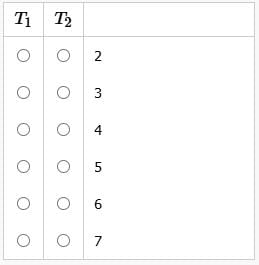
- a)T1 = 2
T2 = 3 - b)T1 = 3
T2 = 4 - c)T1 = 6
T2 = 7 - d)T1 = 7
T2 = 6 - e)T1 = 4
T2 = 5
Correct answer is option 'E'. Can you explain this answer?
On Christmas Eve, Santa and 5 of his elves need to deliver 210 presents to 7 towns, with each one requiring exactly 30 presents. Each trip to a town and back takes 1 hour, several trips can be made simultaneously, and each one requires at least Santa or two elves. Santa can deliver at most 15 presents per trip, and each elf can deliver at most 10 presents per trip.
Based on the information above, select for T1 the number of minimum hours it will take to deliver all 210 presents with Santa and T2 the number of minimum hours it will take to deliver all 210 presents without Santa.
Based on the information above, select for T1 the number of minimum hours it will take to deliver all 210 presents with Santa and T2 the number of minimum hours it will take to deliver all 210 presents without Santa.

a)
T1 = 2
T2 = 3
T2 = 3
b)
T1 = 3
T2 = 4
T2 = 4
c)
T1 = 6
T2 = 7
T2 = 7
d)
T1 = 7
T2 = 6
T2 = 6
e)
T1 = 4
T2 = 5
T2 = 5

|
EduRev GMAT answered |
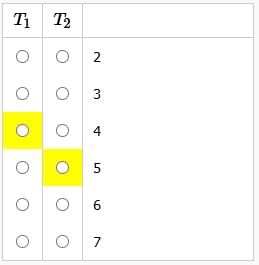
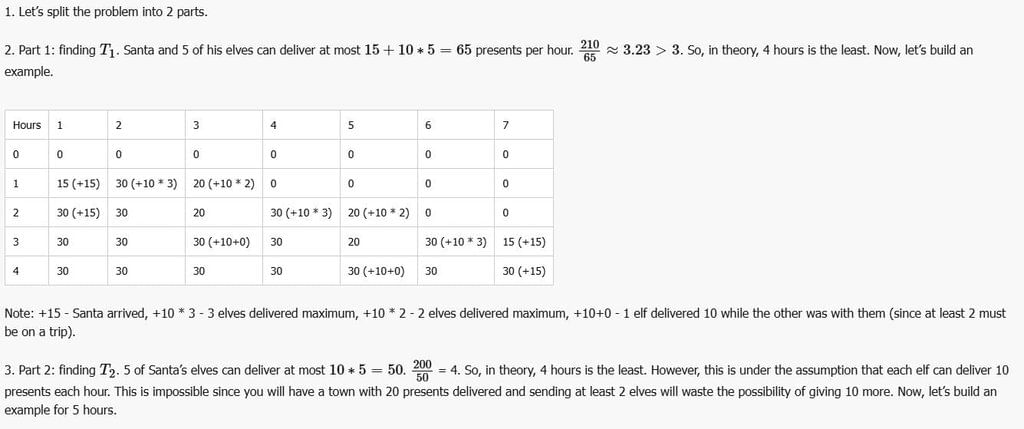

The graph shows the number of shipments handled by each of 6 delivery companies over the past 5 years.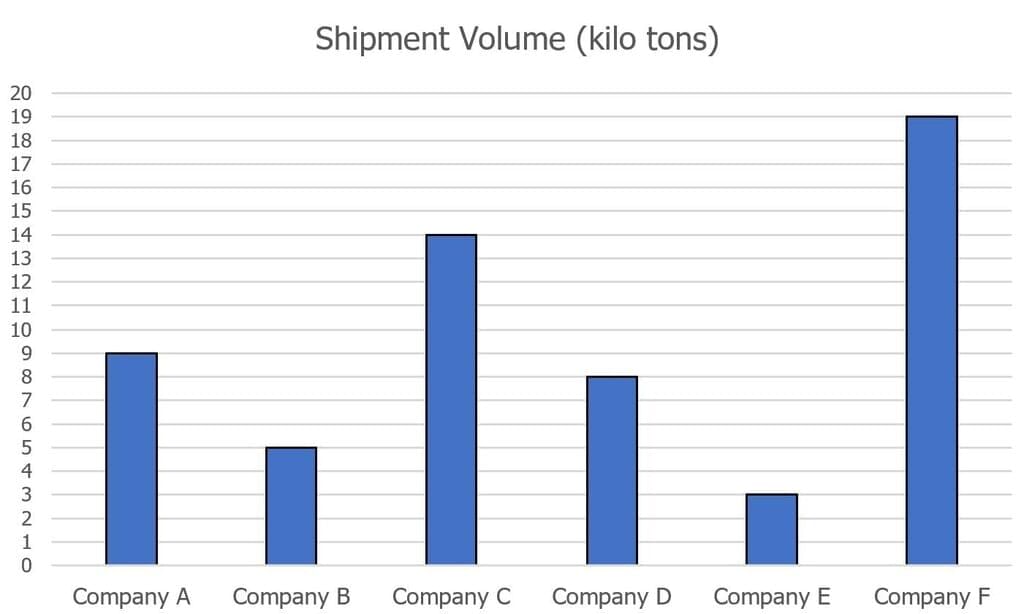
Select from each drop-down menu the option that creates the most accurate statement based on the information provided.
Over the past 5 years, the Delivery Company (i)_______ handled exactly 60% more shipments than Delivery Company (ii)________.- a)(i) Company C, (ii) Company B
- b)(i) Company E, (ii) Company A
- c)(i) Company D, (ii) Company B
- d)(i) Company E, (ii) Company C,
- e)(i) Company B, (ii) Company A
Correct answer is option 'C'. Can you explain this answer?
The graph shows the number of shipments handled by each of 6 delivery companies over the past 5 years.

Select from each drop-down menu the option that creates the most accurate statement based on the information provided.
Over the past 5 years, the Delivery Company (i)_______ handled exactly 60% more shipments than Delivery Company (ii)________.
a)
(i) Company C, (ii) Company B
b)
(i) Company E, (ii) Company A
c)
(i) Company D, (ii) Company B
d)
(i) Company E, (ii) Company C,
e)
(i) Company B, (ii) Company A

|
EduRev GMAT answered |
The correct answer is Company D handled exactly 60% more shipments than Delivery Company B.
To solve this question, we need to find 2 numbers such that 1.6 * x = y, where x and y are both whole numbers.
When multiplied by 1.6, only muliples of 5 (e.g. 5,10,15, etc.) result in a while number.
Only Company B satisfies this criteria with x =5.
Therefore, y must be 1.6 * 5 = 8.
To solve this question, we need to find 2 numbers such that 1.6 * x = y, where x and y are both whole numbers.
When multiplied by 1.6, only muliples of 5 (e.g. 5,10,15, etc.) result in a while number.
Only Company B satisfies this criteria with x =5.
Therefore, y must be 1.6 * 5 = 8.
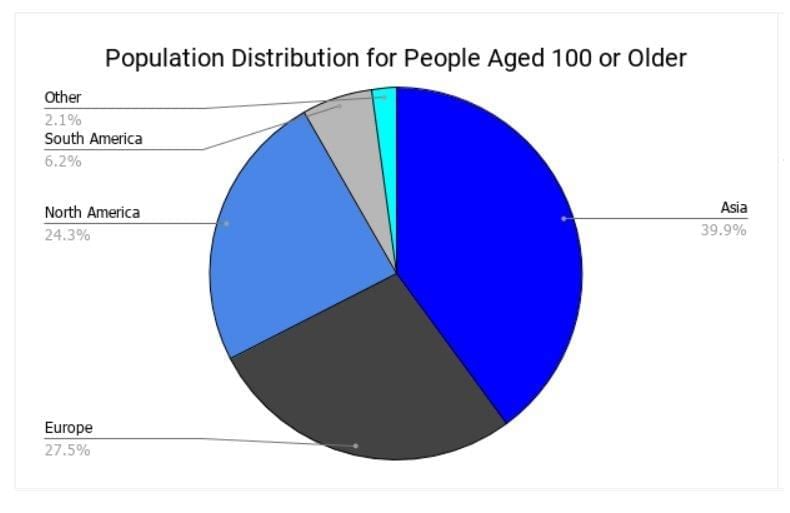
The chart shows the breakdown of the world’s population of people age 100 or older. Each portion represents the percentage of those people who live on a particular continent.For each statement, select the option from the drop-down menu that completes the statement as accurately as possible according to the information provided.
1. There are approximately ______ as many people age 100 or older in Asia and Europe combined than in South America.
2. If there are 18,600 people aged 100 or older living in South America, then there are approximately _____ people aged 100 or older living in North America.- a)Blank 1: 4 times, Blank 2: 4,600
- b)Blank 1: 7 times, Blank 2: 36,700
- c)Blank 1: 11 times, Blank 2: 73,300
- d)Blank 1: 5 times Blank 2: 150,100
- e)Blank 1: 6 times Blank 2: 160,100
Correct answer is option 'C'. Can you explain this answer?

The chart shows the breakdown of the world’s population of people age 100 or older. Each portion represents the percentage of those people who live on a particular continent.
For each statement, select the option from the drop-down menu that completes the statement as accurately as possible according to the information provided.
1. There are approximately ______ as many people age 100 or older in Asia and Europe combined than in South America.
2. If there are 18,600 people aged 100 or older living in South America, then there are approximately _____ people aged 100 or older living in North America.
1. There are approximately ______ as many people age 100 or older in Asia and Europe combined than in South America.
2. If there are 18,600 people aged 100 or older living in South America, then there are approximately _____ people aged 100 or older living in North America.
a)
Blank 1: 4 times, Blank 2: 4,600
b)
Blank 1: 7 times, Blank 2: 36,700
c)
Blank 1: 11 times, Blank 2: 73,300
d)
Blank 1: 5 times Blank 2: 150,100
e)
Blank 1: 6 times Blank 2: 160,100

|
EduRev GMAT answered |
1. There are approximately 11 times as many people age 100 or older in Asia and Europe combined than in South America.
People aged 100 or older in Asia and Europe is 40% + 27.5% ≈ 66
66% = 6.2%x (Where x signifies the total no. of people) ≈11
2. If there are 18,600 people aged 100 or older living in South America, then there are approximately 73300 people aged 100 or older living in North America.

People aged 100 or older in Asia and Europe is 40% + 27.5% ≈ 66
66% = 6.2%x (Where x signifies the total no. of people) ≈11
2. If there are 18,600 people aged 100 or older living in South America, then there are approximately 73300 people aged 100 or older living in North America.

The designers of a video game hired 100 game testers to play the game to determine whether the level of difficulty was appropriate. Each of the 100 testers made at most 25 attempts to complete each of the game's 15 levels (Levels 1–15). When a tester completed a level, he or she then made no further attempts at that level. For each of the levels, the table shows, among the testers who completed the level, the total number of testers whose number of attempts to complete that level fell in various ranges.
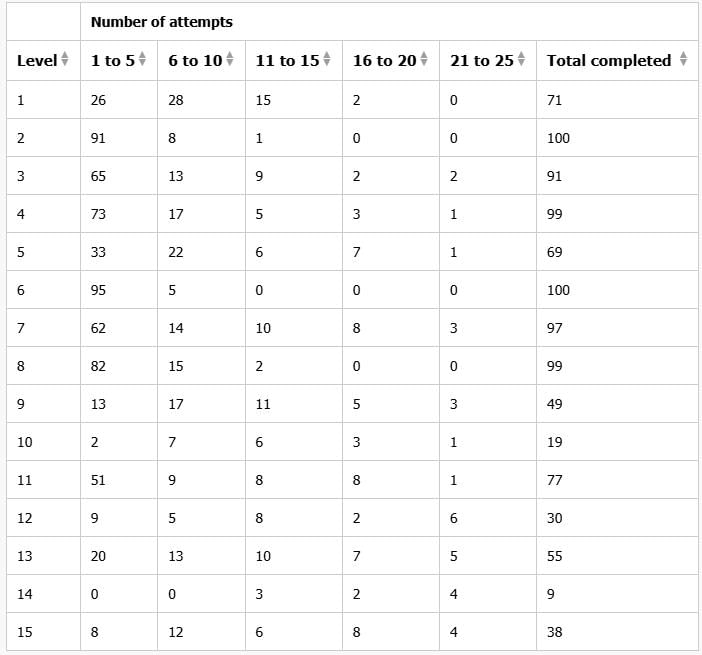 For each of the following statistical measures, select Must be 20 or less for every level if, based on the information provided, the measure must be at most 20 for each of the 15 levels. Otherwise, select Could be greater than 20 for one or more.
For each of the following statistical measures, select Must be 20 or less for every level if, based on the information provided, the measure must be at most 20 for each of the 15 levels. Otherwise, select Could be greater than 20 for one or more.

- a)1. Could be greater than: Mean of the total number of attempts to complete for all testers who completed the level
2. Must be 20 or less: Median of the total number of attempts to complete for all testers who completed the level
3. Could be greater than: Range of the total number of attempts to complete for all testers who completed the level - b)1. Could be greater than: Mean of the total number of attempts to complete for all testers who completed the level
2. Must be 20 or less: Range of the total number of attempts to complete for all testers who completed the level
3. Could be greater than: Median of the total number of attempts to complete for all testers who completed the level - c)1. Could be greater than: Median of the total number of attempts to complete for all testers who completed the level
2. Must be 20 or less: Range of the total number of attempts to complete for all testers who completed the level
3. Could be greater than: Mean of the total number of attempts to complete for all testers who completed the level - d)1. Could be greater than: Mean of the total number of attempts to complete for all testers who completed the level
2. Must be 20 or less: Median of the total number of attempts to complete for all testers who completed the level
3. Could be greater than: Range of the total number of attempts to complete for all testers who completed the level
Correct answer is option 'A'. Can you explain this answer?
The designers of a video game hired 100 game testers to play the game to determine whether the level of difficulty was appropriate. Each of the 100 testers made at most 25 attempts to complete each of the game's 15 levels (Levels 1–15). When a tester completed a level, he or she then made no further attempts at that level. For each of the levels, the table shows, among the testers who completed the level, the total number of testers whose number of attempts to complete that level fell in various ranges.


For each of the following statistical measures, select Must be 20 or less for every level if, based on the information provided, the measure must be at most 20 for each of the 15 levels. Otherwise, select Could be greater than 20 for one or more.


a)
1. Could be greater than: Mean of the total number of attempts to complete for all testers who completed the level
2. Must be 20 or less: Median of the total number of attempts to complete for all testers who completed the level
3. Could be greater than: Range of the total number of attempts to complete for all testers who completed the level
2. Must be 20 or less: Median of the total number of attempts to complete for all testers who completed the level
3. Could be greater than: Range of the total number of attempts to complete for all testers who completed the level
b)
1. Could be greater than: Mean of the total number of attempts to complete for all testers who completed the level
2. Must be 20 or less: Range of the total number of attempts to complete for all testers who completed the level
3. Could be greater than: Median of the total number of attempts to complete for all testers who completed the level
2. Must be 20 or less: Range of the total number of attempts to complete for all testers who completed the level
3. Could be greater than: Median of the total number of attempts to complete for all testers who completed the level
c)
1. Could be greater than: Median of the total number of attempts to complete for all testers who completed the level
2. Must be 20 or less: Range of the total number of attempts to complete for all testers who completed the level
3. Could be greater than: Mean of the total number of attempts to complete for all testers who completed the level
2. Must be 20 or less: Range of the total number of attempts to complete for all testers who completed the level
3. Could be greater than: Mean of the total number of attempts to complete for all testers who completed the level
d)
1. Could be greater than: Mean of the total number of attempts to complete for all testers who completed the level
2. Must be 20 or less: Median of the total number of attempts to complete for all testers who completed the level
3. Could be greater than: Range of the total number of attempts to complete for all testers who completed the level
2. Must be 20 or less: Median of the total number of attempts to complete for all testers who completed the level
3. Could be greater than: Range of the total number of attempts to complete for all testers who completed the level

|
EduRev GMAT answered |
1. Mean of the total number of attempts to complete for all testers who completed the level.
- Check if any of the levels has more number of attempts in 15-20 and 20-25 attempts than the sum of all other columns.
- When you scan the table, the level 14 stands out as there are 3 in 11-15 attempts , 2 in 16-20 attempts and 4 in 21-25 attempts.
- So, the max mean would be when all the testers took the maximum attempt in each case, so 3 took 15 attempts, 2 took 20 attempts and 4 took 25 attempts.

Could be greater than 20.
2. Median of the total number of attempts to complete for all testers who completed the level
- Check if any of the levels has more number of attempts in 20-25 attempts than the sum of all other columns.
- When you scan the table, no level has sum of numbers under 1-5, 6-10, 11-15 and 16-20 attempts less than that under 21-25.
- Thus median will always be 20 or less......Equal to or less than 20
3. Range of the total number of attempts to complete for all testers who completed the level
- If any level has been finished be some tester in 1-5 attempts while there are some more who have finished it in 20-25 attempts, the maximum range could be 25-1 = 24.
- There are many under this case: Level 3, 4, 5, 7, 9-15
Could be greater than 20
Alejandra is designing a game of chance. For one part of the game, a player is to randomly choose 3 marbles, without replacement, from a box containing B blue marbles, R red marbles, and no other marbles. Alejandra correctly determined the positive integers B and R so that the number of possible selections in which 1 blue marble and 2 red marbles are chosen is twice the number of possible selections in which 2 blue marbles and 1 red marble are chosen.
The positive integers B and R that Alejandra determined must be such that B is the number that is __ 1 __ and R is the number that is __ 2 __.
Based on the information provided, select for 1 and for 2 the options that create the most accurate statement. Make only two selections, one in each column.
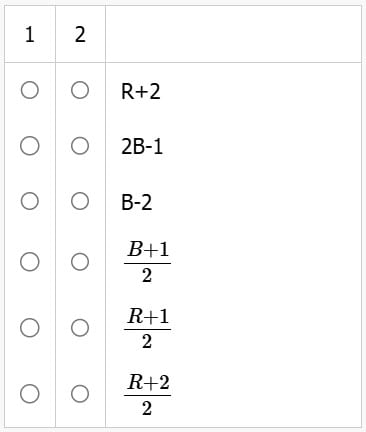
- a)1:

2: 2B-1 - b)1:

2: B-2 - c)1:

2: R+2 - d)1: 2B-1
2: 
Correct answer is option 'A'. Can you explain this answer?
Alejandra is designing a game of chance. For one part of the game, a player is to randomly choose 3 marbles, without replacement, from a box containing B blue marbles, R red marbles, and no other marbles. Alejandra correctly determined the positive integers B and R so that the number of possible selections in which 1 blue marble and 2 red marbles are chosen is twice the number of possible selections in which 2 blue marbles and 1 red marble are chosen.
The positive integers B and R that Alejandra determined must be such that B is the number that is __ 1 __ and R is the number that is __ 2 __.
Based on the information provided, select for 1 and for 2 the options that create the most accurate statement. Make only two selections, one in each column.

The positive integers B and R that Alejandra determined must be such that B is the number that is __ 1 __ and R is the number that is __ 2 __.
Based on the information provided, select for 1 and for 2 the options that create the most accurate statement. Make only two selections, one in each column.

a)
1: 
2: 2B-1

2: 2B-1
b)
1: 
2: B-2

2: B-2
c)
1: 
2: R+2

2: R+2
d)
1: 2B-1
2:
2:


|
EduRev GMAT answered |

R−1 = 2B − 2

R = 2B − 1
A rectangle has a Length : Width ratio of 3 : 1. From the table below, select a combination of Perimeter and Area that satisfies such a relationship.
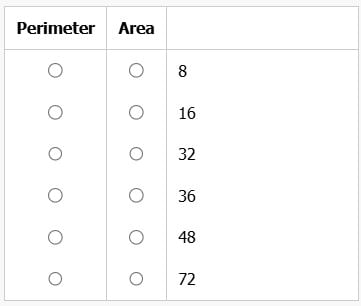
- a)Perimeter: 36
Area: 72 - b)Perimeter: 16
Area: 8 - c)Perimeter: 8
Area: 16 - d)Perimeter: 32
Area: 48 - e)Perimeter: 72
Area: 36
Correct answer is option 'D'. Can you explain this answer?
A rectangle has a Length : Width ratio of 3 : 1. From the table below, select a combination of Perimeter and Area that satisfies such a relationship.


a)
Perimeter: 36
Area: 72
Area: 72
b)
Perimeter: 16
Area: 8
Area: 8
c)
Perimeter: 8
Area: 16
Area: 16
d)
Perimeter: 32
Area: 48
Area: 48
e)
Perimeter: 72
Area: 36
Area: 36

|
EduRev GMAT answered |
A rectangle has a Length : Width ratio of 3 : 1. From the table below, select a combination of Perimeter and Area that satisfies such a relationship.
Perimeter of a Rectangle = 2(l+b)
We are given Lenght/Breadth = 3/1; Length(l) = 3* Breadth (b)
Perimeter = 2(4 b) = 8 b
Area = l*b = 3 b2
From the options, Perimeter = 8 (4) = 32; Area = 3 * 16 = 48
Email #1
Email from project manager to financial officer
August 3, 9:43 a.m.
Did all three bids arrive on time last night? We need to minimize delays on construction, so if the contractors have submitted their estimates and our research team has compiled reports on the contractors’ histories, we should make a decision on which firm to hire by the end of the day.Email #2
Email from financial officer in response to the project manager’s August 3, 9:43 a.m. email
August 3, 10:12 a.m.
Appaloosa Construction sent us a bid of $1.35 million. Its bid is the highest of the three, but its track record is spotless; none of the past 10 major projects it has worked on has gone over budget by more than 4 percent. Breton Construction did manage to underbid them—its representative claims that it can do the project for $1.25 million. However, in the past two years, Breton oversaw two different projects that went over budget by a full 25 percent. If our project were to exceed Breton’s estimate by a comparable percentage, we would run out of funds before completion. Finally, Campolina Construction presented a $1.1 million plan, and its track record is as good as Appaloosa’s. Unfortunately, although Appaloosa and Breton can both start tomorrow, Campolina would be unable to begin work until August 25, so we cannot accept Campolina’s low bid.Email #3
Email from project manager in response to the financial officer’s August 3, 10:12 a.m. email
August 3, 10:38 a.m.
Even though Breton’s work could potentially cost less than either of the other two, that savings does not justify the risk of being unable to complete the project. But as far as Campolina is concerned, you’re not considering the actual cost of a delay. It’s true that we are losing money at a constant rate each day we don’t start building. But even after factoring in the losses of waiting until August 25, the estimated cost of working with Campolina still ends up $50,000 below Appaloosa’s bid.Consider each of the following statements. Does the information in the three emails support the inferences as stated? Choose Yes if the statement can be accurately inferred; otherwise, choose No.
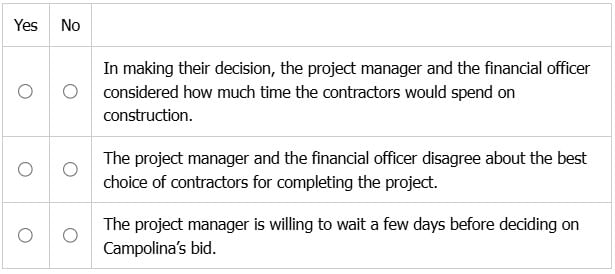
- a)In making their decision, the project manager and the financial officer considered how much time the contractors would spend on construction.: yes
The project manager and the financial officer disagree about the best choice of contractors for completing the project.: Yes
The project manager is willing to wait a few days before deciding on Campolina’s bid.: No - b)In making their decision, the project manager and the financial officer considered how much time the contractors would spend on construction.: No
The project manager and the financial officer disagree about the best choice of contractors for completing the project.: Yes
The project manager is willing to wait a few days before deciding on Campolina’s bid.: No - c)In making their decision, the project manager and the financial officer considered how much time the contractors would spend on construction.: yes
The project manager and the financial officer disagree about the best choice of contractors for completing the project.: No
The project manager is willing to wait a few days before deciding on Campolina’s bid.: No - d)In making their decision, the project manager and the financial officer considered how much time the contractors would spend on construction.: yes
The project manager and the financial officer disagree about the best choice of contractors for completing the project.: No
The project manager is willing to wait a few days before deciding on Campolina’s bid.: yes - e)In making their decision, the project manager and the financial officer considered how much time the contractors would spend on construction.: No
The project manager and the financial officer disagree about the best choice of contractors for completing the project.: No
The project manager is willing to wait a few days before deciding on Campolina’s bid.: No
Correct answer is option 'B'. Can you explain this answer?
Email #1
Email from project manager to financial officer
August 3, 9:43 a.m.
Did all three bids arrive on time last night? We need to minimize delays on construction, so if the contractors have submitted their estimates and our research team has compiled reports on the contractors’ histories, we should make a decision on which firm to hire by the end of the day.
Email from project manager to financial officer
August 3, 9:43 a.m.
Did all three bids arrive on time last night? We need to minimize delays on construction, so if the contractors have submitted their estimates and our research team has compiled reports on the contractors’ histories, we should make a decision on which firm to hire by the end of the day.
Email #2
Email from financial officer in response to the project manager’s August 3, 9:43 a.m. email
August 3, 10:12 a.m.
Appaloosa Construction sent us a bid of $1.35 million. Its bid is the highest of the three, but its track record is spotless; none of the past 10 major projects it has worked on has gone over budget by more than 4 percent. Breton Construction did manage to underbid them—its representative claims that it can do the project for $1.25 million. However, in the past two years, Breton oversaw two different projects that went over budget by a full 25 percent. If our project were to exceed Breton’s estimate by a comparable percentage, we would run out of funds before completion. Finally, Campolina Construction presented a $1.1 million plan, and its track record is as good as Appaloosa’s. Unfortunately, although Appaloosa and Breton can both start tomorrow, Campolina would be unable to begin work until August 25, so we cannot accept Campolina’s low bid.
Email from financial officer in response to the project manager’s August 3, 9:43 a.m. email
August 3, 10:12 a.m.
Appaloosa Construction sent us a bid of $1.35 million. Its bid is the highest of the three, but its track record is spotless; none of the past 10 major projects it has worked on has gone over budget by more than 4 percent. Breton Construction did manage to underbid them—its representative claims that it can do the project for $1.25 million. However, in the past two years, Breton oversaw two different projects that went over budget by a full 25 percent. If our project were to exceed Breton’s estimate by a comparable percentage, we would run out of funds before completion. Finally, Campolina Construction presented a $1.1 million plan, and its track record is as good as Appaloosa’s. Unfortunately, although Appaloosa and Breton can both start tomorrow, Campolina would be unable to begin work until August 25, so we cannot accept Campolina’s low bid.
Email #3
Email from project manager in response to the financial officer’s August 3, 10:12 a.m. email
August 3, 10:38 a.m.
Even though Breton’s work could potentially cost less than either of the other two, that savings does not justify the risk of being unable to complete the project. But as far as Campolina is concerned, you’re not considering the actual cost of a delay. It’s true that we are losing money at a constant rate each day we don’t start building. But even after factoring in the losses of waiting until August 25, the estimated cost of working with Campolina still ends up $50,000 below Appaloosa’s bid.
Email from project manager in response to the financial officer’s August 3, 10:12 a.m. email
August 3, 10:38 a.m.
Even though Breton’s work could potentially cost less than either of the other two, that savings does not justify the risk of being unable to complete the project. But as far as Campolina is concerned, you’re not considering the actual cost of a delay. It’s true that we are losing money at a constant rate each day we don’t start building. But even after factoring in the losses of waiting until August 25, the estimated cost of working with Campolina still ends up $50,000 below Appaloosa’s bid.
Consider each of the following statements. Does the information in the three emails support the inferences as stated? Choose Yes if the statement can be accurately inferred; otherwise, choose No.


a)
In making their decision, the project manager and the financial officer considered how much time the contractors would spend on construction.: yes
The project manager and the financial officer disagree about the best choice of contractors for completing the project.: Yes
The project manager is willing to wait a few days before deciding on Campolina’s bid.: No
The project manager and the financial officer disagree about the best choice of contractors for completing the project.: Yes
The project manager is willing to wait a few days before deciding on Campolina’s bid.: No
b)
In making their decision, the project manager and the financial officer considered how much time the contractors would spend on construction.: No
The project manager and the financial officer disagree about the best choice of contractors for completing the project.: Yes
The project manager is willing to wait a few days before deciding on Campolina’s bid.: No
The project manager and the financial officer disagree about the best choice of contractors for completing the project.: Yes
The project manager is willing to wait a few days before deciding on Campolina’s bid.: No
c)
In making their decision, the project manager and the financial officer considered how much time the contractors would spend on construction.: yes
The project manager and the financial officer disagree about the best choice of contractors for completing the project.: No
The project manager is willing to wait a few days before deciding on Campolina’s bid.: No
The project manager and the financial officer disagree about the best choice of contractors for completing the project.: No
The project manager is willing to wait a few days before deciding on Campolina’s bid.: No
d)
In making their decision, the project manager and the financial officer considered how much time the contractors would spend on construction.: yes
The project manager and the financial officer disagree about the best choice of contractors for completing the project.: No
The project manager is willing to wait a few days before deciding on Campolina’s bid.: yes
The project manager and the financial officer disagree about the best choice of contractors for completing the project.: No
The project manager is willing to wait a few days before deciding on Campolina’s bid.: yes
e)
In making their decision, the project manager and the financial officer considered how much time the contractors would spend on construction.: No
The project manager and the financial officer disagree about the best choice of contractors for completing the project.: No
The project manager is willing to wait a few days before deciding on Campolina’s bid.: No
The project manager and the financial officer disagree about the best choice of contractors for completing the project.: No
The project manager is willing to wait a few days before deciding on Campolina’s bid.: No

|
EduRev GMAT answered |
- In making their decision, the project manager and the financial officer considered how much time the contractors would spend on construction.
Answer: No
Based on the emails, the time contractors would spend on construction is not explicitly mentioned as a key factor in their decision. Therefore, this statement cannot be accurately inferred. - The project manager and the financial officer disagree about the best choice of contractors for completing the project.
Answer: Yes
The emails indicate that there is a disagreement between the project manager and the financial officer about which contractor is the best choice for the project. - The project manager is willing to wait a few days before deciding on Campolina’s bid.
Answer: No
The emails do not mention the project manager being willing to wait a few days before deciding on Campolina’s bid. Therefore, this statement is not supported by the information.
Hence, the correct options are:
In making their decision, the project manager and the financial officer considered how much time the contractors would spend on construction: No
The project manager and the financial officer disagree about the best choice of contractors for completing the project: Yes
The project manager is willing to wait a few days before deciding on Campolina’s bid: No
Percentage of Professions Requiring Selected Protective Gear, 2015
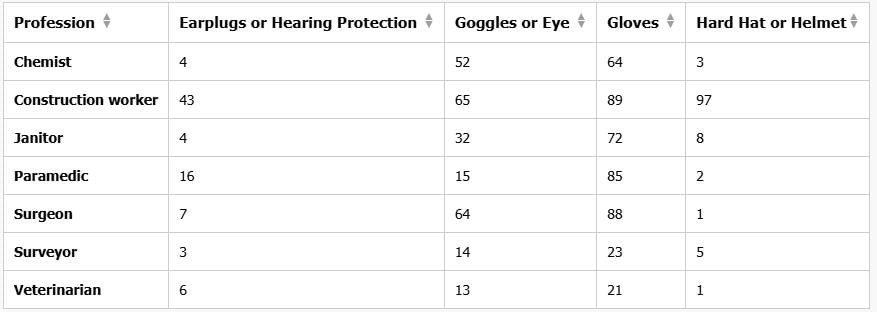
(Sort ↕ the table by clicking on the headers)For each of the following statements, select Would help explain if it would, if true, help explain some of the information in the table. Otherwise, select Would not help explain.

- a)Would help explain: Humans catch diseases from other humans much more easily than from animals.
Would help explain: Ambulance sirens are loud, but they don't damage people's hearing as much as power tools do.
Would not help explain: About 10% of janitors earn extra pay for cleaning hazardous areas. - b)Would help explain: Humans catch diseases from other humans much more easily than from animals.
Would help explain: About 10% of janitors earn extra pay for cleaning hazardous areas.
Would not help explain: Ambulance sirens are loud, but they don't damage people's hearing as much as power tools do. - c)Would help explain: Humans catch diseases from other humans much more easily than from animals.
Would help explain: Ambulance sirens are loud, but they don't damage people's hearing as much as power tools do.
Would not help explain: About 10% of janitors earn extra pay for cleaning hazardous areas. - d)Would help explain: About 10% of janitors earn extra pay for cleaning hazardous areas.
Would help explain: Ambulance sirens are loud, but they don't damage people's hearing as much as power tools do.
Would not help explain: Humans catch diseases from other humans much more easily than from animals.
Correct answer is option 'A'. Can you explain this answer?
Percentage of Professions Requiring Selected Protective Gear, 2015

(Sort ↕ the table by clicking on the headers)

(Sort ↕ the table by clicking on the headers)
For each of the following statements, select Would help explain if it would, if true, help explain some of the information in the table. Otherwise, select Would not help explain.


a)
Would help explain:
Humans catch diseases from other humans much more easily than from animals.
Would help explain:
Ambulance sirens are loud, but they don't damage people's hearing as much as power tools do.
Would not help explain:
About 10% of janitors earn extra pay for cleaning hazardous areas.
b)
Would help explain:
Humans catch diseases from other humans much more easily than from animals.
Would help explain:
About 10% of janitors earn extra pay for cleaning hazardous areas.
Would not help explain:
Ambulance sirens are loud, but they don't damage people's hearing as much as power tools do.
c)
Would help explain:
Humans catch diseases from other humans much more easily than from animals.
Would help explain:
Ambulance sirens are loud, but they don't damage people's hearing as much as power tools do.
Would not help explain:
About 10% of janitors earn extra pay for cleaning hazardous areas.
d)
Would help explain:
About 10% of janitors earn extra pay for cleaning hazardous areas.
Would help explain:
Ambulance sirens are loud, but they don't damage people's hearing as much as power tools do.
Would not help explain:
Humans catch diseases from other humans much more easily than from animals.

|
EduRev GMAT answered |
1. We see that the percentage of Surgeons and even Paramedics wearing protective gear is higher than the veterinarian across all types of gears. This can be explained by "Humans catch diseases from other humans much more easily than from animals." Hence, the first statement "Would Help Explain" the information in the table.
2. We see that a higher percent of Construction Workers wear earplugs or hearing protection compared to Paramedics. This could be explained by "Ambulance sirens are loud, but they don't damage people's hearing as much as power tools do." Hence, the second statement "Would Help Explain" the information in the table.
3. There is no information in the table that can be explained by "About 10% of janitors earn extra pay for cleaning hazardous areas." Hence, the third statement "Would Not Help Explain" the information in the table.
2. We see that a higher percent of Construction Workers wear earplugs or hearing protection compared to Paramedics. This could be explained by "Ambulance sirens are loud, but they don't damage people's hearing as much as power tools do." Hence, the second statement "Would Help Explain" the information in the table.
3. There is no information in the table that can be explained by "About 10% of janitors earn extra pay for cleaning hazardous areas." Hence, the third statement "Would Not Help Explain" the information in the table.
If machine X ran continuously at a uniform rate to fill a production order, at what time did the machine finish filling the order?(1) Machine X had filled 2/3 of the order by 10:00 a.m. and 5/6 of the order by 10:30 a.m.(2) Machine X had filled 1/6 of the order by 8:30 a.m. and 1/3 of the order by 9:00 a.m.
- a)Statement (1) ALONE is sufficient, but statement (2) alone is not sufficient to answer the question asked.
- b)Statement (2) ALONE is sufficient, but statement (1) alone is not sufficient to answer the question asked.
- c)BOTH statements (1) and (2) TOGETHER are sufficient to answer the question asked, but NEITHER statement ALONE is sufficient to answer the question ask
- d)EACH statement ALONE is sufficient to answer the question asked.
- e)Statements (1) and (2) TOGETHER are NOT sufficient to answer the question asked, and additional data specific to the problem are needed.
Correct answer is option 'D'. Can you explain this answer?
If machine X ran continuously at a uniform rate to fill a production order, at what time did the machine finish filling the order?
(1) Machine X had filled 2/3 of the order by 10:00 a.m. and 5/6 of the order by 10:30 a.m.
(2) Machine X had filled 1/6 of the order by 8:30 a.m. and 1/3 of the order by 9:00 a.m.
a)
Statement (1) ALONE is sufficient, but statement (2) alone is not sufficient to answer the question asked.
b)
Statement (2) ALONE is sufficient, but statement (1) alone is not sufficient to answer the question asked.
c)
BOTH statements (1) and (2) TOGETHER are sufficient to answer the question asked, but NEITHER statement ALONE is sufficient to answer the question ask
d)
EACH statement ALONE is sufficient to answer the question asked.
e)
Statements (1) and (2) TOGETHER are NOT sufficient to answer the question asked, and additional data specific to the problem are needed.

|
EduRev GMAT answered |
Statement (1)
- At 10:00 a.m., machine X had completed 2/3 of the order.
- At 10:30 a.m., machine X had completed 5/6 of the order.
From this, we can determine the rate of the machine:
- In 30 minutes, it completed (5/6 - 2/3) = (10/12 - 8/12) = 2/12 = 1/6 of the order.
- This means the machine fills 1/6 of the order every 30 minutes.
- Since 5/6 of the order was completed by 10:30 a.m., the remaining 1/6 will take another 30 minutes, so the order is completed at 11:00 a.m
Sufficient.
Statement (2)
- At 8:30 a.m., machine X had completed 1/6 of the order.
- At 9:00 a.m., machine X had completed 1/3 of the order.
From this, we can determine the rate:
- In 30 minutes, it completed (1/3 - 1/6) = (2/6 - 1/6) = 1/6 of the order.
- Since the machine fills 1/6 of the order every 30 minutes, we can compute the completion time.
Sufficient.
Option D
- At 10:00 a.m., machine X had completed 2/3 of the order.
- At 10:30 a.m., machine X had completed 5/6 of the order.
From this, we can determine the rate of the machine:
- In 30 minutes, it completed (5/6 - 2/3) = (10/12 - 8/12) = 2/12 = 1/6 of the order.
- This means the machine fills 1/6 of the order every 30 minutes.
- Since 5/6 of the order was completed by 10:30 a.m., the remaining 1/6 will take another 30 minutes, so the order is completed at 11:00 a.m
Sufficient.
Statement (2)
- At 8:30 a.m., machine X had completed 1/6 of the order.
- At 9:00 a.m., machine X had completed 1/3 of the order.
From this, we can determine the rate:
- In 30 minutes, it completed (1/3 - 1/6) = (2/6 - 1/6) = 1/6 of the order.
- Since the machine fills 1/6 of the order every 30 minutes, we can compute the completion time.
Sufficient.
Option D
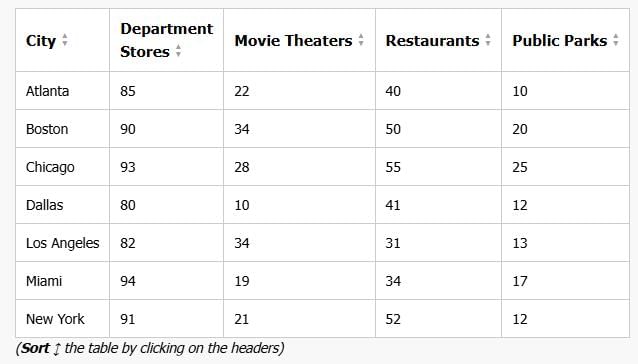
The above table shows, for different cities, the percentage of population of a city which is a regular visitor to different locations in the city. For example: 85% of the people in Atlanta are regular visitors to department stores, and 12% of the people in New York are regular visitors to public parks.
Select Would Explain if the statement explains some of the information in the table. Otherwise, select Would not Explain.

- a)Part 1: Would Not Explain
Part 2: Would Not Explain
Part 3: Would Not Explain - b)Part 1: Would Not Explain
Part 2: Would Explain
Part 3: Would Not Explain - c)Part 1: Would Not Explain
Part 2: Would Explain
Part 3: Would Explain - d)Part 1: Would Explain
Part 2: Would Explain
Part 3: Would Explain - e)Part 1: Would Explain
Part 2: Would Not Explain
Part 3: Would Not Explain
Correct answer is option 'A'. Can you explain this answer?

The above table shows, for different cities, the percentage of population of a city which is a regular visitor to different locations in the city. For example: 85% of the people in Atlanta are regular visitors to department stores, and 12% of the people in New York are regular visitors to public parks.
Select Would Explain if the statement explains some of the information in the table. Otherwise, select Would not Explain.

a)
Part 1: Would Not Explain
Part 2: Would Not Explain
Part 3: Would Not Explain
Part 2: Would Not Explain
Part 3: Would Not Explain
b)
Part 1: Would Not Explain
Part 2: Would Explain
Part 3: Would Not Explain
Part 2: Would Explain
Part 3: Would Not Explain
c)
Part 1: Would Not Explain
Part 2: Would Explain
Part 3: Would Explain
Part 2: Would Explain
Part 3: Would Explain
d)
Part 1: Would Explain
Part 2: Would Explain
Part 3: Would Explain
Part 2: Would Explain
Part 3: Would Explain
e)
Part 1: Would Explain
Part 2: Would Not Explain
Part 3: Would Not Explain
Part 2: Would Not Explain
Part 3: Would Not Explain

|
EduRev GMAT answered |
A. A majority of people living in these cities do not have easy access to a public park.
>>ACCESS – cant not be commented ; maybe these visitors are not interested to go even after having access
WOULD NOT EXPLAIN
B. The proportion of residents that live in the proximity of a movie theater is lower in Dallas than that in Boston and Los Angeles.
>>Dallas= 41% ; boston = 50% and LA= 31%
But it is hard to mention the number of residents in total
WOULD NOT EXPLAIN
C. The proportion if people who prefer to spend time indoors is greater in Dallas than in Chicago.
>>Dallas indoors= it is not right to explain that 82% in departmental stores are same people or different people moving to theatres, restaurants or public parks
Similarly for Chicago ; no detail infromtion is given
WOULD NOT EXPLAIN
>>ACCESS – cant not be commented ; maybe these visitors are not interested to go even after having access
WOULD NOT EXPLAIN
B. The proportion of residents that live in the proximity of a movie theater is lower in Dallas than that in Boston and Los Angeles.
>>Dallas= 41% ; boston = 50% and LA= 31%
But it is hard to mention the number of residents in total
WOULD NOT EXPLAIN
C. The proportion if people who prefer to spend time indoors is greater in Dallas than in Chicago.
>>Dallas indoors= it is not right to explain that 82% in departmental stores are same people or different people moving to theatres, restaurants or public parks
Similarly for Chicago ; no detail infromtion is given
WOULD NOT EXPLAIN
At a certain factory, the number of first-shift workers is 2/3 the number of second-shift workers. Every day, each second-shift worker can make 4/3 as many light bulbs as each first-shift worker.
In the first column, identify a possible number of total light bulbs made on one day by the two shifts combined; in the second column, identify the corresponding number of total light bulbs that the first-shift workers made on the same day. Make only two selections, one in each column.
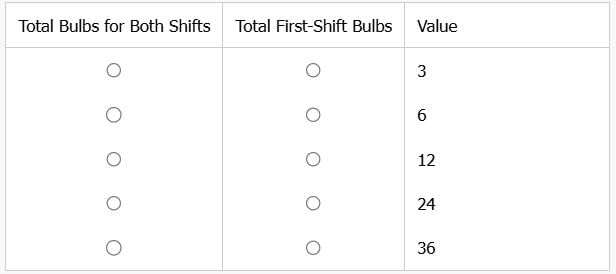
- a)Total Bulbs for Both Shifts: 36
Total First-Shift Bulbs: 12 - b)Total Bulbs for Both Shifts: 3
Total First-Shift Bulbs: 6 - c)Total Bulbs for Both Shifts: 12
Total First-Shift Bulbs: 6 - d)Total Bulbs for Both Shifts: 12
Total First-Shift Bulbs: 24
Correct answer is option 'A'. Can you explain this answer?
At a certain factory, the number of first-shift workers is 2/3 the number of second-shift workers. Every day, each second-shift worker can make 4/3 as many light bulbs as each first-shift worker.
In the first column, identify a possible number of total light bulbs made on one day by the two shifts combined; in the second column, identify the corresponding number of total light bulbs that the first-shift workers made on the same day. Make only two selections, one in each column.

In the first column, identify a possible number of total light bulbs made on one day by the two shifts combined; in the second column, identify the corresponding number of total light bulbs that the first-shift workers made on the same day. Make only two selections, one in each column.

a)
Total Bulbs for Both Shifts: 36
Total First-Shift Bulbs: 12
Total First-Shift Bulbs: 12
b)
Total Bulbs for Both Shifts: 3
Total First-Shift Bulbs: 6
Total First-Shift Bulbs: 6
c)
Total Bulbs for Both Shifts: 12
Total First-Shift Bulbs: 6
Total First-Shift Bulbs: 6
d)
Total Bulbs for Both Shifts: 12
Total First-Shift Bulbs: 24
Total First-Shift Bulbs: 24

|
EduRev GMAT answered |
Let number of second shift workers be n
Then number of first shift workers = 2n/3
Let b the number of bulbs made by each worker in the first shift
Then number of bulbs made by each worker in the second shift is 4b/3
Total bulbs made by first shift workers: 2nb/3
Tota bulbs made by second shift workers: 4nb/3
Total bulbs by both: 6nb/3 => 2nb
Now try substituting value of 2nb (first column) to find nb and get 2nb/3 (second column)
If 2nb =3, nb. = 3/2 not possible => eliminate
If 2nb = 6, nb = 3 => 2/3 nb = 2 which is not present => eliminate
If 2nb = 12, nb = 6 => 2/3 nb = 4, again not present => eliminate
If 2nb = 24, nb = 12 => 2/3nb = 8, again not present => eliminate
Therefore only 36 should fit in. Let's check
2nb = 36 => nb = 18 => 2/3nb = 12
Hence Total Bulbs for Both Shifts (Column 1) = 36
Total First-Shift Bulbs (Column 2) = 12
Then number of first shift workers = 2n/3
Let b the number of bulbs made by each worker in the first shift
Then number of bulbs made by each worker in the second shift is 4b/3
Total bulbs made by first shift workers: 2nb/3
Tota bulbs made by second shift workers: 4nb/3
Total bulbs by both: 6nb/3 => 2nb
Now try substituting value of 2nb (first column) to find nb and get 2nb/3 (second column)
If 2nb =3, nb. = 3/2 not possible => eliminate
If 2nb = 6, nb = 3 => 2/3 nb = 2 which is not present => eliminate
If 2nb = 12, nb = 6 => 2/3 nb = 4, again not present => eliminate
If 2nb = 24, nb = 12 => 2/3nb = 8, again not present => eliminate
Therefore only 36 should fit in. Let's check
2nb = 36 => nb = 18 => 2/3nb = 12
Hence Total Bulbs for Both Shifts (Column 1) = 36
Total First-Shift Bulbs (Column 2) = 12
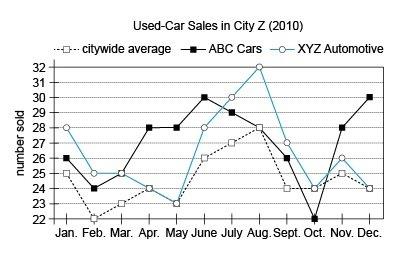
In 2010, there were four used-car dealers in City Z. The graphic shows the monthly sales data for 2010 for two of those dealers as well as the citywide average for used-car dealers for those months.Based on the given information, use the drop-down menus to most accurately complete the following statements.
1. ABC Cars and XYZ Automotive accounted for ____half of all used-car sales in City Z for 2010.
2. In June 2010, the two used-car dealers that are not specified by the graphic sold a total of exactly _____ cars.- a)Less than, 23
- b)Exactly, 52
- c)More than, 46
- d)Less than, 58
- e)Exactly, 46
Correct answer is option 'C'. Can you explain this answer?
In 2010, there were four used-car dealers in City Z. The graphic shows the monthly sales data for 2010 for two of those dealers as well as the citywide average for used-car dealers for those months.
Based on the given information, use the drop-down menus to most accurately complete the following statements.
1. ABC Cars and XYZ Automotive accounted for ____half of all used-car sales in City Z for 2010.
2. In June 2010, the two used-car dealers that are not specified by the graphic sold a total of exactly _____ cars.
2. In June 2010, the two used-car dealers that are not specified by the graphic sold a total of exactly _____ cars.
a)
Less than, 23
b)
Exactly, 52
c)
More than, 46
d)
Less than, 58
e)
Exactly, 46

|
EduRev GMAT answered |
1. ABC Cars and XYZ Automotive accounted for_______half of all used-car sales in City Z for 2010.
Since the white circles (connected by blue lines) and the filled squares (connected by black lines) in the graph are consistently at or above the empty squares (connected by dotted lines), it follows that both ABC Cars and XYZ Automotive were at or above the citywide average for every single month in 2010. Thus their combined sales must have been greater than the combined sales of the two dealers not included in the graph. Therefore ABC Cars and XYZ Automotive must have accounted for more than half of all used-car sales in City Z in 2010.
The correct answer is more than.
Since the white circles (connected by blue lines) and the filled squares (connected by black lines) in the graph are consistently at or above the empty squares (connected by dotted lines), it follows that both ABC Cars and XYZ Automotive were at or above the citywide average for every single month in 2010. Thus their combined sales must have been greater than the combined sales of the two dealers not included in the graph. Therefore ABC Cars and XYZ Automotive must have accounted for more than half of all used-car sales in City Z in 2010.
The correct answer is more than.
2. In June 2010, the two used-car dealers that are not specified by the graphic sold a total of exactly______________cars.
In June 2010, the citywide average was 26 cars. This means that the four dealers sold a combined 4(26) = 104 cars. Of those 104 cars, ABC Cars sold 30 and XYZ Automotive sold 28. This implies that the other two dealers sold 104 − 30 − 28 = 46 cars.
The correct answer is 46.
In June 2010, the citywide average was 26 cars. This means that the four dealers sold a combined 4(26) = 104 cars. Of those 104 cars, ABC Cars sold 30 and XYZ Automotive sold 28. This implies that the other two dealers sold 104 − 30 − 28 = 46 cars.
The correct answer is 46.
If r and s are positive integers, what is the remainder when r + s is divided by 3?(1) rs is divisible by 9
(2) s is divisible by 3- a)Statement (1) ALONE is sufficient, but statement (2) alone is not sufficient to answer the question asked.
- b)Statement (2) ALONE is sufficient, but statement (1) alone is not sufficient to answer the question asked.
- c)BOTH statements (1) and (2) TOGETHER are sufficient to answer the question asked, but NEITHER statement ALONE is sufficient to answer the question ask
- d)EACH statement ALONE is sufficient to answer the question asked.
- e)Statements (1) and (2) TOGETHER are NOT sufficient to answer the question asked, and additional data specific to the problem are needed.
Correct answer is option 'E'. Can you explain this answer?
If r and s are positive integers, what is the remainder when r + s is divided by 3?
(1) rs is divisible by 9
(2) s is divisible by 3
(2) s is divisible by 3
a)
Statement (1) ALONE is sufficient, but statement (2) alone is not sufficient to answer the question asked.
b)
Statement (2) ALONE is sufficient, but statement (1) alone is not sufficient to answer the question asked.
c)
BOTH statements (1) and (2) TOGETHER are sufficient to answer the question asked, but NEITHER statement ALONE is sufficient to answer the question ask
d)
EACH statement ALONE is sufficient to answer the question asked.
e)
Statements (1) and (2) TOGETHER are NOT sufficient to answer the question asked, and additional data specific to the problem are needed.

|
EduRev GMAT answered |
E should be the option
First of all, if we divide some number by 3, we can have only 3 remainders which are 0,1,2; i.e, either the number is of the form 3k or 3k+1 or 3k+2.
Now we have to find the remainder of r+s and we are provided with 2 statements.
Statement 1: rs is divisible by 9.
r=4 s=9
rs=36
r+s=13 ; remainder 1 when divided by 3
r=4 s=9
rs=36
r+s=13 ; remainder 1 when divided by 3
r=3 s=6 rs=18
r+s = 9; remiander 0 when divided by 3
r+s = 9; remiander 0 when divided by 3
Multiple possibilities. Not sufficient
Statement 2: s is divisible by 3
s=3 r=1
r+s=4; remainder 1 when divided by 3
s=3 r=2
r+s=5; remainder 2 when divided by 3
r+s=5; remainder 2 when divided by 3
Again multiple possibilities. Not sufficient
If both statements are clubbed together:
rs is divisible by 9 and s is of the form 3k
r=3, s=6, rs=18=9*2, r+s=9; remainder 0
rs is divisible by 9 and s is of the form 3k
r=3, s=6, rs=18=9*2, r+s=9; remainder 0
r=4, s=18, rs=72=9*8, r+s=22; remainder 1
So again doesn't give specific answer.
Not sufficient
Not sufficient
So Neither of them individually or together is sufficient.
Hence, option E should be correct
Lyric Poetry
A team of classicists is examining some newly discovered manuscripts of ancient Greek lyric poetry, keeping in mind the following background information: Lyric poetry is a broad term used to describe the poems that were not epics or drama, and which were composed from roughly the 7th century BCE through the middle of the 5th century BCE.
The content of these poems spanned a wide range. While the Greck epics and tragedies dealt almost exclusively with the myths of Greece’s past, lyric poetry, though at times using a mythic background, kept its focus mostly on the present. Stylistically, lyric poetry had a wide variety, as well. Choral songs, such as eulogies, dithyrambs, dirges, and victory odes, were performed by a chorus and an accompanying instrument, usually on public occasions. Solo songs, also accompanied by an instrument, were typically of a more personal nature, with love as their chief subject. Alcaeus’ poetry provided a partial exception as solo songs go, for he also composed songs about politics as well as hymns to the gods.
Besides choral and solo songs, lyric poetry included elegiac and iambic poems, which may or may not have been performed to music. Elegiac poems are defined by meter, and the elegiac couplet, and were usually political or ethical exhortations. Iambic poems were usually polemics, or monologues of a satirical or salacious nature, often, but not always, composed in the iambic meter. Archilochus used iambics and trochaics for his poetry, whereas Hipponax was unique in his use of the choliambic meter.Lyric Poets
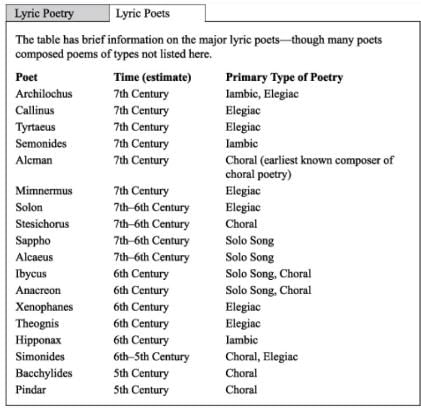 For each of the following statements about a newly discovered poem that was composed in the choliambic meter, select Yes if it can be reasonably inferred from the given information. Otherwise, select No.
For each of the following statements about a newly discovered poem that was composed in the choliambic meter, select Yes if it can be reasonably inferred from the given information. Otherwise, select No.
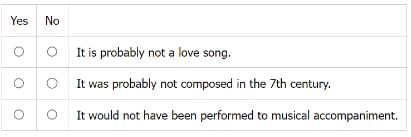
- a)No, Yes, No
- b)Yes, No, Yes
- c)Yes, Yes, Yes
- d)No, No, No
- e)Yes, Yes, No
Correct answer is option 'E'. Can you explain this answer?
Lyric Poetry
A team of classicists is examining some newly discovered manuscripts of ancient Greek lyric poetry, keeping in mind the following background information: Lyric poetry is a broad term used to describe the poems that were not epics or drama, and which were composed from roughly the 7th century BCE through the middle of the 5th century BCE.
The content of these poems spanned a wide range. While the Greck epics and tragedies dealt almost exclusively with the myths of Greece’s past, lyric poetry, though at times using a mythic background, kept its focus mostly on the present. Stylistically, lyric poetry had a wide variety, as well. Choral songs, such as eulogies, dithyrambs, dirges, and victory odes, were performed by a chorus and an accompanying instrument, usually on public occasions. Solo songs, also accompanied by an instrument, were typically of a more personal nature, with love as their chief subject. Alcaeus’ poetry provided a partial exception as solo songs go, for he also composed songs about politics as well as hymns to the gods.
Besides choral and solo songs, lyric poetry included elegiac and iambic poems, which may or may not have been performed to music. Elegiac poems are defined by meter, and the elegiac couplet, and were usually political or ethical exhortations. Iambic poems were usually polemics, or monologues of a satirical or salacious nature, often, but not always, composed in the iambic meter. Archilochus used iambics and trochaics for his poetry, whereas Hipponax was unique in his use of the choliambic meter.
A team of classicists is examining some newly discovered manuscripts of ancient Greek lyric poetry, keeping in mind the following background information: Lyric poetry is a broad term used to describe the poems that were not epics or drama, and which were composed from roughly the 7th century BCE through the middle of the 5th century BCE.
The content of these poems spanned a wide range. While the Greck epics and tragedies dealt almost exclusively with the myths of Greece’s past, lyric poetry, though at times using a mythic background, kept its focus mostly on the present. Stylistically, lyric poetry had a wide variety, as well. Choral songs, such as eulogies, dithyrambs, dirges, and victory odes, were performed by a chorus and an accompanying instrument, usually on public occasions. Solo songs, also accompanied by an instrument, were typically of a more personal nature, with love as their chief subject. Alcaeus’ poetry provided a partial exception as solo songs go, for he also composed songs about politics as well as hymns to the gods.
Besides choral and solo songs, lyric poetry included elegiac and iambic poems, which may or may not have been performed to music. Elegiac poems are defined by meter, and the elegiac couplet, and were usually political or ethical exhortations. Iambic poems were usually polemics, or monologues of a satirical or salacious nature, often, but not always, composed in the iambic meter. Archilochus used iambics and trochaics for his poetry, whereas Hipponax was unique in his use of the choliambic meter.
Lyric Poets


For each of the following statements about a newly discovered poem that was composed in the choliambic meter, select Yes if it can be reasonably inferred from the given information. Otherwise, select No.


a)
No, Yes, No
b)
Yes, No, Yes
c)
Yes, Yes, Yes
d)
No, No, No
e)
Yes, Yes, No

|
EduRev GMAT answered |
Statement 1: Hipponax is mentioned as perhaps the only composer of choliambics, and he was a composer of iambic poetry, which is not love poetry. Thus, this statement can be inferred.
Answer: Yes
Answer: Yes
Statement 2: This statement is inferable: Hipponax lived in the 6th century.
Answer: Yes
Answer: Yes
Statement 3: This statement cannot be inferred. The given information says that iambic poetry may or may not have been performed to music, and since this choliambic poem was probably by Hipponax, who was a composer of iambic poetry, this poem may or may not have been performed to music.
Answer: No
Answer: No
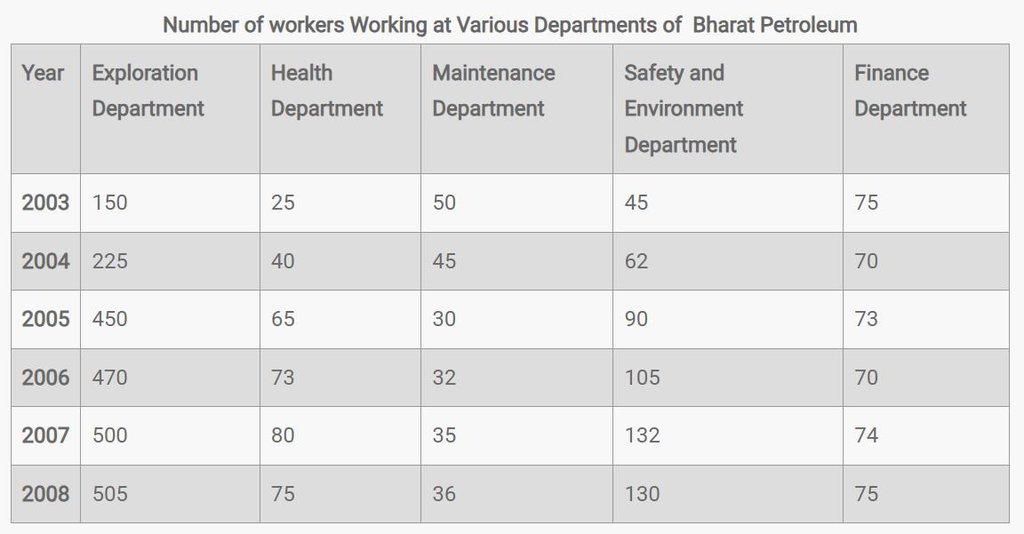
Which year had the total number of workers equal to the total number of workers the factory had in the year 2007?- a)2008
- b)2003
- c)2006
- d)2005
- e)2004
Correct answer is option 'A'. Can you explain this answer?
Which year had the total number of workers equal to the total number of workers the factory had in the year 2007?
a)
2008
b)
2003
c)
2006
d)
2005
e)
2004

|
EduRev GMAT answered |
Total no. of employee the factory had in 2008 = 505 + 75 + 36 + 130 + 75 = 821.
In 2007 the total no. employees = 500 + 80 + 35 + 132 + 74 = 821. This satisfies the given condition.
In 2007 the total no. employees = 500 + 80 + 35 + 132 + 74 = 821. This satisfies the given condition.
Managing Director Message from the Managing Director of a theater company to the Artistic DirectorI have information about six theaters that could be suitable for our upcoming production. Their capacities range from 142 seats to 199 seats, and their rental rates range from $6000 per week to $12,000 per week. Location ac-counts for much of the difference in prices: Theaters in Center City are pricier than the others. On the other hand, we are likely to sell more tickets in a centrally located theater than in one of the others. Judging by our recent productions, I think that we should be able to achieve 50% of our weckly box office potential (that is, 50% of what we would earn in a weck if we sold all tickets to all performances at the maximum price) in Center City. Otherwise, 40% is a more reasonable expectation.Take a look at the attached table for more details.
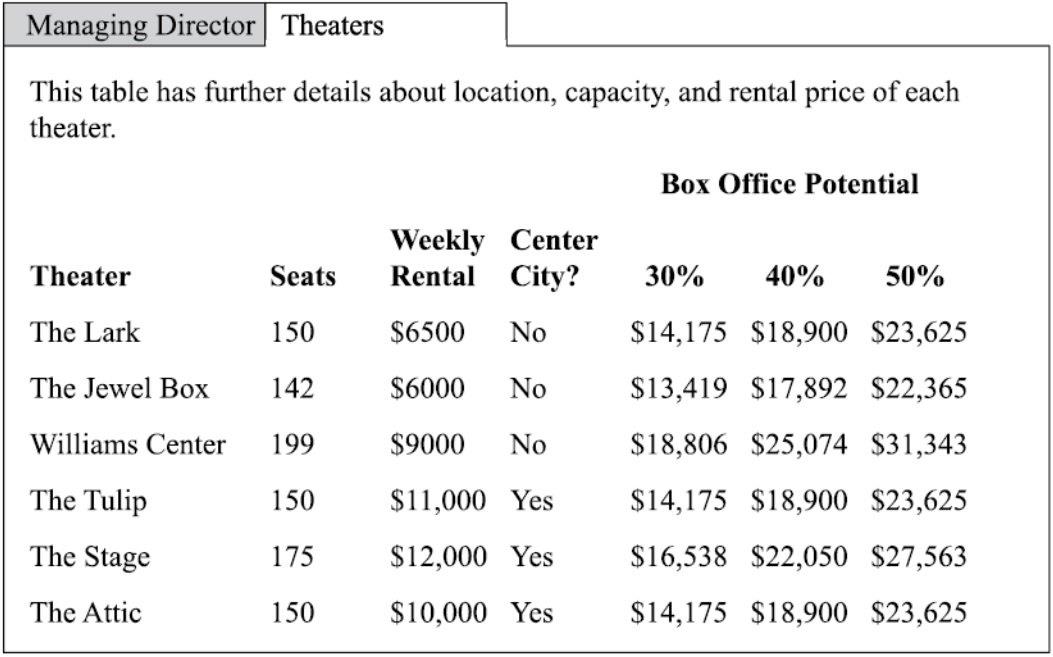 For each of the following theaters, select Yes if the managing director believes it is reasonable that each week the theater company will be able to earn more than $13,000 above the weekly rental price at that theater. Otherwise, select No.
For each of the following theaters, select Yes if the managing director believes it is reasonable that each week the theater company will be able to earn more than $13,000 above the weekly rental price at that theater. Otherwise, select No.
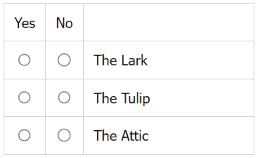
- a)The Lark No, The Tulip No, The Attic No
- b)The Lark Yes, The Tulip No, The Attic Yes
- c)The Lark Yes, The Tulip No, The Attic No
- d)The Lark No, The Tulip No, The Attic Yes
- e)The Lark Yes, The Tulip Yes, The Attic Yes
Correct answer is option 'D'. Can you explain this answer?
Managing Director
Message from the Managing Director of a theater company to the Artistic Director
I have information about six theaters that could be suitable for our upcoming production. Their capacities range from 142 seats to 199 seats, and their rental rates range from $6000 per week to $12,000 per week. Location ac-counts for much of the difference in prices: Theaters in Center City are pricier than the others. On the other hand, we are likely to sell more tickets in a centrally located theater than in one of the others. Judging by our recent productions, I think that we should be able to achieve 50% of our weckly box office potential (that is, 50% of what we would earn in a weck if we sold all tickets to all performances at the maximum price) in Center City. Otherwise, 40% is a more reasonable expectation.
Take a look at the attached table for more details.

For each of the following theaters, select Yes if the managing director believes it is reasonable that each week the theater company will be able to earn more than $13,000 above the weekly rental price at that theater. Otherwise, select No.


a)
The Lark No, The Tulip No, The Attic No
b)
The Lark Yes, The Tulip No, The Attic Yes
c)
The Lark Yes, The Tulip No, The Attic No
d)
The Lark No, The Tulip No, The Attic Yes
e)
The Lark Yes, The Tulip Yes, The Attic Yes

|
EduRev GMAT answered |
The Lark
Weekly Rental = $6500
Revenue @40% as it's not at center = $18900
Weekly Rental = $6500
Revenue @40% as it's not at center = $18900
Amount abover weekly Rental = 18900-6500 = $12400 < $13000 ie. NO
The Tulip
Weekly Rental = $11,000
Revenue @40% as it's not at center = $18900
Weekly Rental = $11,000
Revenue @40% as it's not at center = $18900
Amount abover weekly Rental = 18900-11000 = $7900 < $13000 ie. NO
The Attic
Weekly Rental = $10,000
Revenue @50% as it's at center = $23,625
Weekly Rental = $10,000
Revenue @50% as it's at center = $23,625
Amount abover weekly Rental = 23625-10000 = $13625 > $13000 ie. YES
ABC Office Supply offers a discount on orders over $500. It applies the discount before calculating sales tax. Its most recent orders were for $1,086 and $693 in goods. After ABC applied the discount and added sales tax, the invoices for the two orders showed final charges of $1,106.50 and $706.08, respectively. Determine the discount rate (as a percentage of the order) and the tax rate (as a percentage of the discounted order).
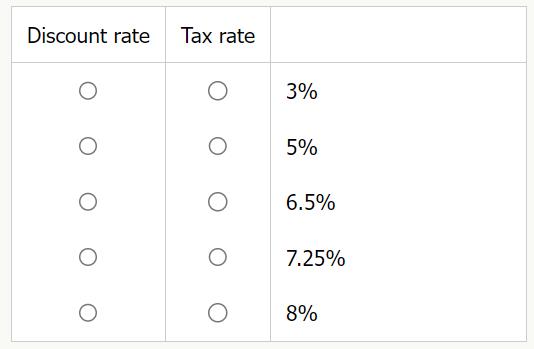 Discount rate: 5% Tax rate: 7.25%
Discount rate: 5% Tax rate: 7.25%- a)Discount rate: 3% Tax rate: 7.25%
- b)Discount rate: 5% Tax rate: 8%
- c)Discount rate: 8% Tax rate: 5%
- d)Discount rate: 5% Tax rate: 3%
- e)Discount rate: 5% Tax rate: 7.25%
Correct answer is option 'E'. Can you explain this answer?
ABC Office Supply offers a discount on orders over $500. It applies the discount before calculating sales tax. Its most recent orders were for $1,086 and $693 in goods. After ABC applied the discount and added sales tax, the invoices for the two orders showed final charges of $1,106.50 and $706.08, respectively. Determine the discount rate (as a percentage of the order) and the tax rate (as a percentage of the discounted order).

Discount rate: 5% Tax rate: 7.25%
a)
Discount rate: 3% Tax rate: 7.25%
b)
Discount rate: 5% Tax rate: 8%
c)
Discount rate: 8% Tax rate: 5%
d)
Discount rate: 5% Tax rate: 3%
e)
Discount rate: 5% Tax rate: 7.25%

|
EduRev GMAT answered |
Both invoices are about 1.9% higher than the price of the goods:

This suggests that the tax rate is higher than the discount rate and that the difference between the rates will be in the neighborhood of 2%. This estimate makes a systematic trial and error possible. Trying a 3% discount and 5% tax comes close but is a bit low. A discount of 5% and a tax rate of 7.25% fits the bill.

This suggests that the tax rate is higher than the discount rate and that the difference between the rates will be in the neighborhood of 2%. This estimate makes a systematic trial and error possible. Trying a 3% discount and 5% tax comes close but is a bit low. A discount of 5% and a tax rate of 7.25% fits the bill.
Chris has the option to order parts from either of two suppliers. Supplier A offers free shipping but prices items an average of 3.5% higher than Supplier B. Supplier B offers the lower prices but will add a shipping charge to all orders. The shipping charge is $7.50 on orders less than $200, $12.50 on orders from $200 to $500, and $15 on orders over $500. Chris finds Supplier A to be more economical for small purchases but wonders if there is an order size for which Supplier B would be cheaper.
Find the smallest value of an order from Supplier A for which an identical order from Supplier B would be cheaper. If an order costs $401.50 from Supplier A, what will the same order cost from Supplier B?
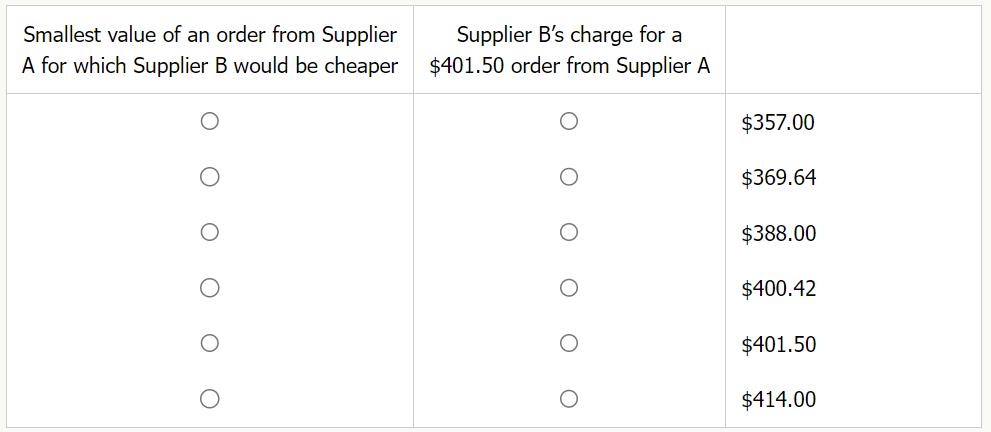
- a)$401.50 , $400.42
- b)$357.14 , $414.00
- c)$357.14 , $400.42
- d)$369.64 , $400.42
- e)$369.64 , $388.00
Correct answer is option 'C'. Can you explain this answer?
Chris has the option to order parts from either of two suppliers. Supplier A offers free shipping but prices items an average of 3.5% higher than Supplier B. Supplier B offers the lower prices but will add a shipping charge to all orders. The shipping charge is $7.50 on orders less than $200, $12.50 on orders from $200 to $500, and $15 on orders over $500. Chris finds Supplier A to be more economical for small purchases but wonders if there is an order size for which Supplier B would be cheaper.
Find the smallest value of an order from Supplier A for which an identical order from Supplier B would be cheaper. If an order costs $401.50 from Supplier A, what will the same order cost from Supplier B?

Find the smallest value of an order from Supplier A for which an identical order from Supplier B would be cheaper. If an order costs $401.50 from Supplier A, what will the same order cost from Supplier B?
a)
$401.50 , $400.42
b)
$357.14 , $414.00
c)
$357.14 , $400.42
d)
$369.64 , $400.42
e)
$369.64 , $388.00

|
EduRev GMAT answered |
(A) Smallest value of an order from Supplier A for which Supplier B would be cheaper
All values are in the range excess of $350; so, the shipping cost (Supplier B) will be $12.50
The smallest value of an order from Supplier A for which Supplier B would be cheaper;
implies 3.5 % excess value (in case of Supplier A) = Shipping charge (Supplier )
ie, 3.5 % of item price = $12.50
Item price = $12.50 / 0.0350
= $357.14
Hence, Order value = $357.14 + 12.50
= $369.64
All values are in the range excess of $350; so, the shipping cost (Supplier B) will be $12.50
The smallest value of an order from Supplier A for which Supplier B would be cheaper;
implies 3.5 % excess value (in case of Supplier A) = Shipping charge (Supplier )
ie, 3.5 % of item price = $12.50
Item price = $12.50 / 0.0350
= $357.14
Hence, Order value = $357.14 + 12.50
= $369.64
(B) Supplier B’s charge for a $401.50 order from Supplier A
If Supplier A charges $401.50 for the order; then
Item price = $401.50 / 1.0350 (since, the order cost will be 3.5% excess for Supplier A)
= $387.92
Hence,
Order Cost for Supplier B = $387.92 + $12.50 (ie, Shipping charge)
= $400.42
If Supplier A charges $401.50 for the order; then
Item price = $401.50 / 1.0350 (since, the order cost will be 3.5% excess for Supplier A)
= $387.92
Hence,
Order Cost for Supplier B = $387.92 + $12.50 (ie, Shipping charge)
= $400.42
STOCKS CLASSIFICATIONHoly Faith Broking Company classifies stocks of listed companies on the basis of two parameters.
Stock Valuation Classification
TOP – ‘TOP’ is termed as the mean of daily values of “highest percentage increase in the stock price over last day’s closing price” over a period.
BOTTOM - ‘BOTTOM’ is termed as the mean of daily values of “lowest percentage increase or highest percent decrease, as the case may be, in the stock price over last day’s closing price” over a period.
Stable Cow - A stock whose TOP is less than 15% and BOTTOM is more than 8%.
Volatile Bull - A stock whose TOP is more than 30% and BOTTOM is less than 10%.
Volatile Bear - A stock whose TOP is less than 10% and BOTTOM is less than -10%.
Profit Generation Capability
Struggler - A stock whose issuing company makes a profit between 1% to 5% of its revenue. (Both inclusive)
Dessert - A stock whose issuing company makes a loss of more than 1% of its revenue.
Rain Maker - A stock whose issuing company makes a profit of more than 10% of its revenue.CHARTS
The two graphs given below are for stocks of companies A, B, C, and D. The first graph shows mean of daily values of “percentage increase or decrease in the stock price over last day’s closing price” over a period. The second graph represents revenue to expense ratio (data label on the bubble) & revenue for these four companies. Centers of bubbles represent revenue of the company (on Y axis).
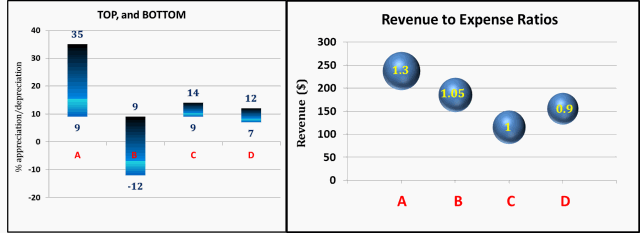 Select the company pair below whose combined revenue to combined expense ratio is the least?
Select the company pair below whose combined revenue to combined expense ratio is the least?
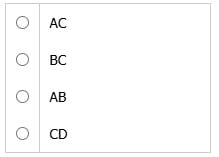
- a)AC
- b)CD
- c)BC
- d)AB
Correct answer is option 'B'. Can you explain this answer?
STOCKS CLASSIFICATION
Holy Faith Broking Company classifies stocks of listed companies on the basis of two parameters.
Stock Valuation Classification
TOP – ‘TOP’ is termed as the mean of daily values of “highest percentage increase in the stock price over last day’s closing price” over a period.
BOTTOM - ‘BOTTOM’ is termed as the mean of daily values of “lowest percentage increase or highest percent decrease, as the case may be, in the stock price over last day’s closing price” over a period.
Stable Cow - A stock whose TOP is less than 15% and BOTTOM is more than 8%.
Volatile Bull - A stock whose TOP is more than 30% and BOTTOM is less than 10%.
Volatile Bear - A stock whose TOP is less than 10% and BOTTOM is less than -10%.
Profit Generation Capability
Struggler - A stock whose issuing company makes a profit between 1% to 5% of its revenue. (Both inclusive)
Dessert - A stock whose issuing company makes a loss of more than 1% of its revenue.
Rain Maker - A stock whose issuing company makes a profit of more than 10% of its revenue.
Stock Valuation Classification
TOP – ‘TOP’ is termed as the mean of daily values of “highest percentage increase in the stock price over last day’s closing price” over a period.
BOTTOM - ‘BOTTOM’ is termed as the mean of daily values of “lowest percentage increase or highest percent decrease, as the case may be, in the stock price over last day’s closing price” over a period.
Stable Cow - A stock whose TOP is less than 15% and BOTTOM is more than 8%.
Volatile Bull - A stock whose TOP is more than 30% and BOTTOM is less than 10%.
Volatile Bear - A stock whose TOP is less than 10% and BOTTOM is less than -10%.
Profit Generation Capability
Struggler - A stock whose issuing company makes a profit between 1% to 5% of its revenue. (Both inclusive)
Dessert - A stock whose issuing company makes a loss of more than 1% of its revenue.
Rain Maker - A stock whose issuing company makes a profit of more than 10% of its revenue.
CHARTS
The two graphs given below are for stocks of companies A, B, C, and D. The first graph shows mean of daily values of “percentage increase or decrease in the stock price over last day’s closing price” over a period. The second graph represents revenue to expense ratio (data label on the bubble) & revenue for these four companies. Centers of bubbles represent revenue of the company (on Y axis).

The two graphs given below are for stocks of companies A, B, C, and D. The first graph shows mean of daily values of “percentage increase or decrease in the stock price over last day’s closing price” over a period. The second graph represents revenue to expense ratio (data label on the bubble) & revenue for these four companies. Centers of bubbles represent revenue of the company (on Y axis).

Select the company pair below whose combined revenue to combined expense ratio is the least?


a)
AC
b)
CD
c)
BC
d)
AB

|
EduRev GMAT answered |
We should be wary of the fact that the question asks for combined revenue to combined expense ratio. We must not simply add their R/E ratios. From chart 2, we get their respective R/E values.
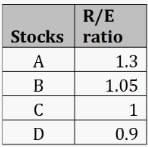
We need not calculate combined revenue and combined expense for each of the options. Logically, R/E ratios for C and D lie in bottom two, hence their combined revenue, and combined expense will also be least. So the answer is CD. The table below shows that combined revenue to combined expense ratio for CD will be the lowest. It lies between 1~0.9.
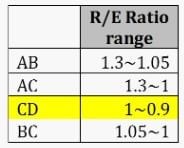

We need not calculate combined revenue and combined expense for each of the options. Logically, R/E ratios for C and D lie in bottom two, hence their combined revenue, and combined expense will also be least. So the answer is CD. The table below shows that combined revenue to combined expense ratio for CD will be the lowest. It lies between 1~0.9.

A company that designs websites primarily for minority-owned businesses conducted a survey of minority-owned businesses in the United States that do not currently have a website. The survey was designed to help determine what respondents see as the potential benefits of adding a website. The results of that survey are shown in the table.
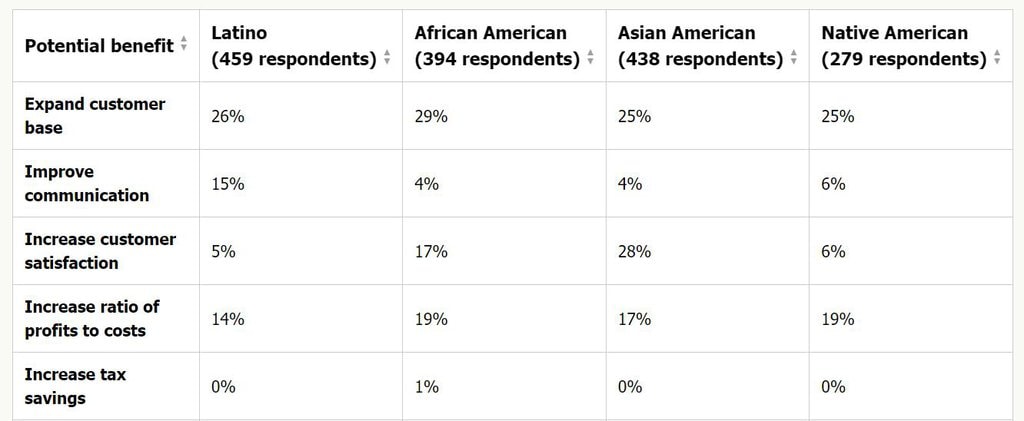
 For each of the following conclusions, select Supported if it is supported by the information in the table. Otherwise, select Not supported.
For each of the following conclusions, select Supported if it is supported by the information in the table. Otherwise, select Not supported.

- a)Supported, Supported, Not supported
- b)Not supported, Supported, Not supported
- c)Supported, Not supported, Not supported
- d)Not supported, Not supported, Not supported
- e)Supported, Supported, Supported
Correct answer is option 'A'. Can you explain this answer?
A company that designs websites primarily for minority-owned businesses conducted a survey of minority-owned businesses in the United States that do not currently have a website. The survey was designed to help determine what respondents see as the potential benefits of adding a website. The results of that survey are shown in the table.


For each of the following conclusions, select Supported if it is supported by the information in the table. Otherwise, select Not supported.
a)
Supported, Supported, Not supported
b)
Not supported, Supported, Not supported
c)
Supported, Not supported, Not supported
d)
Not supported, Not supported, Not supported
e)
Supported, Supported, Supported

|
EduRev GMAT answered |
A majority of the respondents believe adding a website could benefit their businesses.: Supported
Fewer than 25% of the respondents who believe a website could help expand their customer base also believe a website could help them maintain their current market share.: Supported
Only a small proportion of the respondents are concerned that they are losing market share.: Not supported
Fewer than 25% of the respondents who believe a website could help expand their customer base also believe a website could help them maintain their current market share.: Supported
Only a small proportion of the respondents are concerned that they are losing market share.: Not supported
a, b, k, s are different non-zero integers, 2/a + 4/b = k/s and k/s is maximally reduced. Does s = ab?1. a and b are primes
2. a and b have gcd = 1- a)Statement 1 alone is sufficient, but Statement 2 alone is not.
- b)Statement 2 alone is sufficient, but Statement 1 alone is not.
- c)Both statements together are sufficient, but neither alone is sufficient.
- d)Each statement alone is sufficient.
- e)Neither statement is sufficient.
Correct answer is option 'D'. Can you explain this answer?
a, b, k, s are different non-zero integers, 2/a + 4/b = k/s and k/s is maximally reduced. Does s = ab?
1. a and b are primes
2. a and b have gcd = 1
2. a and b have gcd = 1
a)
Statement 1 alone is sufficient, but Statement 2 alone is not.
b)
Statement 2 alone is sufficient, but Statement 1 alone is not.
c)
Both statements together are sufficient, but neither alone is sufficient.
d)
Each statement alone is sufficient.
e)
Neither statement is sufficient.

|
EduRev GMAT answered |

Since k/s in its simplest form, s must be the denominator in its irreducible form, which is ab/gcd(2b + 4a,ab).
Statement 1: If a and b are primes, their product ab has no common factors with 2a + 4b (except possibly 2, but that won't affect the full fraction’s reducibility). Hence, s = ab.
Statement 2: If gcd (a, b) = 1, the same reasoning applies, as gcd(2b + 4a, ab) will still be 1. Thus, s = ab.
Since each statement alone guarantees the answer, the correct choice is D.
Since each statement alone guarantees the answer, the correct choice is D.
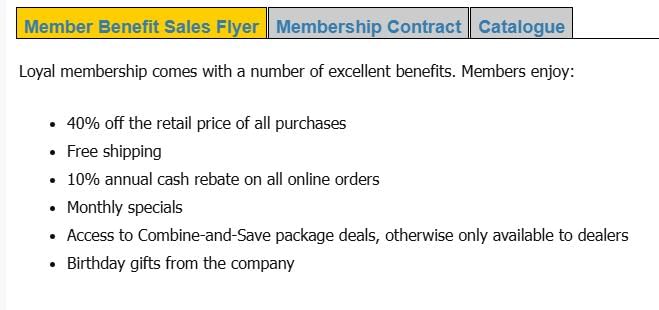
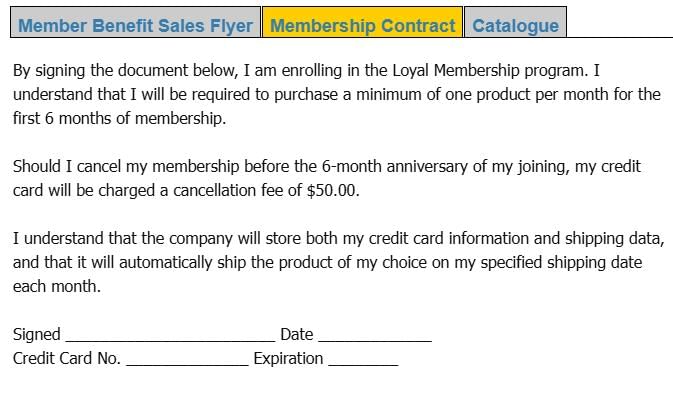
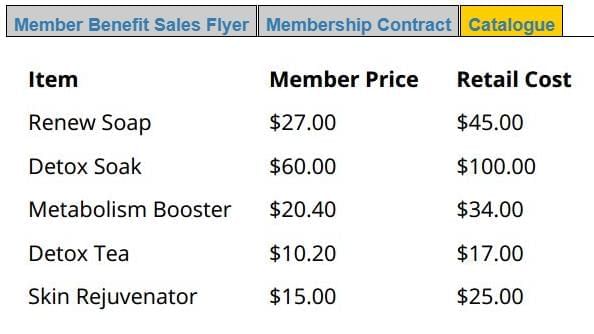
Consider each of the following statements. Does the information in the three sources support the inference as stated?

- a)Part 1: No
Part 2: No
Part 3: No - b)Part 1: Yes
Part 2: No
Part 3:Yes - c)Part 1: No
Part 2: Yes
Part 3:No - d)Part 1: Yes
Part 2: Yes
Part 3: Yes - e)Part 1: NO
Part 2: NO
Part 3: Yes
Correct answer is option 'A'. Can you explain this answer?



Consider each of the following statements. Does the information in the three sources support the inference as stated?

a)
Part 1: No
Part 2: No
Part 3: No
Part 2: No
Part 3: No
b)
Part 1: Yes
Part 2: No
Part 3:Yes
Part 2: No
Part 3:Yes
c)
Part 1: No
Part 2: Yes
Part 3:No
Part 2: Yes
Part 3:No
d)
Part 1: Yes
Part 2: Yes
Part 3: Yes
Part 2: Yes
Part 3: Yes
e)
Part 1: NO
Part 2: NO
Part 3: Yes
Part 2: NO
Part 3: Yes

|
EduRev GMAT answered |
Part 1: The median retail cost of the product line is $20.40.
The median retail cost of product is $34.
Hence, the answer is No.
Part 2: Loyal members who purchase online save more than 50% off the cost of their total purchases and shipping compared to nonmembers.
Let x be the shipping cost.
Let's consider a member and a non member purchase 1 unit of Renew Soap.
Cost for member = 27
Cost for non member = 45 + x
Savings of a member compared to a non member = 18 + x
Translating the question statement: Is (18 + x) more than 50% of (45 + x)
Is (18 + x) > (45 + x)/2
Is (18+x)/(45+x) > 1/2
We can clearly see that the answer is No.
Hence, the final answer is No.
Part 3: The minimum purchase amount within the 6-month introductory period is less than the $50.00 charge issued to accounts that are canceled early.
The minimum amount within the 6 month introductory period = Price of Detox Tea * 6 = 10.2 *6 = $61.2
Hence, the answer is No.
The median retail cost of product is $34.
Hence, the answer is No.
Part 2: Loyal members who purchase online save more than 50% off the cost of their total purchases and shipping compared to nonmembers.
Let x be the shipping cost.
Let's consider a member and a non member purchase 1 unit of Renew Soap.
Cost for member = 27
Cost for non member = 45 + x
Savings of a member compared to a non member = 18 + x
Translating the question statement: Is (18 + x) more than 50% of (45 + x)
Is (18 + x) > (45 + x)/2
Is (18+x)/(45+x) > 1/2
We can clearly see that the answer is No.
Hence, the final answer is No.
Part 3: The minimum purchase amount within the 6-month introductory period is less than the $50.00 charge issued to accounts that are canceled early.
The minimum amount within the 6 month introductory period = Price of Detox Tea * 6 = 10.2 *6 = $61.2
Hence, the answer is No.

The graph shows the percentage of children in particular grade levels that participated in the six afterschool activities offered by a school in 2017. No child was allowed to participate in more than one sport activity (soccer, tennis, track) or more than one non-sport activity (math team, band, debate team) but children were allowed to participate in one activity from each category (sport or non-sport). Every child had to participate in at least one of the six activities.For each of the following, use the drop-down menu to create the most accurate statement on the basis of the chart:
3. Approximately ______ percent of 8th graders in 2017 participated in exactly one of the six after-school activities.
4. In 2017 there ______ in which more students participated in sport activities than non-sport activities.- a)Blank 1: 5
Blank 2: were no grade levels - b)Blank 1: 10
Blank 2: was one grade level - c)Blank 1: 15
Blank 2: were two grade levels - d)Blank 1: 15
Blank 2: were three grade levels - e)Blank 1: 20
Blank 2: were four grade levels
Correct answer is option 'C'. Can you explain this answer?
The graph shows the percentage of children in particular grade levels that participated in the six afterschool activities offered by a school in 2017. No child was allowed to participate in more than one sport activity (soccer, tennis, track) or more than one non-sport activity (math team, band, debate team) but children were allowed to participate in one activity from each category (sport or non-sport). Every child had to participate in at least one of the six activities.
For each of the following, use the drop-down menu to create the most accurate statement on the basis of the chart:
3. Approximately ______ percent of 8th graders in 2017 participated in exactly one of the six after-school activities.
4. In 2017 there ______ in which more students participated in sport activities than non-sport activities.
3. Approximately ______ percent of 8th graders in 2017 participated in exactly one of the six after-school activities.
4. In 2017 there ______ in which more students participated in sport activities than non-sport activities.
a)
Blank 1: 5
Blank 2: were no grade levels
Blank 2: were no grade levels
b)
Blank 1: 10
Blank 2: was one grade level
Blank 2: was one grade level
c)
Blank 1: 15
Blank 2: were two grade levels
Blank 2: were two grade levels
d)
Blank 1: 15
Blank 2: were three grade levels
Blank 2: were three grade levels
e)
Blank 1: 20
Blank 2: were four grade levels
Blank 2: were four grade levels

|
EduRev GMAT answered |
- Approximately 15 percent of 8th graders in 2017 participated in exactly one of the six after-school activities:
- From the graph, the percentage of 8th graders participating in one activity is approximately 15%. This corresponds to Blank 1.
- In 2017, there were two grade levels in which more students participated in sport activities than non-sport activities:
- The two grade levels where more students participated in sports activities (soccer, tennis, or track) than non-sport activities (math team, band, or debate team) are the 7th grade and 12th grade. Hence, Blank 2 is "were two grade levels".
The correct answer is Option C:
Blank 1: 15
Blank 2: were two grade levels
Poisoning from ingesting poisonous plants or mushrooms is a common issue, with particular significance in certain regions. For instance, tropical areas often serve as hotspots due to the prevalence of native poisonous plant species, sometimes used intentionally. In temperate regions, such as Europe and parts of North America, mushroom poisoning frequently results from accidental misidentification during foraging or wild cultivation. Certain types of plant or mushroom poisoning have relatively high fatality rates, particularly in cases of delayed treatment. However, these fatality rates vary by region; in some Western countries, the fatality rate for mushroom poisoning is relatively low.
Based on this information, select for Poisoning by mushrooms the statement that describes the situation in which an individual is most at risk of poisoning by mushrooms, and select for Poisoning by plants the statement that describes the situation in which an individual is most at risk of poisoning by plants. Make only two selections, one for each column.

- a)Poisoning by mushrooms: A person in a rural area of Europe collecting mushrooms from the wilderness and using them to prepare a salad for his family.
Poisoning by Plants: A person in an equatorial forest consuming tree bark he personally identified as possibly having hallucinogenic properties during a self-guided tour. - b)Poisoning by mushrooms: A person in Eastern Asia eating soup that contains rare and exotic vegetables prepared by an experienced chef.
Poisoning by Plants: A person in an equatorial forest consuming tree bark he personally identified as possibly having hallucinogenic properties during a self-guided tour. - c)Poisoning by mushrooms: A person in a rural area of Europe collecting mushrooms from the wilderness and using them to prepare a salad for his family.
Poisoning by Plants: A person in Eastern Asia eating soup that contains rare and exotic vegetables prepared by an experienced chef. - d)Poisoning by mushrooms: A person in Eastern Asia eating soup that contains rare and exotic vegetables prepared by an experienced chef.
Poisoning by Plants: A person in Eastern Asia eating soup that contains rare and exotic vegetables prepared by an experienced chef. - e)Poisoning by mushrooms A person in North America observing from a distance the ritual burning of fungi, including a type of toxic mushroom.
Poisoning by Plants: A person in Sicily, who is allergic to mushrooms, requesting mushrooms to be removed from a pizza before eating.
Correct answer is option 'A'. Can you explain this answer?
Poisoning from ingesting poisonous plants or mushrooms is a common issue, with particular significance in certain regions. For instance, tropical areas often serve as hotspots due to the prevalence of native poisonous plant species, sometimes used intentionally. In temperate regions, such as Europe and parts of North America, mushroom poisoning frequently results from accidental misidentification during foraging or wild cultivation. Certain types of plant or mushroom poisoning have relatively high fatality rates, particularly in cases of delayed treatment. However, these fatality rates vary by region; in some Western countries, the fatality rate for mushroom poisoning is relatively low.
Based on this information, select for Poisoning by mushrooms the statement that describes the situation in which an individual is most at risk of poisoning by mushrooms, and select for Poisoning by plants the statement that describes the situation in which an individual is most at risk of poisoning by plants. Make only two selections, one for each column.

Based on this information, select for Poisoning by mushrooms the statement that describes the situation in which an individual is most at risk of poisoning by mushrooms, and select for Poisoning by plants the statement that describes the situation in which an individual is most at risk of poisoning by plants. Make only two selections, one for each column.

a)
Poisoning by mushrooms: A person in a rural area of Europe collecting mushrooms from the wilderness and using them to prepare a salad for his family.
Poisoning by Plants: A person in an equatorial forest consuming tree bark he personally identified as possibly having hallucinogenic properties during a self-guided tour.
Poisoning by Plants: A person in an equatorial forest consuming tree bark he personally identified as possibly having hallucinogenic properties during a self-guided tour.
b)
Poisoning by mushrooms: A person in Eastern Asia eating soup that contains rare and exotic vegetables prepared by an experienced chef.
Poisoning by Plants: A person in an equatorial forest consuming tree bark he personally identified as possibly having hallucinogenic properties during a self-guided tour.
Poisoning by Plants: A person in an equatorial forest consuming tree bark he personally identified as possibly having hallucinogenic properties during a self-guided tour.
c)
Poisoning by mushrooms: A person in a rural area of Europe collecting mushrooms from the wilderness and using them to prepare a salad for his family.
Poisoning by Plants: A person in Eastern Asia eating soup that contains rare and exotic vegetables prepared by an experienced chef.
Poisoning by Plants: A person in Eastern Asia eating soup that contains rare and exotic vegetables prepared by an experienced chef.
d)
Poisoning by mushrooms: A person in Eastern Asia eating soup that contains rare and exotic vegetables prepared by an experienced chef.
Poisoning by Plants: A person in Eastern Asia eating soup that contains rare and exotic vegetables prepared by an experienced chef.
Poisoning by Plants: A person in Eastern Asia eating soup that contains rare and exotic vegetables prepared by an experienced chef.
e)
Poisoning by mushrooms A person in North America observing from a distance the ritual burning of fungi, including a type of toxic mushroom.
Poisoning by Plants: A person in Sicily, who is allergic to mushrooms, requesting mushrooms to be removed from a pizza before eating.
Poisoning by Plants: A person in Sicily, who is allergic to mushrooms, requesting mushrooms to be removed from a pizza before eating.

|
EduRev GMAT answered |
Poisoning by mushrooms
- A person in a rural area of Europe collecting mushrooms from the wilderness and using them to prepare a salad for his family.
Foraging wild mushrooms poses a high risk of poisoning due to potential misidentification, a common cause of mushroom poisoning in temperate regions.
Poisoning by plants
- A person in an equatorial forest consuming tree bark he personally identified as possibly having hallucinogenic properties during a self-guided tour.
There is a high risk of poisoning because self-identifying and consuming tree bark, especially in an equatorial forest with potentially unfamiliar plant species, is inherently dangerous.
Analysis of other options
- A person in Eastern Asia eating soup that contains rare and exotic vegetables prepared by an experienced chef.
There is a low risk of poisoning because an experienced chef is unlikely to use toxic ingredients, even in a soup containing rare or exotic vegetables.
- A person in Sicily, who is allergic to mushrooms, requesting mushrooms to be removed from a pizza before eating.
There is no risk of poisoning because mushrooms are avoided entirely, making this irrelevant for both mushroom and plant poisoning.
- A person in North America observing the ritual burning of fungi, including a type of mushroom known to be highly toxic.
There is a low risk of poisoning because observing from a distance minimizes exposure to any potentially harmful fumes, making this largely irrelevant for both mushroom and plant poisoning.
Correct answer:
Poisoning by mushrooms "A person in a rural area of Europe collecting mushrooms from the wilderness and using them to prepare a salad for his family."
Poisoning by Plants "A person in an equatorial forest consuming tree bark he personally identified as possibly having hallucinogenic properties during a self-guided tour."
The 400 students at Watermelon Sugar High School can choose up to 3 electives from the following classes: an art class, a business class, and a computer class. Half of the students chose the art class, half of the students chose the business class, and half of the students chose the computer class.
If 96 of the students have signed up for all three electives, select from the available options the least possible and greatest possible number of students who could have signed up for exactly two of the three electives. Make only two selections, one in each column.
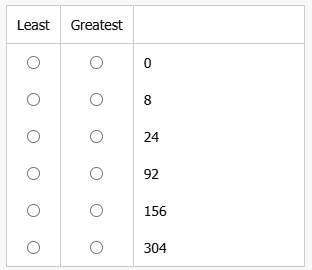
- a)Least: 8
Greatest: 156 - b)Least: 10
Greatest: 200 - c)Least: 12
Greatest: 205 - d)Least: 15
Greatest: 250
Correct answer is option 'A'. Can you explain this answer?
The 400 students at Watermelon Sugar High School can choose up to 3 electives from the following classes: an art class, a business class, and a computer class. Half of the students chose the art class, half of the students chose the business class, and half of the students chose the computer class.
If 96 of the students have signed up for all three electives, select from the available options the least possible and greatest possible number of students who could have signed up for exactly two of the three electives. Make only two selections, one in each column.

If 96 of the students have signed up for all three electives, select from the available options the least possible and greatest possible number of students who could have signed up for exactly two of the three electives. Make only two selections, one in each column.

a)
Least: 8
Greatest: 156
Greatest: 156
b)
Least: 10
Greatest: 200
Greatest: 200
c)
Least: 12
Greatest: 205
Greatest: 205
d)
Least: 15
Greatest: 250
Greatest: 250

|
EduRev GMAT answered |
Total = P(A) + P(B) + P(C) - P(A and B) - P(B and C) - P(A and C) - 2*P(A and B and C)
400 = 200 + 200 + 200 - P(A and B) - P(B and C) - P(A and C) - 2 * 96
P(A and B) + P(B and C) + P(A and C) = 8
This is the minimum value required to satisfy the given numbers.
To maximize, all singular selections set should be 0,
P(A) = P(singular A) + P(A and B) + P(A and C) + P(A and B and C)
200 = 0 + P(A and B) + P(A and C) + 96
P(A and B) + P(A and C) = 104 --- (1)
similarly,
P(B and C) + P(A and C) = 104 --- (2)
P(A and B) + P(B and C) = 104 --- (3)
From (1), (2) and (3), summing up,
2(P(A and B) + P(A and C) + P(B and C)) = 312
P(A and B) + P(A and C) + P(B and C) = 156
Hence, least value is 8 and greatest value is 156.
400 = 200 + 200 + 200 - P(A and B) - P(B and C) - P(A and C) - 2 * 96
P(A and B) + P(B and C) + P(A and C) = 8
This is the minimum value required to satisfy the given numbers.
To maximize, all singular selections set should be 0,
P(A) = P(singular A) + P(A and B) + P(A and C) + P(A and B and C)
200 = 0 + P(A and B) + P(A and C) + 96
P(A and B) + P(A and C) = 104 --- (1)
similarly,
P(B and C) + P(A and C) = 104 --- (2)
P(A and B) + P(B and C) = 104 --- (3)
From (1), (2) and (3), summing up,
2(P(A and B) + P(A and C) + P(B and C)) = 312
P(A and B) + P(A and C) + P(B and C) = 156
Hence, least value is 8 and greatest value is 156.
A gallery displayed and sold works of art by five different artists. The table gives a list of all the pieces that were displayed.
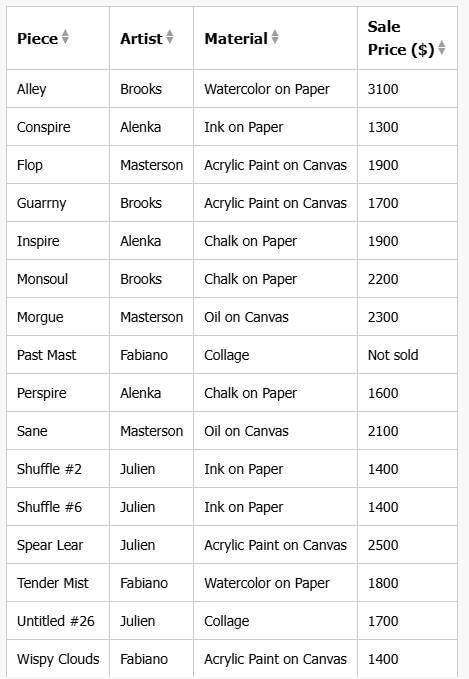
(Sort ↕ the table by clicking on the headers)For each of the following statements, select Yes if the statement is true based on the information in the table. Otherwise, select No.

- a)No: The median sale price among the pieces that sold was $1850.
No: If a piece sold for more than $2000, the probability that it was by Masterson was 33%.
Yes: Works on canvas sold for a higher average price than did works on paper. - b)No: The median sale price among the pieces that sold was $1850.
No: Works on canvas sold for a higher average price than did works on paper.
Yes: If a piece sold for more than $2000, the probability that it was by Masterson was 33%. - c)No: If a piece sold for more than $2000, the probability that it was by Masterson was 33%.
No: Works on canvas sold for a higher average price than did works on paper.
Yes: The median sale price among the pieces that sold was $1850. - d)No: If a piece sold for more than $2000, the probability that it was by Masterson was 33%.
No: The median sale price among the pieces that sold was $1850.
Yes: Works on canvas sold for a higher average price than did works on paper.
Correct answer is option 'A'. Can you explain this answer?
A gallery displayed and sold works of art by five different artists. The table gives a list of all the pieces that were displayed.

(Sort ↕ the table by clicking on the headers)

(Sort ↕ the table by clicking on the headers)
For each of the following statements, select Yes if the statement is true based on the information in the table. Otherwise, select No.


a)
No: The median sale price among the pieces that sold was $1850.
No: If a piece sold for more than $2000, the probability that it was by Masterson was 33%.
Yes: Works on canvas sold for a higher average price than did works on paper.
No: If a piece sold for more than $2000, the probability that it was by Masterson was 33%.
Yes: Works on canvas sold for a higher average price than did works on paper.
b)
No: The median sale price among the pieces that sold was $1850.
No: Works on canvas sold for a higher average price than did works on paper.
Yes: If a piece sold for more than $2000, the probability that it was by Masterson was 33%.
No: Works on canvas sold for a higher average price than did works on paper.
Yes: If a piece sold for more than $2000, the probability that it was by Masterson was 33%.
c)
No: If a piece sold for more than $2000, the probability that it was by Masterson was 33%.
No: Works on canvas sold for a higher average price than did works on paper.
Yes: The median sale price among the pieces that sold was $1850.
No: Works on canvas sold for a higher average price than did works on paper.
Yes: The median sale price among the pieces that sold was $1850.
d)
No: If a piece sold for more than $2000, the probability that it was by Masterson was 33%.
No: The median sale price among the pieces that sold was $1850.
Yes: Works on canvas sold for a higher average price than did works on paper.
No: The median sale price among the pieces that sold was $1850.
Yes: Works on canvas sold for a higher average price than did works on paper.

|
EduRev GMAT answered |
Statement 1: Fifteen of the 16 pieces sold. The eighth highest sale price is the median of the set of sale prices. This price is $1800.
Answer: No
Statement 2: The probability that a piece by Masterson sold for more than $2000 is 33%, but that’s not what the question is asking. Five pieces in total sold for more than $2000, and two of them were by Masterson, so the probability is 2 out of 5, or 40%.
Answer: No
Statement 3: This will take some doing, since there’s no neat way to sort the table in order to get all the canvas and paper works grouped neatly together. It is also not easy to eyeball the table and judge whether paper or canvas works had a higher average sale price so you should calculate the actual averages. Sorting by material helps a little. Six pieces were on canvas. Their average sale price was:

Answer: Yes
Answer: No
Statement 2: The probability that a piece by Masterson sold for more than $2000 is 33%, but that’s not what the question is asking. Five pieces in total sold for more than $2000, and two of them were by Masterson, so the probability is 2 out of 5, or 40%.
Answer: No
Statement 3: This will take some doing, since there’s no neat way to sort the table in order to get all the canvas and paper works grouped neatly together. It is also not easy to eyeball the table and judge whether paper or canvas works had a higher average sale price so you should calculate the actual averages. Sorting by material helps a little. Six pieces were on canvas. Their average sale price was:

Answer: Yes
The operation denoted by the symbol # is defined for all real numbers p and r as p#r equals the larger of p and r. For example, 5#3 = 5. Which one of the distinct numbers x, y and z is the largest?
(1) (x#y)#z = x#z
(2) (x#z)#y = z#y- a)Statement (1) ALONE is sufficient, but statement (2) alone is not sufficient to answer the question asked.
- b)Statement (2) ALONE is sufficient, but statement (1) alone is not sufficient to answer the question asked.
- c)BOTH statements (1) and (2) TOGETHER are sufficient to answer the question asked, but NEITHER statement ALONE is sufficient to answer the question ask
- d)EACH statement ALONE is sufficient to answer the question asked.
- e)Statements (1) and (2) TOGETHER are NOT sufficient to answer the question asked, and additional data specific to the problem are needed.
Correct answer is option 'C'. Can you explain this answer?
The operation denoted by the symbol # is defined for all real numbers p and r as p#r equals the larger of p and r. For example, 5#3 = 5. Which one of the distinct numbers x, y and z is the largest?
(1) (x#y)#z = x#z
(2) (x#z)#y = z#y
(1) (x#y)#z = x#z
(2) (x#z)#y = z#y
a)
Statement (1) ALONE is sufficient, but statement (2) alone is not sufficient to answer the question asked.
b)
Statement (2) ALONE is sufficient, but statement (1) alone is not sufficient to answer the question asked.
c)
BOTH statements (1) and (2) TOGETHER are sufficient to answer the question asked, but NEITHER statement ALONE is sufficient to answer the question ask
d)
EACH statement ALONE is sufficient to answer the question asked.
e)
Statements (1) and (2) TOGETHER are NOT sufficient to answer the question asked, and additional data specific to the problem are needed.

|
EduRev GMAT answered |
(1) When X and Y are together: X turns out to be greater than Y, hence we get to see X#Z on the RHS so X>Y but no information on relation of X and Z - INSUFFICIENT
(2) When X and Z are together: Z turns out to be greater than X, hence we get to see Z#Y on the RHS so Z>X but no information on relation of Z and Y - INSUFFICIENT
Considering both - So X>Y and Z>X hence the relation is Z>X>Y
(2) When X and Z are together: Z turns out to be greater than X, hence we get to see Z#Y on the RHS so Z>X but no information on relation of Z and Y - INSUFFICIENT
Considering both - So X>Y and Z>X hence the relation is Z>X>Y
Multiple Sleep Latency TestThe multiple sleep latency test (MSLT) is the most widely used objective assessment procedure for excessive daytime sleepiness. It consists of a series of five nap opportunities given every two hours in a sleep laboratory. The patient lies in a darkened, sound-attenuated room for up to 20 minutes and is instructed to fall asleep. The average latency to sleep onset over all nap opportunities provides an index of sleep propensity.
As a general guideline, only mean sleep latencies shorter than 8 minutes on an MSLT are considered abnormal, and latencies shorter than 5 minutes are taken to indicate severe excessive daytime sleepiness. A patient with a mean sleep latency of 2 minutes or less on an MSLT is unlikely to be exaggerating a complaint of excessive daytime sleepiness, to suffer from fatigue rather than sleepiness, or to be free of any sleep disorder.Patient Data - Ramesh is a 34-year-old man with no major health problems who takes no prescription medicines.
- Sara is a 23-year-old woman with asthma who takes a prescription stimulant daily for treatment.
- Angel is a 72-year-old woman with major depressive disorder who takes a prescription anti-depressant daily.
- John is an 11-year-old child who has been diagnosed with ADD, but does not take any prescription medications.
- Steve is a 54-year-old man with mild heart disease who takes several over-the-counter supplements.
MSLT Results
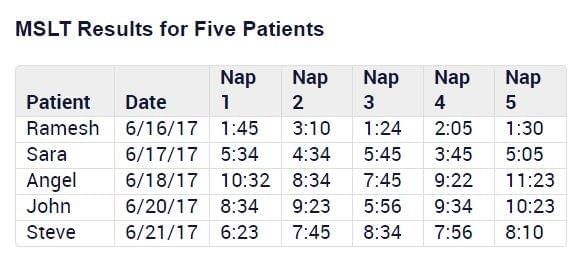
NOTE: Data given is time until sleep in minutes and seconds. Results may be misleading if they are affected by patient age (different criteria apply for children under 16), noise in the sleep center, patient anxiety during the test, or atypical sleep on the previous night. Use of prescription medications such as stimulants or antidepressants can also lead to misleading results.Based on the information presented, some of the patients have MSLT data that could be misleading and others do not. For the following statements, select Yes if the scenario provided would change that status for any of the five patients. Otherwise select No.
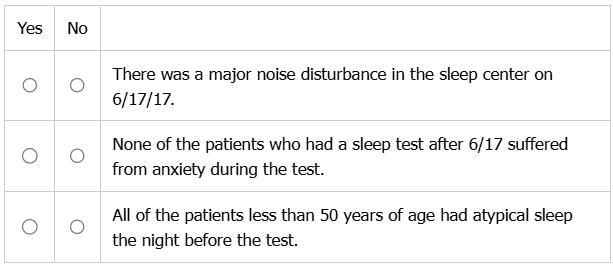
- a)Part 1: Yes
Part 2: No
Part 3: Yes - b)Part 1: No
Part 2: No
Part 3: Yes - c)Part 1: Yes
Part 2: Yes
Part 3: Yes - d)Part 1: No
Part 2: No
Part 3: Yes
Correct answer is option 'B'. Can you explain this answer?
Multiple Sleep Latency Test
The multiple sleep latency test (MSLT) is the most widely used objective assessment procedure for excessive daytime sleepiness. It consists of a series of five nap opportunities given every two hours in a sleep laboratory. The patient lies in a darkened, sound-attenuated room for up to 20 minutes and is instructed to fall asleep. The average latency to sleep onset over all nap opportunities provides an index of sleep propensity.
As a general guideline, only mean sleep latencies shorter than 8 minutes on an MSLT are considered abnormal, and latencies shorter than 5 minutes are taken to indicate severe excessive daytime sleepiness. A patient with a mean sleep latency of 2 minutes or less on an MSLT is unlikely to be exaggerating a complaint of excessive daytime sleepiness, to suffer from fatigue rather than sleepiness, or to be free of any sleep disorder.
As a general guideline, only mean sleep latencies shorter than 8 minutes on an MSLT are considered abnormal, and latencies shorter than 5 minutes are taken to indicate severe excessive daytime sleepiness. A patient with a mean sleep latency of 2 minutes or less on an MSLT is unlikely to be exaggerating a complaint of excessive daytime sleepiness, to suffer from fatigue rather than sleepiness, or to be free of any sleep disorder.
Patient Data
- Ramesh is a 34-year-old man with no major health problems who takes no prescription medicines.
- Sara is a 23-year-old woman with asthma who takes a prescription stimulant daily for treatment.
- Angel is a 72-year-old woman with major depressive disorder who takes a prescription anti-depressant daily.
- John is an 11-year-old child who has been diagnosed with ADD, but does not take any prescription medications.
- Steve is a 54-year-old man with mild heart disease who takes several over-the-counter supplements.
MSLT Results

NOTE: Data given is time until sleep in minutes and seconds. Results may be misleading if they are affected by patient age (different criteria apply for children under 16), noise in the sleep center, patient anxiety during the test, or atypical sleep on the previous night. Use of prescription medications such as stimulants or antidepressants can also lead to misleading results.
Based on the information presented, some of the patients have MSLT data that could be misleading and others do not. For the following statements, select Yes if the scenario provided would change that status for any of the five patients. Otherwise select No.


a)
Part 1: Yes
Part 2: No
Part 3: Yes
Part 2: No
Part 3: Yes
b)
Part 1: No
Part 2: No
Part 3: Yes
Part 2: No
Part 3: Yes
c)
Part 1: Yes
Part 2: Yes
Part 3: Yes
Part 2: Yes
Part 3: Yes
d)
Part 1: No
Part 2: No
Part 3: Yes
Part 2: No
Part 3: Yes

|
EduRev GMAT answered |
1. [no] There was a major noise disturbance in the sleep center on 6/17/17.
- Sara was tested on that date and she already had misleading data. So, her status of whether she has misleading data does not change (she had misleading data before, and now after the noise she still has misleading data, even if the actual data changes further)
2. [no] None of the patients who had a sleep test after 6/17 suffered from anxiety during the test.
- Steve anyway does not suffer from anxiety. For Angel and John, data was not reliable before either due to other reasons. So, status does not change.
3. [yes] All of the patients less than 50 years of age had atypical sleep the night before the test.
- This will change Ramesh and Steve's data from "not misleading" to "misleading".
- Sara was tested on that date and she already had misleading data. So, her status of whether she has misleading data does not change (she had misleading data before, and now after the noise she still has misleading data, even if the actual data changes further)
2. [no] None of the patients who had a sleep test after 6/17 suffered from anxiety during the test.
- Steve anyway does not suffer from anxiety. For Angel and John, data was not reliable before either due to other reasons. So, status does not change.
3. [yes] All of the patients less than 50 years of age had atypical sleep the night before the test.
- This will change Ramesh and Steve's data from "not misleading" to "misleading".



If the information contained in all three sources is correct, the member price of
an item that retails for $65.00 will be closest to:- a)$26.00
- b)$28.70
- c)$32.40
- d)$39.00
Correct answer is option 'D'. Can you explain this answer?



If the information contained in all three sources is correct, the member price of
an item that retails for $65.00 will be closest to:
a)
$26.00
b)
$28.70
c)
$32.40
d)
$39.00

|
EduRev GMAT answered |
Member Price = 60% of 65 = $39
Hence, the answer is $39.
Hence, the answer is $39.
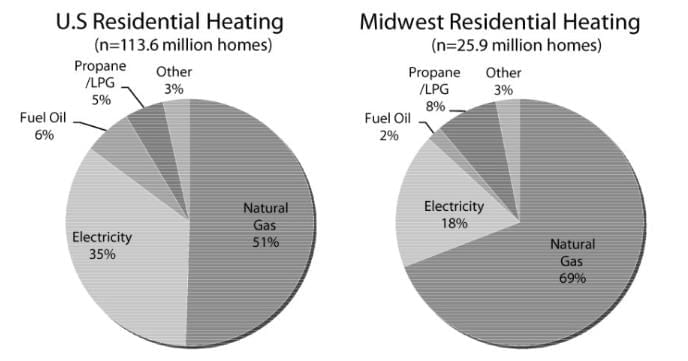
The diagram displays the proportions of households using various residential heating sources in the entire United States and in only the Midwest region (within the US) as recorded by the EIA Residential Energy Consumption Survey (RECS). Included in the survey are 113.6 million US households, of which 25.9 million are located in the 12 Midwestern states (IL, IN, IA, KS, MI, MN, MO, NE, ND, OH, SD, and WI).Fill each blank using the drop-down menu to create the most accurate statement on the basis of the information provided.
1. The number of households in the Midwest that do not use electricity for heating is approximately ______ of the number of households in the US that use electricity for heating.
2. In the Midwest region, the average number of households using either propane/LPG or natural gas for heating is approximately _____ million per state.- a)Dropdown 1: 1/2
Dropdown 2: 1.7 - b)Dropdown 1: 1/3
Dropdown 2: 1.8 - c)Dropdown 1: 1/4
Dropdown 2: 1.9 - d)Dropdown 1: 1/5
Dropdown 2: 1.6
Correct answer is option 'A'. Can you explain this answer?

The diagram displays the proportions of households using various residential heating sources in the entire United States and in only the Midwest region (within the US) as recorded by the EIA Residential Energy Consumption Survey (RECS). Included in the survey are 113.6 million US households, of which 25.9 million are located in the 12 Midwestern states (IL, IN, IA, KS, MI, MN, MO, NE, ND, OH, SD, and WI).
Fill each blank using the drop-down menu to create the most accurate statement on the basis of the information provided.
1. The number of households in the Midwest that do not use electricity for heating is approximately ______ of the number of households in the US that use electricity for heating.
2. In the Midwest region, the average number of households using either propane/LPG or natural gas for heating is approximately _____ million per state.
1. The number of households in the Midwest that do not use electricity for heating is approximately ______ of the number of households in the US that use electricity for heating.
2. In the Midwest region, the average number of households using either propane/LPG or natural gas for heating is approximately _____ million per state.
a)
Dropdown 1: 1/2
Dropdown 2: 1.7
Dropdown 2: 1.7
b)
Dropdown 1: 1/3
Dropdown 2: 1.8
Dropdown 2: 1.8
c)
Dropdown 1: 1/4
Dropdown 2: 1.9
Dropdown 2: 1.9
d)
Dropdown 1: 1/5
Dropdown 2: 1.6
Dropdown 2: 1.6

|
EduRev GMAT answered |
(1) The number of households in the Midwest that do not use electricity for heating = (100-18)% of 25.9 million i.e. 21.238 million.
The number of households in the US that use electricity for heating = 35% of 113.6 million i.e. 39.76 million
Thus,
21.238 million/ 39.76 million = 0.534
That's closer to 1/2
(2) The number of households in the Midwest that use either propane/LPG or natural gas for heating : (69 + 8)% of 25.9 million i.e. 19.943 million.
Thus, the average number of households using either propane/LPG or natural gas for heating per state = 19.943/(total number of states = 12) = 1.66 million
That's closer to 1.7 million.
The number of households in the US that use electricity for heating = 35% of 113.6 million i.e. 39.76 million
Thus,
21.238 million/ 39.76 million = 0.534
That's closer to 1/2
(2) The number of households in the Midwest that use either propane/LPG or natural gas for heating : (69 + 8)% of 25.9 million i.e. 19.943 million.
Thus, the average number of households using either propane/LPG or natural gas for heating per state = 19.943/(total number of states = 12) = 1.66 million
That's closer to 1.7 million.
Joyce has a recipe for a batch of brownies and a recipe for a coffee cake. How many cups of flour does her recipe for a batch of brownies require?
(1) When Joyce bakes a batch of brownies and a coffee cake following her recipes, she uses a total of 9/2 cups of flour.
(2) When Joyce bakes 2 batches of brownies and 3 coffee cakes following her recipes, she uses a total of 11 cups of flour.- a)Statement (1) ALONE is sufficient, but statement (2) alone is not sufficient to answer the question asked.
- b)Statement (2) ALONE is sufficient, but statement (1) alone is not sufficient to answer the question asked.
- c)BOTH statements (1) and (2) TOGETHER are sufficient to answer the question asked, but NEITHER statement ALONE is sufficient to answer the question ask
- d)EACH statement ALONE is sufficient to answer the question asked.
- e)Statements (1) and (2) TOGETHER are NOT sufficient to answer the question asked, and additional data specific to the problem are needed.
Correct answer is option 'C'. Can you explain this answer?
Joyce has a recipe for a batch of brownies and a recipe for a coffee cake. How many cups of flour does her recipe for a batch of brownies require?
(1) When Joyce bakes a batch of brownies and a coffee cake following her recipes, she uses a total of 9/2 cups of flour.
(2) When Joyce bakes 2 batches of brownies and 3 coffee cakes following her recipes, she uses a total of 11 cups of flour.
(1) When Joyce bakes a batch of brownies and a coffee cake following her recipes, she uses a total of 9/2 cups of flour.
(2) When Joyce bakes 2 batches of brownies and 3 coffee cakes following her recipes, she uses a total of 11 cups of flour.
a)
Statement (1) ALONE is sufficient, but statement (2) alone is not sufficient to answer the question asked.
b)
Statement (2) ALONE is sufficient, but statement (1) alone is not sufficient to answer the question asked.
c)
BOTH statements (1) and (2) TOGETHER are sufficient to answer the question asked, but NEITHER statement ALONE is sufficient to answer the question ask
d)
EACH statement ALONE is sufficient to answer the question asked.
e)
Statements (1) and (2) TOGETHER are NOT sufficient to answer the question asked, and additional data specific to the problem are needed.

|
EduRev GMAT answered |
Option C
suppose, she needs x cups of flour for 1 batch of brownies and y cups of flour for 1 coffee cake
it is given that x+y = 9/2 = 4.5 [From statement 1] ..... (eq. 1)
and 2x+3y = 11 [From statement 2] .......... ( eq. 2)
we need value of x, we can't get a specific value from a single equation. We need 2 equations for solving a 2D equation
Both statements together are sufficient.
Hence, option C
suppose, she needs x cups of flour for 1 batch of brownies and y cups of flour for 1 coffee cake
it is given that x+y = 9/2 = 4.5 [From statement 1] ..... (eq. 1)
and 2x+3y = 11 [From statement 2] .......... ( eq. 2)
we need value of x, we can't get a specific value from a single equation. We need 2 equations for solving a 2D equation
Both statements together are sufficient.
Hence, option C
The table lists all the employees of the Metro Corporation’s human resources department. Each employee's immediate supervisor is identified by the supervisor’s employee ID number displayed in the last column on the right of the table. If one employee, say A, supervises another, say B, then A also supervises every employee supervised by B. Note that the hire date is given in the format month/day/year.
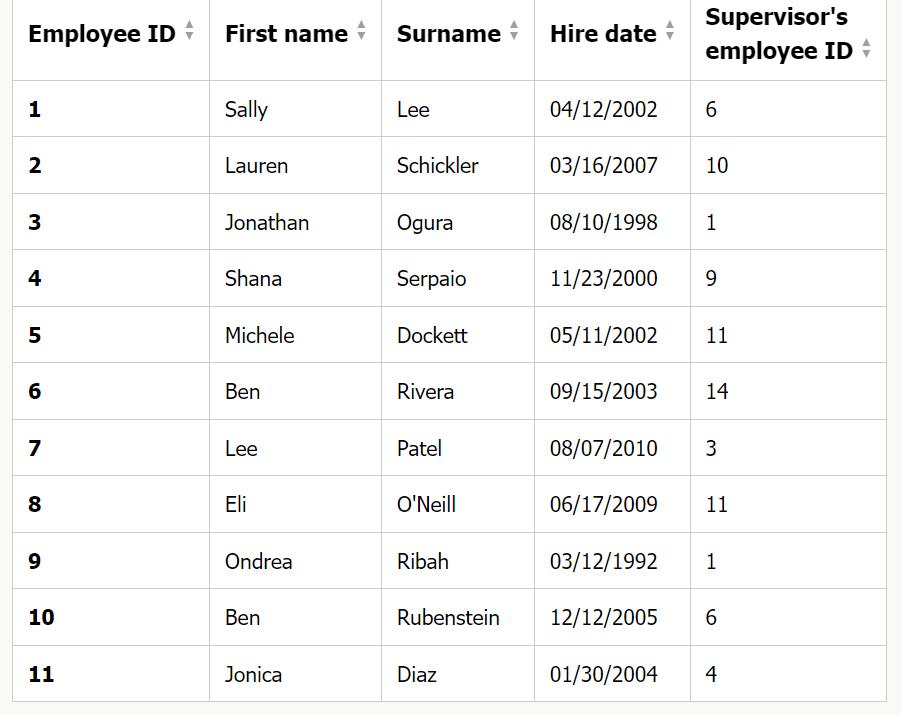 For each of the following, select Yes if it identifies an employee who, within the human resources department, supervises no one and who has at least 5 supervisors within the human resources department above her or him. Otherwise, select No.
For each of the following, select Yes if it identifies an employee who, within the human resources department, supervises no one and who has at least 5 supervisors within the human resources department above her or him. Otherwise, select No.
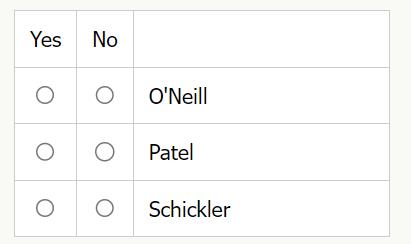
- a)No, No, No
- b)Yes, No, Yes
- c)Yes, No, No
- d)Yes, Yes, Yes
- e)No, Yes, No
Correct answer is option 'C'. Can you explain this answer?
The table lists all the employees of the Metro Corporation’s human resources department. Each employee's immediate supervisor is identified by the supervisor’s employee ID number displayed in the last column on the right of the table. If one employee, say A, supervises another, say B, then A also supervises every employee supervised by B. Note that the hire date is given in the format month/day/year.

For each of the following, select Yes if it identifies an employee who, within the human resources department, supervises no one and who has at least 5 supervisors within the human resources department above her or him. Otherwise, select No.

a)
No, No, No
b)
Yes, No, Yes
c)
Yes, No, No
d)
Yes, Yes, Yes
e)
No, Yes, No

|
EduRev GMAT answered |
O'Neil : 8 <-- 11 <-- 4 <-- 9 <-- 1 <-- 6 <-- 14. Total 6 supervisors and he is supervisor of none so YES.
Patel : 7 <-- 3 <-- 1 <-- 6 <-- 14. Total 4 Supervisors, so NO.
Schickler 2 <-- 10 <-- 6 <-- 14. Total 3 Supervisors, so NO.
Patel : 7 <-- 3 <-- 1 <-- 6 <-- 14. Total 4 Supervisors, so NO.
Schickler 2 <-- 10 <-- 6 <-- 14. Total 3 Supervisors, so NO.
Registrants for a conference were asked to choose a room for single or double occupancy and to reserve seating for lunches only or for lunches and dinners. A total of 1,250 people registered for the conference, and 250 of those requested single-occupancy rooms. Two hundred people reserved lunch-only seating, and 50 declined all meal service. Find the number of dinners that will be needed and the total number of rooms reserved.
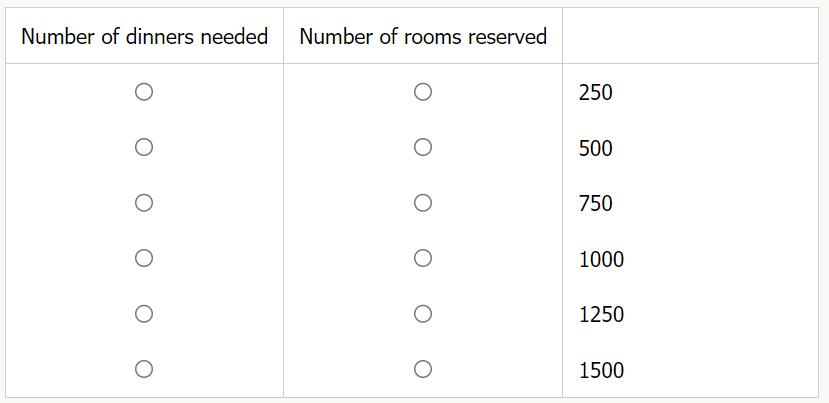
- a)Number of dinners needed 1000, Numbers of rooms reserved 750
- b)Number of dinners needed 1500, Numbers of rooms reserved 250
- c)Number of dinners needed 500, Numbers of rooms reserved 750
- d)Number of dinners needed 1250, Numbers of rooms reserved 750
- e)Number of dinners needed 750, Numbers of rooms reserved 1250
Correct answer is option 'A'. Can you explain this answer?
Registrants for a conference were asked to choose a room for single or double occupancy and to reserve seating for lunches only or for lunches and dinners. A total of 1,250 people registered for the conference, and 250 of those requested single-occupancy rooms. Two hundred people reserved lunch-only seating, and 50 declined all meal service. Find the number of dinners that will be needed and the total number of rooms reserved.

a)
Number of dinners needed 1000, Numbers of rooms reserved 750
b)
Number of dinners needed 1500, Numbers of rooms reserved 250
c)
Number of dinners needed 500, Numbers of rooms reserved 750
d)
Number of dinners needed 1250, Numbers of rooms reserved 750
e)
Number of dinners needed 750, Numbers of rooms reserved 1250

|
EduRev GMAT answered |
The conference organizers need 250 single rooms, and the remaining 1,000 people can be housed in 500 double rooms, so a total of 750 rooms will be needed. For meals, 50 of the 1,250 attendees declined all meals, and 200 more chose only lunches, so 1,250 – 50 – 200 = 1,000 people reserved dinner seating.
Email #1
Email from wedding coordinator to bride and groom
February 12, at 10:13am
"The final headcount for booking the pavilion for the reception is today. Right now we have a rough estimate of 425 people. Is this still true and if so, do we know how many people will be having the chicken dinner?"
Email #2
Email from the bride to the wedding coordinator
February 12, at 10:27am
"We are still waiting on 40 invitations to RSVP; we gave a deadline of February 15. Is there a possibility for an extension to the 15th? Of the current 425 guests 375 have opted for the chicken dinner."
Email #3
Email from the wedding coordinator to the bride
February 12, at 11:02am
"I will reach out to the pavilion to see if an extension is possible and get back to you this afternoon. We can always assume for more since the pavilion does offer a refund if any changes are made at least one week prior to the wedding."
Based on the given information in the emails, determine whether the statements are justified.
I. The wedding coordinator is not willing to extend the guest headcount deadline.
II. The bride does not have a specific, expected date to receive RSVPs.
III. The wedding coordinator gives additional options to the bride in case the pavilion will not give an extension.
- a)Justified, Not justified, Justified
- b)Not justified, Not justified, Justified
- c)Not justified, Not justified, Not justified
- d)Justified, Justified, Not justified
- e)Justified, Justified, Justified
Correct answer is option 'B'. Can you explain this answer?
Email #1
Email from wedding coordinator to bride and groom
February 12, at 10:13am
"The final headcount for booking the pavilion for the reception is today. Right now we have a rough estimate of 425 people. Is this still true and if so, do we know how many people will be having the chicken dinner?"
Email #2
Email from the bride to the wedding coordinator
February 12, at 10:27am
"We are still waiting on 40 invitations to RSVP; we gave a deadline of February 15. Is there a possibility for an extension to the 15th? Of the current 425 guests 375 have opted for the chicken dinner."
Email #3
Email from the wedding coordinator to the bride
February 12, at 11:02am
"I will reach out to the pavilion to see if an extension is possible and get back to you this afternoon. We can always assume for more since the pavilion does offer a refund if any changes are made at least one week prior to the wedding."
Based on the given information in the emails, determine whether the statements are justified.
I. The wedding coordinator is not willing to extend the guest headcount deadline.
II. The bride does not have a specific, expected date to receive RSVPs.
III. The wedding coordinator gives additional options to the bride in case the pavilion will not give an extension.
Email from wedding coordinator to bride and groom
February 12, at 10:13am
"The final headcount for booking the pavilion for the reception is today. Right now we have a rough estimate of 425 people. Is this still true and if so, do we know how many people will be having the chicken dinner?"
Email #2
Email from the bride to the wedding coordinator
February 12, at 10:27am
"We are still waiting on 40 invitations to RSVP; we gave a deadline of February 15. Is there a possibility for an extension to the 15th? Of the current 425 guests 375 have opted for the chicken dinner."
Email #3
Email from the wedding coordinator to the bride
February 12, at 11:02am
"I will reach out to the pavilion to see if an extension is possible and get back to you this afternoon. We can always assume for more since the pavilion does offer a refund if any changes are made at least one week prior to the wedding."
Based on the given information in the emails, determine whether the statements are justified.
I. The wedding coordinator is not willing to extend the guest headcount deadline.
II. The bride does not have a specific, expected date to receive RSVPs.
III. The wedding coordinator gives additional options to the bride in case the pavilion will not give an extension.
a)
Justified, Not justified, Justified
b)
Not justified, Not justified, Justified
c)
Not justified, Not justified, Not justified
d)
Justified, Justified, Not justified
e)
Justified, Justified, Justified

|
EduRev GMAT answered |
To determine which statements are justified, look at the information given in the emails.
For statement I. The wedding coordinator is not willing to extend the guest headcount deadline. Look at the bold statement in email #3,
Email from the wedding coordinator to the bride
February 12, at 11:02am
I will reach out to the pavilion to see if an extension is possible and get back to you this afternoon. We can always assume for more since the pavilion does offer a refund if any chances are made at least one week prior to the wedding.
Therefore, the wedding coordinator is willing to extend the guest count if at all possible. Thus, this statement is not justified.
For statement II. The bride does not have a specific, expected date to receive RSVPs. Look at the bold statement in email #2,
Email from the bride to the wedding coordinator
February 12, at 10:27am
We are still waiting on 40 invitations to RSVP; we gave a deadline of February 15. Is there a possibility for an extension to the 15th? Of the current 425 guests 375 have opted for the chicken dinner.
Therefore, the bride does give a deadline for the RSVPs. Thus, this statement is not justified.
For statement III. The wedding coordinator gives additional options to the bride in case the pavilion will not give an extension. Look at the bold statement in email #3,
Email from the wedding coordinator to the bride
February 12, at 11:02am
I will reach out to the pavilion to see if an extension is possible and get back to you this afternoon. We can always assume for more since the pavilion does offer a refund if any changes are made at least one week prior to the wedding.
Since the wedding coordinator gives additional options to the bride, the statement is justified.
For statement I. The wedding coordinator is not willing to extend the guest headcount deadline. Look at the bold statement in email #3,
Email from the wedding coordinator to the bride
February 12, at 11:02am
I will reach out to the pavilion to see if an extension is possible and get back to you this afternoon. We can always assume for more since the pavilion does offer a refund if any chances are made at least one week prior to the wedding.
Therefore, the wedding coordinator is willing to extend the guest count if at all possible. Thus, this statement is not justified.
For statement II. The bride does not have a specific, expected date to receive RSVPs. Look at the bold statement in email #2,
Email from the bride to the wedding coordinator
February 12, at 10:27am
We are still waiting on 40 invitations to RSVP; we gave a deadline of February 15. Is there a possibility for an extension to the 15th? Of the current 425 guests 375 have opted for the chicken dinner.
Therefore, the bride does give a deadline for the RSVPs. Thus, this statement is not justified.
For statement III. The wedding coordinator gives additional options to the bride in case the pavilion will not give an extension. Look at the bold statement in email #3,
Email from the wedding coordinator to the bride
February 12, at 11:02am
I will reach out to the pavilion to see if an extension is possible and get back to you this afternoon. We can always assume for more since the pavilion does offer a refund if any changes are made at least one week prior to the wedding.
Since the wedding coordinator gives additional options to the bride, the statement is justified.
Email #1
Email from project manager to financial officer
August 3, 9:43 a.m.
Did all three bids arrive on time last night? We need to minimize delays on construction, so if the contractors have submitted their estimates and our research team has compiled reports on the contractors’ histories, we should make a decision on which firm to hire by the end of the day.Email #2
Email from financial officer in response to the project manager’s August 3, 9:43 a.m. email
August 3, 10:12 a.m.
Appaloosa Construction sent us a bid of $1.35 million. Its bid is the highest of the three, but its track record is spotless; none of the past 10 major projects it has worked on has gone over budget by more than 4 percent. Breton Construction did manage to underbid them—its representative claims that it can do the project for $1.25 million. However, in the past two years, Breton oversaw two different projects that went over budget by a full 25 percent. If our project were to exceed Breton’s estimate by a comparable percentage, we would run out of funds before completion. Finally, Campolina Construction presented a $1.1 million plan, and its track record is as good as Appaloosa’s. Unfortunately, although Appaloosa and Breton can both start tomorrow, Campolina would be unable to begin work until August 25, so we cannot accept Campolina’s low bid.Email #3
Email from project manager in response to the financial officer’s August 3, 10:12 a.m. email
August 3, 10:38 a.m.
Even though Breton’s work could potentially cost less than either of the other two, that savings does not justify the risk of being unable to complete the project. But as far as Campolina is concerned, you’re not considering the actual cost of a delay. It’s true that we are losing money at a constant rate each day we don’t start building. But even after factoring in the losses of waiting until August 25, the estimated cost of working with Campolina still ends up $50,000 below Appaloosa’s bid.The amount of money lost each day that construction is delayed is closest to
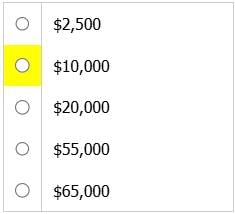
- a)$2,500
- b)$10,000
- c)$20,000
- d)$55,000
- e)$65,000
Correct answer is option 'B'. Can you explain this answer?
Email #1
Email from project manager to financial officer
August 3, 9:43 a.m.
Did all three bids arrive on time last night? We need to minimize delays on construction, so if the contractors have submitted their estimates and our research team has compiled reports on the contractors’ histories, we should make a decision on which firm to hire by the end of the day.
Email from project manager to financial officer
August 3, 9:43 a.m.
Did all three bids arrive on time last night? We need to minimize delays on construction, so if the contractors have submitted their estimates and our research team has compiled reports on the contractors’ histories, we should make a decision on which firm to hire by the end of the day.
Email #2
Email from financial officer in response to the project manager’s August 3, 9:43 a.m. email
August 3, 10:12 a.m.
Appaloosa Construction sent us a bid of $1.35 million. Its bid is the highest of the three, but its track record is spotless; none of the past 10 major projects it has worked on has gone over budget by more than 4 percent. Breton Construction did manage to underbid them—its representative claims that it can do the project for $1.25 million. However, in the past two years, Breton oversaw two different projects that went over budget by a full 25 percent. If our project were to exceed Breton’s estimate by a comparable percentage, we would run out of funds before completion. Finally, Campolina Construction presented a $1.1 million plan, and its track record is as good as Appaloosa’s. Unfortunately, although Appaloosa and Breton can both start tomorrow, Campolina would be unable to begin work until August 25, so we cannot accept Campolina’s low bid.
Email from financial officer in response to the project manager’s August 3, 9:43 a.m. email
August 3, 10:12 a.m.
Appaloosa Construction sent us a bid of $1.35 million. Its bid is the highest of the three, but its track record is spotless; none of the past 10 major projects it has worked on has gone over budget by more than 4 percent. Breton Construction did manage to underbid them—its representative claims that it can do the project for $1.25 million. However, in the past two years, Breton oversaw two different projects that went over budget by a full 25 percent. If our project were to exceed Breton’s estimate by a comparable percentage, we would run out of funds before completion. Finally, Campolina Construction presented a $1.1 million plan, and its track record is as good as Appaloosa’s. Unfortunately, although Appaloosa and Breton can both start tomorrow, Campolina would be unable to begin work until August 25, so we cannot accept Campolina’s low bid.
Email #3
Email from project manager in response to the financial officer’s August 3, 10:12 a.m. email
August 3, 10:38 a.m.
Even though Breton’s work could potentially cost less than either of the other two, that savings does not justify the risk of being unable to complete the project. But as far as Campolina is concerned, you’re not considering the actual cost of a delay. It’s true that we are losing money at a constant rate each day we don’t start building. But even after factoring in the losses of waiting until August 25, the estimated cost of working with Campolina still ends up $50,000 below Appaloosa’s bid.
Email from project manager in response to the financial officer’s August 3, 10:12 a.m. email
August 3, 10:38 a.m.
Even though Breton’s work could potentially cost less than either of the other two, that savings does not justify the risk of being unable to complete the project. But as far as Campolina is concerned, you’re not considering the actual cost of a delay. It’s true that we are losing money at a constant rate each day we don’t start building. But even after factoring in the losses of waiting until August 25, the estimated cost of working with Campolina still ends up $50,000 below Appaloosa’s bid.
The amount of money lost each day that construction is delayed is closest to


a)
$2,500
b)
$10,000
c)
$20,000
d)
$55,000
e)
$65,000

|
EduRev GMAT answered |
Campolina Construction presented a $1.1 million plan, which is 0.25 less than Appaloosa's bid.
But, due to delay of almost 22 days, the cost of C's cost becomes onle 0.05 less. Thus 22 days delay cost around 0.20 million
or 200,000/22 or 10,000 nearly
A text written in an unknown language was recently discovered and then digitized and analyzed. The analysts divided the text into 7 sections- Sections A through G—and computed word frequencies by section for each word in the text. The table shows these frequencies for Words 1 through 6. For instance, the table shows that Word 1 appeared 1 time in Section A, and 10 times in Section C.
The analysts consider two words to be correlational if their frequencies in the 7 sections of the text were positively correlated.
For each of the following pairs of words, select Yes if the information provided suggests that the analysts would consider the two words correlational. Otherwise, select No.
Frequency of Certain Words, by Section
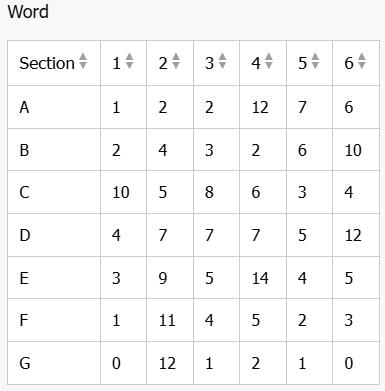
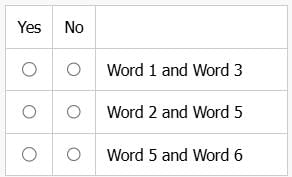
- a)Word 1 and Word 3: No
Word 2 and Word 5: No
Word 5 and Word 6: Yes - b)Word 1 and Word 3: Yes
Word 2 and Word 5: No
Word 5 and Word 6: Yes - c)Word 1 and Word 3: No
Word 2 and Word 5: No
Word 5 and Word 6: No - d)Word 1 and Word 3: Yes
Word 2 and Word 5: Yes
Word 5 and Word 6: Yes - e)Word 1 and Word 3: No
Word 2 and Word 5: Yes
Word 5 and Word 6: Yes
Correct answer is option 'B'. Can you explain this answer?
A text written in an unknown language was recently discovered and then digitized and analyzed. The analysts divided the text into 7 sections- Sections A through G—and computed word frequencies by section for each word in the text. The table shows these frequencies for Words 1 through 6. For instance, the table shows that Word 1 appeared 1 time in Section A, and 10 times in Section C.
The analysts consider two words to be correlational if their frequencies in the 7 sections of the text were positively correlated.
For each of the following pairs of words, select Yes if the information provided suggests that the analysts would consider the two words correlational. Otherwise, select No.
Frequency of Certain Words, by Section


The analysts consider two words to be correlational if their frequencies in the 7 sections of the text were positively correlated.
For each of the following pairs of words, select Yes if the information provided suggests that the analysts would consider the two words correlational. Otherwise, select No.
Frequency of Certain Words, by Section


a)
Word 1 and Word 3: No
Word 2 and Word 5: No
Word 5 and Word 6: Yes
Word 2 and Word 5: No
Word 5 and Word 6: Yes
b)
Word 1 and Word 3: Yes
Word 2 and Word 5: No
Word 5 and Word 6: Yes
Word 2 and Word 5: No
Word 5 and Word 6: Yes
c)
Word 1 and Word 3: No
Word 2 and Word 5: No
Word 5 and Word 6: No
Word 2 and Word 5: No
Word 5 and Word 6: No
d)
Word 1 and Word 3: Yes
Word 2 and Word 5: Yes
Word 5 and Word 6: Yes
Word 2 and Word 5: Yes
Word 5 and Word 6: Yes
e)
Word 1 and Word 3: No
Word 2 and Word 5: Yes
Word 5 and Word 6: Yes
Word 2 and Word 5: Yes
Word 5 and Word 6: Yes

|
EduRev GMAT answered |
To determine the correct answer, let's analyze the frequencies of the words in the different sections for each of the pairs mentioned in the options. We will check if the frequencies of the words show a positive correlation, meaning as one increases, the other also increases in the same sections.
Pair 1: Word 1 and Word 3
Let's look at the frequencies for Word 1 and Word 3 across all sections:
As we can see, as the frequency of
Word 1
increases (from Section A to Section C), the frequency of
Word 3
also increases in a similar pattern, indicating a positive correlation. Therefore,
Word 1 and Word 3
are
positively correlated
.
Conclusion
:
Yes
(positive correlation)
Pair 2: Word 2 and Word 5
Let’s examine the frequencies for Word 2 and Word 5 across all sections:
As we observe, the frequencies for
Word 2
and
Word 5
do not follow a clear upward or downward trend together. For example, in Section A, Word 2 has a frequency of 2 and Word 5 has a frequency of 7, but in Section G, Word 2 has a frequency of 12 and Word 5 has a frequency of 1. This shows no consistent positive correlation.
Conclusion
:
No
(no positive correlation)
Pair 3: Word 5 and Word 6
Now, let’s look at the frequencies for Word 5 and Word 6 across all sections:
Here, we can see that as the frequency of Word 5 decreases (from Section A to Section G), the frequency of Word 6 also generally decreases in a similar pattern. This indicates a positive correlation between the two words.
Conclusion: Yes (positive correlation)
Final Answer
- Word 1 and Word 3: Yes (positive correlation)
- Word 2 and Word 5: No (no positive correlation)
- Word 5 and Word 6: Yes (positive correlation)
Thus, the correct option is Option B:
According to a survey, at least 70% of students in a college study Hindi, at least 75% of students study French, and at least 80% of students study German. If x is the minimum percentage of students who study all three languages and y is the maximum percentage of students who study all three languages, then choose the appropriate values for x and y from the table given below:
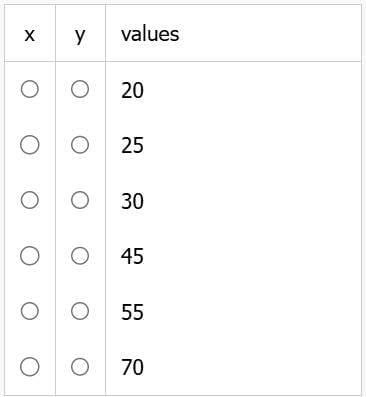
- a)x=25, y=70
- b)x=20, y=30
- c)x=45, y=55
- d)x=55, y=70
Correct answer is option 'A'. Can you explain this answer?
According to a survey, at least 70% of students in a college study Hindi, at least 75% of students study French, and at least 80% of students study German. If x is the minimum percentage of students who study all three languages and y is the maximum percentage of students who study all three languages, then choose the appropriate values for x and y from the table given below:


a)
x=25, y=70
b)
x=20, y=30
c)
x=45, y=55
d)
x=55, y=70

|
EduRev GMAT answered |
For y i.e. maximum, we have at least 70, 75 and 80. Here, the minimum of subsets is 70 so y=70%.
For x, we can get minimum if we assume students studying both subjects as the maximum.
Let, total students=100a. H=70a, F=75a, G=80a.
100a=70a+75a+80a - 100a (assuming maximum) - x
200a-225a=-x or, x=25a i.e. 25%.
x=25, y=70.
For x, we can get minimum if we assume students studying both subjects as the maximum.
Let, total students=100a. H=70a, F=75a, G=80a.
100a=70a+75a+80a - 100a (assuming maximum) - x
200a-225a=-x or, x=25a i.e. 25%.
x=25, y=70.
STOCKS CLASSIFICATIONHoly Faith Broking Company classifies stocks of listed companies on the basis of two parameters.
Stock Valuation Classification
TOP – ‘TOP’ is termed as the mean of daily values of “highest percentage increase in the stock price over last day’s closing price” over a period.
BOTTOM - ‘BOTTOM’ is termed as the mean of daily values of “lowest percentage increase or highest percent decrease, as the case may be, in the stock price over last day’s closing price” over a period.
Stable Cow - A stock whose TOP is less than 15% and BOTTOM is more than 8%.
Volatile Bull - A stock whose TOP is more than 30% and BOTTOM is less than 10%.
Volatile Bear - A stock whose TOP is less than 10% and BOTTOM is less than -10%.
Profit Generation Capability
Struggler - A stock whose issuing company makes a profit between 1% to 5% of its revenue. (Both inclusive)
Dessert - A stock whose issuing company makes a loss of more than 1% of its revenue.
Rain Maker - A stock whose issuing company makes a profit of more than 10% of its revenue.CHARTS
The two graphs given below are for stocks of companies A, B, C, and D. The first graph shows mean of daily values of “percentage increase or decrease in the stock price over last day’s closing price” over a period. The second graph represents revenue to expense ratio (data label on the bubble) & revenue for these four companies. Centers of bubbles represent revenue of the company (on Y axis).
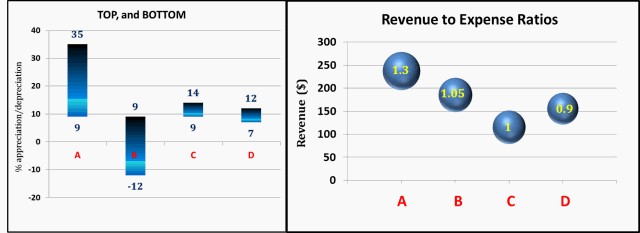 For each of the following statements, select yes if, based on the given information, it must be true, otherwise select no.
For each of the following statements, select yes if, based on the given information, it must be true, otherwise select no.
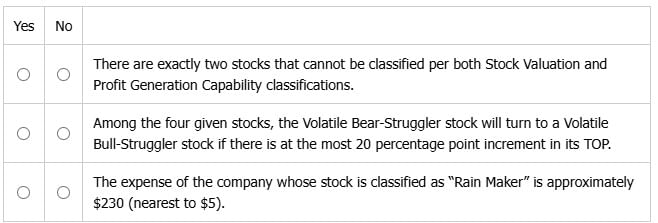
- a)No: There are exactly two stocks that cannot be classified per both Stock Valuation and Profit Generation Capability classifications.
No: Among the four given stocks, the Volatile Bear-Struggler stock will turn to a Volatile Bull-Struggler stock if there is at the most 20 percentage point increment in its TOP.
No: The expense of the company whose stock is classified as “Rain Maker” is approximately $230 (nearest to $5). - b)Yes: There are exactly two stocks that cannot be classified per both Stock Valuation and Profit Generation Capability classifications.
No: Among the four given stocks, the Volatile Bear-Struggler stock will turn to a Volatile Bull-Struggler stock if there is at the most 20 percentage point increment in its TOP.
No: The expense of the company whose stock is classified as “Rain Maker” is approximately $230 (nearest to $5). - c)Yes: There are exactly two stocks that cannot be classified per both Stock Valuation and Profit Generation Capability classifications.
Yes: Among the four given stocks, the Volatile Bear-Struggler stock will turn to a Volatile Bull-Struggler stock if there is at the most 20 percentage point increment in its TOP.
No: The expense of the company whose stock is classified as “Rain Maker” is approximately $230 (nearest to $5). - d)Yes: There are exactly two stocks that cannot be classified per both Stock Valuation and Profit Generation Capability classifications.
Yes: Among the four given stocks, the Volatile Bear-Struggler stock will turn to a Volatile Bull-Struggler stock if there is at the most 20 percentage point increment in its TOP.
Yes: The expense of the company whose stock is classified as “Rain Maker” is approximately $230 (nearest to $5).
Correct answer is option 'A'. Can you explain this answer?
STOCKS CLASSIFICATION
Holy Faith Broking Company classifies stocks of listed companies on the basis of two parameters.
Stock Valuation Classification
TOP – ‘TOP’ is termed as the mean of daily values of “highest percentage increase in the stock price over last day’s closing price” over a period.
BOTTOM - ‘BOTTOM’ is termed as the mean of daily values of “lowest percentage increase or highest percent decrease, as the case may be, in the stock price over last day’s closing price” over a period.
Stable Cow - A stock whose TOP is less than 15% and BOTTOM is more than 8%.
Volatile Bull - A stock whose TOP is more than 30% and BOTTOM is less than 10%.
Volatile Bear - A stock whose TOP is less than 10% and BOTTOM is less than -10%.
Profit Generation Capability
Struggler - A stock whose issuing company makes a profit between 1% to 5% of its revenue. (Both inclusive)
Dessert - A stock whose issuing company makes a loss of more than 1% of its revenue.
Rain Maker - A stock whose issuing company makes a profit of more than 10% of its revenue.
Stock Valuation Classification
TOP – ‘TOP’ is termed as the mean of daily values of “highest percentage increase in the stock price over last day’s closing price” over a period.
BOTTOM - ‘BOTTOM’ is termed as the mean of daily values of “lowest percentage increase or highest percent decrease, as the case may be, in the stock price over last day’s closing price” over a period.
Stable Cow - A stock whose TOP is less than 15% and BOTTOM is more than 8%.
Volatile Bull - A stock whose TOP is more than 30% and BOTTOM is less than 10%.
Volatile Bear - A stock whose TOP is less than 10% and BOTTOM is less than -10%.
Profit Generation Capability
Struggler - A stock whose issuing company makes a profit between 1% to 5% of its revenue. (Both inclusive)
Dessert - A stock whose issuing company makes a loss of more than 1% of its revenue.
Rain Maker - A stock whose issuing company makes a profit of more than 10% of its revenue.
CHARTS
The two graphs given below are for stocks of companies A, B, C, and D. The first graph shows mean of daily values of “percentage increase or decrease in the stock price over last day’s closing price” over a period. The second graph represents revenue to expense ratio (data label on the bubble) & revenue for these four companies. Centers of bubbles represent revenue of the company (on Y axis).

The two graphs given below are for stocks of companies A, B, C, and D. The first graph shows mean of daily values of “percentage increase or decrease in the stock price over last day’s closing price” over a period. The second graph represents revenue to expense ratio (data label on the bubble) & revenue for these four companies. Centers of bubbles represent revenue of the company (on Y axis).

For each of the following statements, select yes if, based on the given information, it must be true, otherwise select no.


a)
No: There are exactly two stocks that cannot be classified per both Stock Valuation and Profit Generation Capability classifications.
No: Among the four given stocks, the Volatile Bear-Struggler stock will turn to a Volatile Bull-Struggler stock if there is at the most 20 percentage point increment in its TOP.
No: The expense of the company whose stock is classified as “Rain Maker” is approximately $230 (nearest to $5).
No: Among the four given stocks, the Volatile Bear-Struggler stock will turn to a Volatile Bull-Struggler stock if there is at the most 20 percentage point increment in its TOP.
No: The expense of the company whose stock is classified as “Rain Maker” is approximately $230 (nearest to $5).
b)
Yes: There are exactly two stocks that cannot be classified per both Stock Valuation and Profit Generation Capability classifications.
No: Among the four given stocks, the Volatile Bear-Struggler stock will turn to a Volatile Bull-Struggler stock if there is at the most 20 percentage point increment in its TOP.
No: The expense of the company whose stock is classified as “Rain Maker” is approximately $230 (nearest to $5).
No: Among the four given stocks, the Volatile Bear-Struggler stock will turn to a Volatile Bull-Struggler stock if there is at the most 20 percentage point increment in its TOP.
No: The expense of the company whose stock is classified as “Rain Maker” is approximately $230 (nearest to $5).
c)
Yes: There are exactly two stocks that cannot be classified per both Stock Valuation and Profit Generation Capability classifications.
Yes: Among the four given stocks, the Volatile Bear-Struggler stock will turn to a Volatile Bull-Struggler stock if there is at the most 20 percentage point increment in its TOP.
No: The expense of the company whose stock is classified as “Rain Maker” is approximately $230 (nearest to $5).
Yes: Among the four given stocks, the Volatile Bear-Struggler stock will turn to a Volatile Bull-Struggler stock if there is at the most 20 percentage point increment in its TOP.
No: The expense of the company whose stock is classified as “Rain Maker” is approximately $230 (nearest to $5).
d)
Yes: There are exactly two stocks that cannot be classified per both Stock Valuation and Profit Generation Capability classifications.
Yes: Among the four given stocks, the Volatile Bear-Struggler stock will turn to a Volatile Bull-Struggler stock if there is at the most 20 percentage point increment in its TOP.
Yes: The expense of the company whose stock is classified as “Rain Maker” is approximately $230 (nearest to $5).
Yes: Among the four given stocks, the Volatile Bear-Struggler stock will turn to a Volatile Bull-Struggler stock if there is at the most 20 percentage point increment in its TOP.
Yes: The expense of the company whose stock is classified as “Rain Maker” is approximately $230 (nearest to $5).

|
EduRev GMAT answered |
This question needs classification of stocks, so we first read the relevant data from the charts and classify the stocks.
For Stock Valuation Classification (SV Classification), we read the data from chart 1. The data is given below. We find that stock D cannot be classified per any category of SV Classification.
From Chart 1

For Profit Generation Capability (PGC) classification, we read the data from chart 2.
The percentage of profit is given as (profit/revenue)*100%.
Let’s take stock A first.
R/E ratio for A is 1.3 or 1.3/1. It means that for a revenue of $1.3, expense is $1, and profit is R-E=1.3-1=0.3. So % profit would be (P/R)*100 = (0.3/1.3)*100% =23.08%.
Similarly, for other companies, profit percentages are calculated given below.
From Chart 2
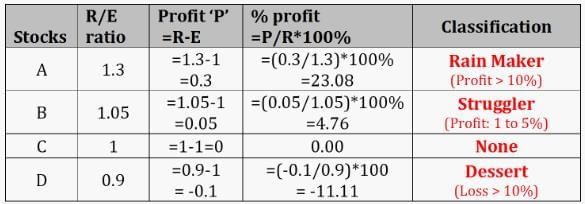
1. a.There is no stock that is not classified for both the categories. In the SV classification, stock D is not classified, whereas in the PGC classification, stock C is not classified. But both these stocks are classified per at least one of the categories, so the answer is NO.
1. b. B stock is Volatile Bear-Struggler. Let’s look at the criterion of Volatile Bull.
Volatile Bull - A stock whose TOP is more than 30% and BOTTOM is less than 10%.
Presently, TOP of stock B is 9% and BOTTOM is -12%. B only qualifies for the BOTTOM criterion of Volatile Bull.
To turn it to Volatile Bull, we need to increase its TOP by more than 30% -9% = 21 percentage points. It is more than 20 percent point increment. So the answer is no. No.
1. c.From the table, we know that A stock is the Rain Maker stock. The revenue of the company of stock A is approximately $230, and R/E ratio is 1.3. This gives expenses as 230/1.3 = $176.92. The value is not approximately $230, hence the answer is No.
For Stock Valuation Classification (SV Classification), we read the data from chart 1. The data is given below. We find that stock D cannot be classified per any category of SV Classification.
From Chart 1

For Profit Generation Capability (PGC) classification, we read the data from chart 2.
The percentage of profit is given as (profit/revenue)*100%.
Let’s take stock A first.
R/E ratio for A is 1.3 or 1.3/1. It means that for a revenue of $1.3, expense is $1, and profit is R-E=1.3-1=0.3. So % profit would be (P/R)*100 = (0.3/1.3)*100% =23.08%.
Similarly, for other companies, profit percentages are calculated given below.
From Chart 2

1. a.There is no stock that is not classified for both the categories. In the SV classification, stock D is not classified, whereas in the PGC classification, stock C is not classified. But both these stocks are classified per at least one of the categories, so the answer is NO.
1. b. B stock is Volatile Bear-Struggler. Let’s look at the criterion of Volatile Bull.
Volatile Bull - A stock whose TOP is more than 30% and BOTTOM is less than 10%.
Presently, TOP of stock B is 9% and BOTTOM is -12%. B only qualifies for the BOTTOM criterion of Volatile Bull.
To turn it to Volatile Bull, we need to increase its TOP by more than 30% -9% = 21 percentage points. It is more than 20 percent point increment. So the answer is no. No.
1. c.From the table, we know that A stock is the Rain Maker stock. The revenue of the company of stock A is approximately $230, and R/E ratio is 1.3. This gives expenses as 230/1.3 = $176.92. The value is not approximately $230, hence the answer is No.
The pie chart below illustrates the distribution of passenger revenue across different regions served by a South Asian airline. The airline operates an equidistant number of flights to each region, and the cost per flight remains consistent across all routes. The airline has been experiencing financial losses over the past few years.
 I. Assuming that the airline has the option to suspend up to three routes in order to mitigate the financial losses, it would be preferable to suspend the routes. _________
I. Assuming that the airline has the option to suspend up to three routes in order to mitigate the financial losses, it would be preferable to suspend the routes. _________
II. The ratio of the revenue of the most costly route to the least costly route is _________.- a)Blank 1: EU, Far East, and Regional
Blank 2: 1:14 - b)Blank 1: KSA, UK and Domestic
Blank 2: 28:23 - c)Blank 1: Gulf, UK and Domestic
Blank 2: 23:28 - d)Blank 1: Regional, UK, and KSA
Blank 2: 14:1 - e)Blank 1: Regional, UK, and KSA
Blank 2: 15:1
Correct answer is option 'A'. Can you explain this answer?
The pie chart below illustrates the distribution of passenger revenue across different regions served by a South Asian airline. The airline operates an equidistant number of flights to each region, and the cost per flight remains consistent across all routes. The airline has been experiencing financial losses over the past few years.

I. Assuming that the airline has the option to suspend up to three routes in order to mitigate the financial losses, it would be preferable to suspend the routes. _________
II. The ratio of the revenue of the most costly route to the least costly route is _________.
II. The ratio of the revenue of the most costly route to the least costly route is _________.
a)
Blank 1: EU, Far East, and Regional
Blank 2: 1:14
Blank 2: 1:14
b)
Blank 1: KSA, UK and Domestic
Blank 2: 28:23
Blank 2: 28:23
c)
Blank 1: Gulf, UK and Domestic
Blank 2: 23:28
Blank 2: 23:28
d)
Blank 1: Regional, UK, and KSA
Blank 2: 14:1
Blank 2: 14:1
e)
Blank 1: Regional, UK, and KSA
Blank 2: 15:1
Blank 2: 15:1

|
EduRev GMAT answered |
I. Assuming that the airline has the option to suspend up to three routes in order to mitigate the financial losses, it would be preferable to suspend the routes with the least passenger revenue. Based on the pie chart, the routes contributing the least to passenger revenue are:
- Regional (2%)
- Far East (5%)
- EU (7%)
These three regions contribute the least to the airline’s passenger revenue, so Blank 1 is: EU, Far East, and Regional.
II. The ratio of the revenue of the most costly route (KSA) to the least costly route (Regional) is calculated as:
- Most costly route: KSA with 28% of revenue.
- Least costly route: Regional with 2% of revenue.
The ratio of the revenue of the most costly route to the least costly route is:
28% / 2% = 14:1
Therefore, Blank 2 is: 1:14.
Thus, the correct solution is:
Option A:
- Blank 1: EU, Far East, and Regional
- Blank 2: 1:14
Jaspher invested in two ventures A and B, with rates of interest at 5k% and 3k%, respectively. What was the initial investment Jaspher made in venture B?(1) The amount Jaspher invested in venture B was five times the amount he invested in venture A.(2) The interest from venture B was $150 while the interest from venture A was $50.- a)Statement (1) ALONE is sufficient, but statement (2) alone is not sufficient.
- b)Statement (2) ALONE is sufficient, but statement (1) alone is not sufficient.
- c)BOTH statements TOGETHER are sufficient, but NEITHER statement ALONE is sufficient.
- d)EACH statement ALONE is sufficient.
- e)Statements (1) and (2) TOGETHER are NOT sufficient.
Correct answer is option 'E'. Can you explain this answer?
Jaspher invested in two ventures A and B, with rates of interest at 5k% and 3k%, respectively. What was the initial investment Jaspher made in venture B?
(1) The amount Jaspher invested in venture B was five times the amount he invested in venture A.
(2) The interest from venture B was $150 while the interest from venture A was $50.
a)
Statement (1) ALONE is sufficient, but statement (2) alone is not sufficient.
b)
Statement (2) ALONE is sufficient, but statement (1) alone is not sufficient.
c)
BOTH statements TOGETHER are sufficient, but NEITHER statement ALONE is sufficient.
d)
EACH statement ALONE is sufficient.
e)
Statements (1) and (2) TOGETHER are NOT sufficient.

|
EduRev GMAT answered |
Answer:(E)
Let the initial investment in venture A be denoted as 'a', and the initial investment in venture B be 'b'.
The question is asking for the value of 'b'.
Statement (1):
This statement tells you that the initial investment in venture B is five times the initial investment in venture A.
In mathematical terms, this gives you b = 5a.
However, without knowing the value of 'a', you cannot determine the value of 'b'. Thus, statement (1) alone is not sufficient.
Statement (2):
This statement tells you that 'a' dollars earning interest at a rate of 5k% equals $50, and 'b' dollars earning interest at a rate of 3k% equals $150.
This gives you two equations: 5k/100 * a = $50 and
3k/100 * b = $150.
Manipulating these equations, we get:
a = $50 / (5k/100) and
b = $150 / (3k/100)
Dividing, these we get,
a/b = 1/5
However, we can't figure out the individual values of 'a' and 'b' as the value of 'k' is not given. So, statement (2) alone is also not sufficient.
Taking BOTH statements TOGETHER, we still can't determine the value of 'b' because we do not know the value of 'k'. Both statements together simply confirm that b = 5a, but without the value of 'k', we cannot determine the individual values of 'a' and 'b'. Therefore, BOTH statements TOGETHER are NOT sufficient.
The correct answer is (E).
The following graph shows the results of a survey taken in 14 markets that inquired about subjects’ habit of reading the print version of a daily newspaper. Each point represents the percent of men and the percent of women in a particular market who indicated that they read the daily paper. The solid line is the line of best fit. The equation of this line is shown on the graph.
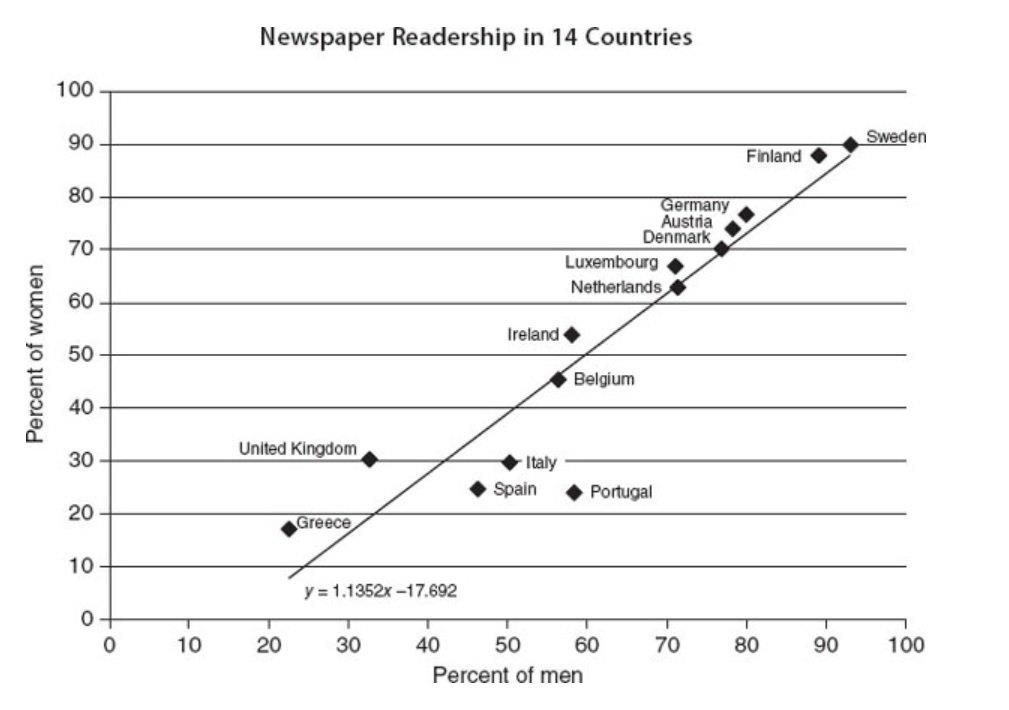
The line of best fit suggests that a 1% increase in the number of men who read the daily paper corresponds to a_________ in the number of women who read the daily paper.
Based upon these data, in a market in which approximately 40% of men read the daily paper, we would expect about_________ of women to read the daily paper.- a)Less than 1% increase , 5%
- b)Less than 1% decrease , 15%
- c)1.1% increase , 25%
- d)1.1% decrease , 35%
- e)1.7% increase , 45%
Correct answer is option 'C'. Can you explain this answer?
The following graph shows the results of a survey taken in 14 markets that inquired about subjects’ habit of reading the print version of a daily newspaper. Each point represents the percent of men and the percent of women in a particular market who indicated that they read the daily paper. The solid line is the line of best fit. The equation of this line is shown on the graph.

The line of best fit suggests that a 1% increase in the number of men who read the daily paper corresponds to a_________ in the number of women who read the daily paper.
Based upon these data, in a market in which approximately 40% of men read the daily paper, we would expect about_________ of women to read the daily paper.
The line of best fit suggests that a 1% increase in the number of men who read the daily paper corresponds to a_________ in the number of women who read the daily paper.
Based upon these data, in a market in which approximately 40% of men read the daily paper, we would expect about_________ of women to read the daily paper.
a)
Less than 1% increase , 5%
b)
Less than 1% decrease , 15%
c)
1.1% increase , 25%
d)
1.1% decrease , 35%
e)
1.7% increase , 45%

|
EduRev GMAT answered |
The line of best fit suggests that a 1% increase in the number of men who read the daily paper corresponds to a ________ in the number of women who read the daily paper.
The slope of the line of best fit is slightly more than 1. A positive slope represents a positive association, so as the percent of men who read the daily paper increases, the percent of women who do so increases as well. A slope of 1.1 indicates that each 1% increase in the percent of men will correspond to an increase of 1.1% of women.
Answer: C
The slope of the line of best fit is slightly more than 1. A positive slope represents a positive association, so as the percent of men who read the daily paper increases, the percent of women who do so increases as well. A slope of 1.1 indicates that each 1% increase in the percent of men will correspond to an increase of 1.1% of women.
Answer: C
Based upon these data, in a market in which approximately 40% of men read the daily paper, we would expect about ________ of women to read the daily paper.
Calculation using the equation of the line is possible, but reading the value directly from the line will allow a quicker estimate. From 40% on the horizontal axis, trace up to the line and then horizontally back to the vertical axis to a value between 20% and 30%. If you prefer to calculate, 1.1352 × 40% – 17.692% = 45.408% – 17.692% = 27.716%. Of the answer choices, the closest value is 25%.
Answer: C
Calculation using the equation of the line is possible, but reading the value directly from the line will allow a quicker estimate. From 40% on the horizontal axis, trace up to the line and then horizontally back to the vertical axis to a value between 20% and 30%. If you prefer to calculate, 1.1352 × 40% – 17.692% = 45.408% – 17.692% = 27.716%. Of the answer choices, the closest value is 25%.
Answer: C
Chapter doubts & questions for Data Insights Sectional Tests - Data Insights for GMAT 2025 is part of GMAT exam preparation. The chapters have been prepared according to the GMAT exam syllabus. The Chapter doubts & questions, notes, tests & MCQs are made for GMAT 2025 Exam. Find important definitions, questions, notes, meanings, examples, exercises, MCQs and online tests here.
Chapter doubts & questions of Data Insights Sectional Tests - Data Insights for GMAT in English & Hindi are available as part of GMAT exam.
Download more important topics, notes, lectures and mock test series for GMAT Exam by signing up for free.
Data Insights for GMAT
24 videos|28 docs|21 tests
|

Contact Support
Our team is online on weekdays between 10 AM - 7 PM
Typical reply within 3 hours
|
Free Exam Preparation
at your Fingertips!
Access Free Study Material - Test Series, Structured Courses, Free Videos & Study Notes and Prepare for Your Exam With Ease

 Join the 10M+ students on EduRev
Join the 10M+ students on EduRev
|

|
Create your account for free
OR
Forgot Password
OR
Signup to see your scores
go up within 7 days!
Access 1000+ FREE Docs, Videos and Tests
Takes less than 10 seconds to signup









